June 28, 2012
Ludwig van Beethoven: Fidelio
The principals are solid in bringing their roles to life, with fine support by the Arnold Schoenberg Choir and the Lucerne Festival Orchestra. The recording itself is engineered with good balances and sonics sufficiently clear to allow the details to be heard distinctly.
Nina Stemme performs the dual role of Fidelio/Leonore with nuance, as found in the opening scenes. Her tone is somewhat understated, an interpretive choice in this performance, and this allows Stemme to bring out the details of rhythm, figurations, and phrasing. Her part in the quartet “Mir ist so wunderbar” is remarkable, with a sensitive interpretation guiding the performance. Stemme’s approach to the aria “Abscheulicher” is somewhat understated in the first part of the piece. Yet she offers a moving sense of Leonore’s resolved as she brings this piece to its conclusion. In the second act, Stemme is convincing in the rescue scene, especially in the duet with Jonas Kaufmann as Leonore’s imprisoned husband Florestan.
Kaufmann’s Florestan is outstanding, with the pitch, tone, and delivery creating a powerful image of the wrongfully imprisoned husband. His opening line “Gott, welch Dunkel hier” conveys the sense of pathos the audience must feel at the sight of the doomed man. This is not a heart-on-the-sleeve performance, but a full-bodied, soulful Florestan, whose case is argued as strongly in the phrasing of the music. It is a role that Kaufmann makes his own, with a command of line and tone that make it seem as if Beethoven composed the role for him. The range is easily within the grasp of Florestan in this effortless and impassioned performance.
In the other roles, the cast is equally strong. Rachel Harnisch is an attractive Marzelline, and her sense of style in the first-act aria “O wär ich schon mit dir vereint” is compelling. As Jaquino, Christoph Stehl is similarly ardent and stylistically convincing. His sense of character emerges readily in this performance, as does the Rocco of Christof Fischesser. The sometimes humorously treated aria “Hat man nicht auch Gold beineben” has a good sense of earnestness.
In the role of the villainous Don Pizarro Falk Struckmann is vocally impressive, with his resonant bass articulating the menace of his character. The evenness and clarity of his delivery is a model, and brings to this performance the dramatic balance it requires. In a similar way, Peter Mattei’s Don Fernando benefits from a powerful delivery of the part, as the character resolves the malice Pizzaro wrought on the prisoners and their families. The intensity he brings to the part is echoed well by Stemme and supported by the fine direction Abbado brings to this score.
The recording benefits from the sensitive support of the Arnold Schoenberg Chorus. The men of the ensemble give a vivid sense of longing for freedom in “O welche Luft” in the first act. The tension they convey in yearning for freedom is as palpable as the joy the full chorus exudes in the second act with its well-conceived dynamics. The sometimes static concluding scene of the second act receives a nuanced reading in this recording. The choral blend is effective, as the voicing of the sonorities comes across as richly as orchestral colors. This is truly a festival-quality Fidelio when the chorus is as well sung as in this recording.
At the same time, the orchestral playing on this recording merits attention for the excitement it contributes to the performance. With the solid string core, the entire ensemble has a focus that is sometimes difficult to hear in some houses. The horns have a sense of style that fits well into the orchestral fabric, as do the expressive woodwinds.
The entire package is nicely produced, with the die-cut folder neatly holding both discs, along with the full libretto. The latter reproduced the full text in German, plus English and French translations. Along with Thomas May’s program notes form the Lucerne Festival, the booklet is illustrated with photos from the performances, and also some well-selected art. Goya’s Third of May 1808 is a nice touch in its depiction of an execution —here avoided through the heroism of Leonore and re-created well under Abbado’s masterful direction.
With the various DVDs that exist for Abbado’s Lucerne performances, it is unfortunate that a video of this Fidelio has not yet been released. Yet the unseen direction by Abbado, the impassioned singing of Kaufmann, and the detailed execution of Stemme are nonetheless present in this memorable recording from Lucerne.
James Zychowicz
image=http://www.operatoday.com/0028947825517.gif
image_description=Ludwig van Beethoven: Fidelio
product=yes
product_title=Ludwig van Beethoven: Fidelio
product_by=Christof Fischesser, Falk Struckmann, Christoph Strehl, Jonas Kaufmann, Rachel Harnisch, Nina Stemme, Peter Mattei, Arnold Schoenberg Choir, Lucerne Festival Orchestra, Claudio Abbado, conductor.
product_id=Decca 001570502 [2CDs]
price=$35.99
product_url=http://www.arkivmusic.com/classical/Drilldown?name_id1=858&name_role1=1&comp_id=12789&genre=220&bcorder=195&name_id=52952&name_role=3
Stanisław Moniuszko: Flis
The recent recording of Flis [The Raftsman] (1858) makes another of Moniuszko’s operas available to modern audiences, and it is a solid contribution to the discography.
With its libretto (in Polish) by Stanisław Boguslawski hinged on the conflicts resulting arranged marriage and the reunion of two estranged brothers, Flis is not as distinguished dramatically as it is musically. In this attractive score Moniuszko offers a convincing portrait of Polish life. The number that opens the work is engaging, with the chorus supported well by the colorful orchestral accompaniment. In the number which follows, the heroine Zosia has an extended number which is captivating for in its florid character. With folk elements convincingly fused into Moniuszko’s musical idiom, the piece stands apart for its bel-canto-like style. Soprano Iwina Socha demonstrates her facility well in this piece, and the duet with bass Janusz Lewandowski who plays the soldier Szóstak. Supporting the voices is a richly textured orchestra, which evokes at times the idiom associated with Carl Maria von Weber and also, at times, some of the operas of Donizetti.
As to the story itself, Zosia loves the raftsman Franek, sung by tenor Bogusław Bidziński, but her father Antoni (Leszek Skrła) promised her to Jakub (Michal Partyka). In obeying her father’s wishes, Zosia must forego Franek’s love for the stability of a marriage with the barber Jakub. Franek reluctantly relinquishes any commitment he had with Zosia. As a result Franek decides to leave the community to seek his long-lost brother. Yet the ensuing conversation with Jakub reveals that he is the very person Franek sought. The brothers are reunited and Jakub blesses the marriage between Zosia and Franek at the conclusion of this one-act opera.
As Franek, Bogusław Bidziński is impressive, with supple, lyrical voice which matches nicely the fluid soprano voice of Iwina Socha. Bidziński’s voice fits the role well, with technique to excel in the vocal demands Moniuszko required in the role. Bidziński’s aria with chorus is notable for the way it reveals his character musical, just as the earlier piece gave a sense of Zosia’s role. Yet the musical and dramatic highpoint of Flis is the quartet between Zosia, Franek, Antoni, and Szóstak, which demonstrates the contrapuntal skill Moniuszko brought to this score. It anticipates the concluding ensemble, which brings the work to a satisfying conclusion.
This is an excellent recording of a work that deserves to be heard. As much as the essay in the booklet that accompanies the recording mentions performances of Flis in the twentieth century, those occasions are, unfortunately rare. Here Moniuszko expresses his own voice well and gives a sense of style of opera, which was popular in Poland in the mid-nineteenth century. Moreover, this is a laudable effort of the Zamku Opera, which boasts a fine chorus and clearly. The conductor Warcisław Kunc deserves credit for the convincing performance, which seems as natural as if he himself composed the score. The sound on this recording is solid, with a good balance between the voices and orchestra. To its credit, Dux released the recording with a full libretto in the original Polish, along with translations in English, German, and Italian. Those who may know Moniuszko’s work through only Halka or The Haunted Manor or, perhaps, the songs on a recent recording by Jadwiga Rappé, may find that Flis will enhance their appreciation of the composer.
James Zychowicz
image=http://www.operatoday.com/5902547007366.gif
image_description=Stanisław Moniuszko: Flis
product=yes
product_title=Stanisław Moniuszko: Flis
product_by=Michal Partyka, Iwona Socha, Bogusław Bidziński, Leszek Skrla, Janusz Lewandowski, Zamku Opera Orchestra, Zamku Opera Chorus Warcisław Kunc, conductor.
product_id=DUX 0736 [CD]
price=$19.99
product_url=http://www.arkivmusic.com/classical/Drilldown?name_id1=8256&name_role1=1&bcorder=1&comp_id=379559
Stanisław Moniuszko: Pieśni Songs
Moniuszko is best known as an opera composer, especially Halka (1846-1847) and Strazny dwor [The Haunted Manor] (1863), but his legacy includes approximately 360 songs. In fact, until the time Halka was premiered, Moniuszko considered himself primarily a song composer, and he published various collections of them from 1843 to 1859, with a collected edition issued posthumously between 1877 and 1910. Of his songs, Moniuszko is known for his settings of verse by the Polish author Adam Mickiewicz (1798-1855), whose drama Dziady has a connection with the program of Mahler’s Second Symphony.
Beyond such connections, the settings of poetry by Mickiewicz on this recording include Do Neman [To the river Neman] and Willja [The river Velja], two songs about rivers, which celebrate various aspects of the Polish homeland. In these pieces the music is particularly effective in its captivating vocal lines and discrete accompaniments. While some of the songs resemble conventional Lieder by earlier nineteenth-century composers, with echoes of Schubert in the first band of the recording, a setting of Co to za kwiatek, a poem by Jan Czeczot, the two Mickiewicz settings are more subtle. Even so, the Czeczot setting merits attention for the ways in which Moniuszko’s setting of the text bring out the lyric qualities of the Polish language itself. Here Rappé’s heritage emerges well as she combines her abilities as a native Polish speaker with her excellent musicianship.
In this selection of Moniuszko’s songs, Rappé voice sounds at home with the texts and also the vocal line. Rappé clarity in the mid- and low registers is never absent in the passages that require her to use her fine upper range. Her expressiveness is richly present in Złota rybka [The goldfish] with its sinuous vocal line and effective accompaniment. Cyganie [Gypsies] is more straightforward in its depiction of the romantically free wanderers and the joys of their life in a setting which resembles some of the Lieder by German composers of the mid-nineteenth century. Other pieces, like Ja ciebie kocham [I love you] has the sense of an aria, as does Do dziecięcia [To a child]. Rappé brings out the character of each song well, with a sense of pitch a phrasing that makes the music come alive readily.
Rappé accompanist is Maja Nosowska, whose abilities are well represented in this recording. Nosowska is particularly sensitive when it comes to flourishes which allow the instrument to resound, and she is good to control the result so that the keyboard is never prominent at the expense of the voice.
The recording includes full texts in Polish with English translations, a feature which is useful with such unfamiliar repertoire. As much as this recording is a welcome addition to the discography of the Polish artsong, the release includes just sixteen of Moniuszko’s over 360 songs, with the total duration just under forty minutes. The disc itself has room for more music, and it would be welcome to have a larger selection of the pieces. If Moniuszko’s affinity with Mickiewicz bears scrutiny, it would be useful to present more of them in a recording like this. Likewise, the songs of Karłowicz are part of Rappé repertoire, and selection of those pieces would fit well into a disc like this, as would some of her fine interpretations of Lieder by Schubert or Brahms or Mahler. Even so, the recording is a strong contribution because of Rappé’s interpretation of the music and its focus on repertoire which bears exploration.
James Zychowicz
image=http://www.operatoday.com/5902547007434.gif
image_description=Stanislaw Moniuszko: Piesni Songs
product=yes
product_title=Stanisław Moniuszko: Piesni Songs
product_by=Jadwiga Rappé, alto, Maja Noskowska, piano.
product_id=Dux 0743 [CD]
price=$19.99
product_url=http://www.arkivmusic.com/classical/Drilldown?name_id1=8256&name_role1=1&bcorder=1&comp_id=377264
June 27, 2012
St. Louis in Fine Festival Form
Each June this enterprising organization can be counted upon to reliably serve up a winning mix of re-imagined classics, world or national premiere productions, stellar musical comedies or operetta, and a roster of singers, conductors, and designers that should be the envy of many a major international house.
I know it can be a bore to hear someone say “well. . .I saw the original production.” (Indeed, that is seldom heard in opera circles, so bear with me.) As a matter of fact I did encounter the brilliant Hal Prince-directed Sweeney Todd when first on Broadway, red hot from its multiple Tony wins with two of musical theatre’s legendary performances from Angela Lansbury and Len Cariou. You might think it can’t get any better than that, right? Well, you would be wrong!
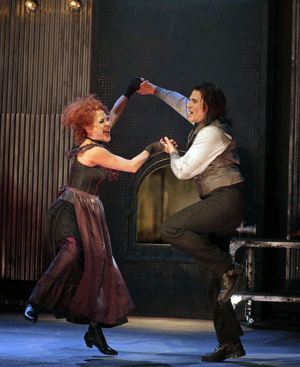 (L to R) Karen Ziemba as Mrs. Lovett and Rod Gilfry as Sweeney Todd
(L to R) Karen Ziemba as Mrs. Lovett and Rod Gilfry as Sweeney Todd
For OTSL has assembled as fine a cast for the Sondheim opus as is likely available today, and has placed them in a broodingly clever minimalist environs. Karen Ziemba is perfection as Mrs. Lovett, embodying the character with a truly unique sexiness, spunky child-like determination, and spot-on comic timing. Having admired Ms. Ziemba for years as a Broadway triple threat (Crazy for You, Curtains, Steel Pier) nothing in her past work could have prepared me for the depth, variety, and invention she brought to Nellie Lovett. Plus she has the chops to really sing the rangy part from the rolling chest voice to the fluty soprano flights that were written to Ms. Lansbury’s singular gifts. It is to her great credit that Karen emphatically makes the part her own, and along the way makes the demented, codependent love story and physical attraction really take flight.
Not that it is hard to imagine being physically attracted to Rod Gilfry’s barber, since he cuts a fine figure, even as he is revealed to be housing an intensely coiled, vengeful spirit. This is arguably the finest performance I have seen from Mr. Gilfry to date. His compact baritone managed to encompass the punishing demands of even St. Stephen’s most challenging writing, and while I have often heard him sing more suavely, never have I heard him sing more purposefully. Not once did he revert to flashing his generic, killer, Brad Pitt smile that seemed to define (and limit) his whole performance as last summer’s Glimmerglass Frank Butler. On this occasion he was nuanced, detailed, and frighteningly focused on his mission.
Arguably, the star vocal honors belonged to Nathaniel Hackmann’s superbly sung Anthony. The rich and ringing tone he brought to his paean to Joanna, the impassioned youthful spirits, the beautiful control on the hushed declarations of love, Mr. Hackmann regaled us with ravishing vocalism of the top tier. Add to the mix the fact that he is boyishly appealing, and you have, well, a definitive performance of the plucky lad (pace, Victor Garber). His accomplishment was ably matched by the enchanting chirping from his Joanna, Deanna Breiwick, who deployed her fluty, well schooled soprano to fine effect in Green Finch and Linnet Bird.
In a bit of luxury casting, acclaimed mezzo Susanne Mentzer made the most of her vibrant upper register and solid low tones to create an exceptionally wiry, aggressive Beggar Woman. Her physical abandon in defining the schizophrenic street person, combined with her vivid singing made this a memorable role assumption. Veteran Timothy Nolen struck just the right balance as the malevolent Judge Turpin, offering an understated model of control at one moment, and erupting with abusive authority the next. His compact baritone was put to good effect in the problematic Deliver Me, a rambling masochistic titillation which plays only marginally better in the opera house than on Broadway (where it was cut before the show opened).
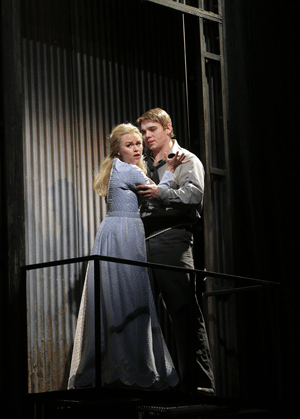 (L to R) Deanna Breiwick as Johanna and Nathaniel Hackmann as Anthony Hope
(L to R) Deanna Breiwick as Johanna and Nathaniel Hackmann as Anthony Hope
Scott Ramsay sang a wondrously secure Beadle Bamford. He was a good physical type to boot, if a bit too young for the character’s history. But the trade-off is that there is a freshness, clarity and bloom in Mr. Ramsay’s tenor that are enormously pleasing. The repeated falsetto’d “Ding Dong’s” in his parlor duet with Mrs. Lovett caused a ripple of delight in the audience.
Anthony Webb was also a mite too young to have fully lived the checkered past of Signor Pirelli, however, his skillful comic “Italian” accent and gleaming high notes gave much pleasure. Last but not least, Kyle Erdos-Knapp gave the kind of masterful performance as Tobias against which all future interpretations should be measured. After good duty with the (too) lengthy introduction for Pirelli, and then the sprightly contributions to God, That’s Good, Mr. Erdos-Knapp came into his own with a fully-realized rendition of Not While I’m Around. Here his attractive, confident lyric tenor proved a perfect match for the arching lines and soaring heights of the score’s best tune. We scarcely dared breathe as Kyle spun out ‘pianissimo’ musings of aching beauty. And he acts, too!
With Stephen Lord holding the baton, the Sondheim score (and Jonathan Tunick’s brilliant orchestrations) has never sounded better. However, since the decision was made to mike the singers, I do wish they had gone all the (Broad)way and done the same for the orchestra so the music shared the same ‘presence’ in the house. Final musical kudos go to the always commendable Gerdine Young Artists who formed the chorus and so effectively communicated the many tricky solo lines in the ensemble writing.
Without getting ahead of myself (but not wishing to repeat myself over four different productions), lighting designer Christopher Akerlind is a company treasure. His work on Sweeney was nothing short of brilliant (pun intended). The moody, menacing washes; the accurate tight specials; the roving spots; the uses of silhouette and back-lighting; the skill in keeping the soloists’ faces illuminated; the apt selection of color filters and gobos; this was a Masters’ Class in Excellence in Stage Lighting. And he repeated his complete success in all the other three productions this season. Bravo, Mr. Akerlind.
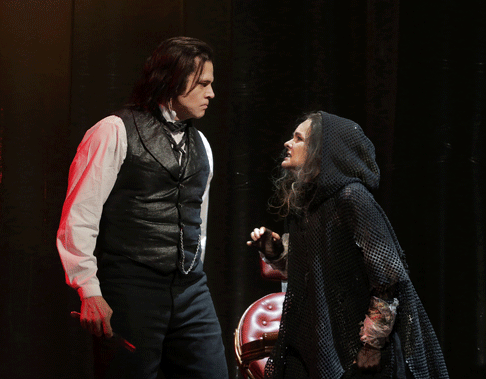 Rod Gilfry as Sweeney Todd and Susanne Mentzer as the Beggar Woman
Rod Gilfry as Sweeney Todd and Susanne Mentzer as the Beggar Woman
The entire physical production provided an artistically gritty environment, a visual realization of the de-humanizing effects of the Industrial Revolution, and disturbing parallel to the blackness of men’s souls. Riccardo Hernandez’s unit of corroding factory walls, dotted with bleak industrial lights, formed the basic playing space. With the addition of carefully chosen, highly specific set pieces, every locale was aptly suggested with great economy. Especially effective was the mid-stage, textured plastic curtain, edged with splotches of ‘blood,’ that was backlit. This imparted a surreal chiaroscuro scrim effect to such enactments as Lucy’s rape at the ball, and Joanna’s rescue from the asylum, among others.
Emily Rebholz contributed an array of appropriate costumes, from the raggedy street people, to the fading finery of the working middle class, to the richly appointed upper crust. For the Pirelli gathering as well as the asylum inmates, she has crafted giddily bizarre suggestions of an Edward Gorey fashion plate.
Ron Daniels‘ direction revealed meaningful character relationships through layered subtext and well-motivated blocking. His pointed use of the (Greek) chorus was blessedly unfussy. Perhaps his greatest success was in mining every last bit of humor from the grim tale and for creating a real physical relationship between his two protagonists. It has taken over thirty years, but for me here at last was a “Sweeney Todd” not only equaling the original, but in many ways surpassing it.
Lightening struck again the next night with the very best production of Cosi fan Tutte I have ever seen. Yes, ever. I will effuse momentarily about the uniformly splendid cast but first, the over-riding triumph here was the flawless direction from Michael Shell.
Mr. Shell not only found fresh ways to make the ‘usual’ schtick land (read: Despina’s and the boys’ disguises) but infused the first act with so many delightful comic surprises that the piece actually seemed new again. Have you ever laughed out loud at the soprano’s comic touches during Come scoglio? Ever? I certainly hadn’t. Yet there was Miss Miffed Thing, using the music’s scored dynamics to calculate over-reacting outbursts which make us giggle at, well, just how silly it really all is.
Similarly, Dorabella mined a wealth of giddy girlish faux protestations as she contemplated, and then munched, a cookie through half of Smania implacabile. (Despair? Maybe. . .oh-wait-there’s-food. . .) No clichéd oversize magnet for Dr. Despina in this version, nope, but rather a copper saucepan that she “rang” with a spoon like at a shivaree.
This interpretation also contained unambiguous sexual interplay with no doubt that the disguised suitors were out for instant gratification. One of the best (low) laughs of the night occurred when the guests first arrived and proffered “gifts” to the maidens. Held just below waist level, cloths that were covering the presents were whisked away in unison to reveal matching potted plants, each with a big pink cone-like flower protrusion just at the right ‘anatomical position.’ Mozart would have loved this. (And if he didn’t, to hell with him.)
Mr. Shell did let things settle down in Act II of course, and the seriousness and despair that set in were all the more profound for the romping fun that preceded it. Ditsy Dorabella goes with the flow but Fiordiligi cannot relinquish her feelings of betrayal, and at the finale she ultimately breaks from her ‘assigned’ lover to isolate herself center stage, confused and indecisive, an ingenious, plausible, and thought-provoking twist to the usual pat ending.
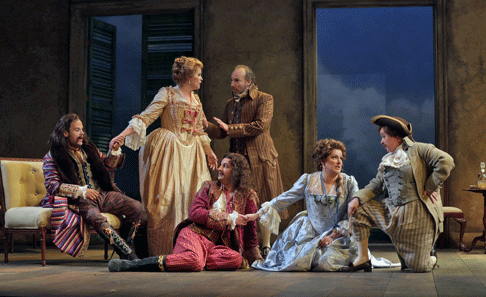 (L to R) David Portillo as Ferrando, Rachel Willis-Sørensen as Fiordiligi, James Maddalena as Don Alfonso, Liam Bonner as Guglielmo, Kathryn Leemhuis as Dorabella, and Jennifer Aylmer as Despina
(L to R) David Portillo as Ferrando, Rachel Willis-Sørensen as Fiordiligi, James Maddalena as Don Alfonso, Liam Bonner as Guglielmo, Kathryn Leemhuis as Dorabella, and Jennifer Aylmer as Despina
James Schuette has designed sumptuous period gowns for the two female lovers, eye-catching uniforms and exuberant ‘disguises’ for the two men, and elegantly functional period dress for everyone else. Doing double duty, Schuette’s handsome unit set becomes a multi-purpose drawing room, tavern, and garden as required, simply accessorized with chandeliers, plants, tables, and/or settees. The handsome wigs and lovely make-up were by Ashley Ryan.
Rachel Willis-Sørensen proved a radiant Fiordiligi, blond and imposing in stature, with an ideal Mozartean musical sensibility. Her heavy lyric voice has spinto leanings and the thrilling intensity in her top notes was matched by an even, creamy legato that encompassed the role’s considerable range. Ms. Willis-Sørensen‘s coloratura work was sprightly and accurate, her floated piano singing limpid and affecting, her dramatic outbursts focused and controlled. As an actress, Rachel took us on a complicated journey from defiant girlish loyalty, through weakening resolve, to profound doubt, to the depths of passion, to the end point of astonished betrayal. Quite a profound arc for a three hour opera!
No less detailed was the feckless, fickle Dorabella presented by Kathryn Leemhuis. I greatly admired Ms. Leemhuis‘s cheeky Zerlina in last summers Giovanni and she brought an even greater comic sensibility and emotional spontaneity to Cosi. As she reveled in her indecision, and demurely blew off the consequences of her actions, she also sang the part with utter confidence and a velvety mezzo that blended perfectly with her “sister.” The numerous melismatic passages sung in thirds by the duo were consistently, sinuously bewitching.
Jennifer Aylmer proved to be an unusually ripe-voiced Despina. Not merely a sassy, piping coquette, she; but rather a seasoned party girl with a vibrant, forthcoming, rock solid soprano. Ms. Aylmer‘s affected voices for the doctor (mock Yiddish) and the lawyer (sinus sufferer) were both well sustained and well considered, especially as she married them to the execution of some inspired, goofy physicality.
David Portillo and Liam Bonner were ideally cast as Ferrando and Guglielmo. The short/cute Mr. Petrillo and the lanky/dashing Mr. Bonner were an 18th Century Mutt and Jeff, making for many good contrasts and humorous interactions. David is possessed of a meltingly attractive lyric tenor, fresh, youthful, and pliant. The beautiful repose of his crystalline Un’ aura amorosa was one of the evening’s highlights, in a night that was crowded with musical excellence. Liam married a peacock’s vanity to a rooster’s strut, and conquered the part with a virile, responsive baritone of considerable power and thrust. His egocentric take on the soldier drove the action (and reactions) to good effect.
In the key role of Don Alfonso, it was a pleasure to once again encounter veteran James Maddalena, who has happily been a constant presence on the opera scene for over thirty-five years. His intelligent music-making and well-considerd acting were always in evidence. While I can’t report that his sturdy baritone is as fresh and responsive as it was thirty-five years ago, at this point in his career the instrument has compensated by assuming a warm, pleasingly grainy patina. As Cosi’s puppet master, he brings an assured and commanding presence to Alfonso’s machinations.
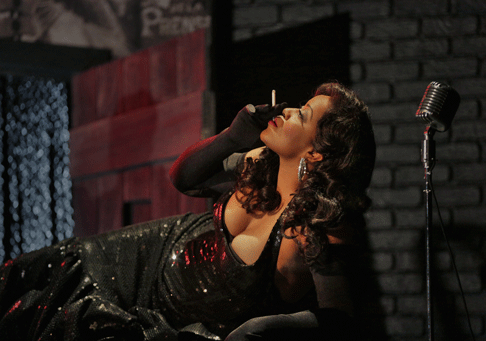 Kendall Gladen as Carmen
Kendall Gladen as Carmen
Jean-Marie Zeitouni not only led a taut, stylistically sound reading in the pit, but presided over a meticulously paced performance that never once allowed ser pieces to descend into self-pity or bathos. Never have I experienced a Cosi that unfolded so inevitably. This is not to suggest that the Maestro was all impetuosity and rushed dramatic gestures. The overall intensity of the forward motion was relaxed as merited to relish introspective watershed moments, that were made all the more effective for the change of pace.
OTSL’s other “standard fare” was the evergreen “bread and butter” favorite, Carmen. Director Stephen Barlow has re-imaged the classic as a ‘film noire’ and much of the concept reaped good dividends. Having a black and white old-time film projection of production credits during the prelude was a clever touch, and following it with a flash-forward of Jose getting arrested as Carmen’s body is carried away on a stretcher (leaving a white chalk outline on the ground) really established the genre (with a wink to Sunset Boulevard). So far so good.
But the plot points began to unravel quite quickly when there were no soldiers, but rather only a handful of policemen in a vacant lot in 1940’s Seville, backed by a cyclone fence upstage, in front of which was an indeterminate platform affixed with a billboard bearing an image of Carmen. Making José a police sergeant doesn’t quite work, and having the ragamuffin boys’ chorus be turned into Catholic schoolgirls playing hopscotch just doesn’t mesh with their singing of “playing soldier.”
I was bowled over by Paul Edwards’ stunning black and white period costumes. The scope, diversity, and sheer numbers of different looks created a movie-glamorous version of Spanish life. Would that his scenery had been as thorough or as imaginative. Lillas Pastia’s tavern made use of the same up center platform as Act One, with the addition of an upright piano and a beaded doorway stage left, a scattering of some tables and chairs, and a massive collage hanging up left center fronted by a neon “Pastia’s” sign.
For Act Three’s mountain pass, after a considerable pause to “change the set,” we were still in the same setting minus the piano and a few tables and chairs, and with the neon sign turned off but still discernible. Hmmm. For the street procession outside Act Four’s bull ring, we were back to the exact same setting as Act One, where the cigarette factory had been established as off up right. So. . .where was the bull ring? I guess, off left? With the entire visual effect quite meticulously contrived to be black and white, why choose to have Carmen’s Jimmy Choo’s be red? And why the red neon sign? And the red flower? Nothing in Act Four was red. The inconsistency and choices of these few uses of this one primary color was puzzling.
The floor plan also contributed to some blocking oddities. After the cigarette girls all entered up right behind the fence and established a traffic pattern around the full length of the fence to wind around it up left and spill into the main playing space, Carmen appears with them, and then enters on the platform, sidling around from behind the billboard. Is there a fence or not? And if not, why don’t some of the girls take a shorter path to the square?
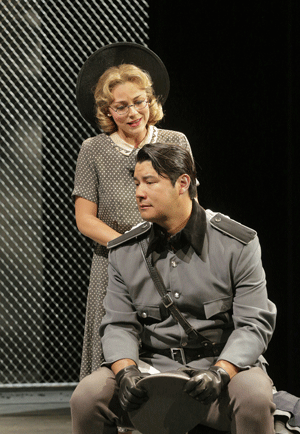 (L to R) Corinne Winters as Micaëla and Adam Diegel as Don José
(L to R) Corinne Winters as Micaëla and Adam Diegel as Don José
Okay, Mr. Barlow is trying to give her a star entrance, but it should make sense. He has created a number of nice stage pictures but has not always bothered to motivate movement. Why have Micaëla and José suddenly part down center only to re-position the girl right of the platform and him center of it just so she can cross back to him? Why have our Diva start Les tringles des sistres tintaient lounging atop the piano and work her way center, only to return her afterwards to her perch at the weakest visual position on the stage?
Other ideas scored big, like having Carmen and Escamillo driven on at the end of the parade seated atop a convertible, amidst a shower of glittering confetti from the flies. And, having José brutally and abruptly kill Zuniga, a premonition of his calculated execution of Carmen, shooting her even as he kisses and caresses her. And, devising real sexual menace in Micaëla’s first encounter with the townsmen. There is no question Mr. Barlow has manufactured some potent moments, even though has not yet knit all of his ideas into a unified whole.
Barlow is also credited with having created “new dialogues” to supplant Amanda Holden’s English translation. I am not sure the dramatic intent is well-served by intermittent insertion of Spanish words. As the tenor utters self-conscious phrases like “Tell me about mi madre” it seems like we are experiencing Berlitz-for-the-Clinically-Bewildered. Perhaps the overall stilted delivery of spoken lines was intended to evoke a film style but it must be said that the performers almost seemed to lose character when they stopped singing and started speaking.
Adam Diegel’s otherwise admirable José was perhaps most handicapped by his script. Having enjoyed Mr. Diegel in the past, it is a pleasure to note how much he has grown as an artist, even since last summer’s Glimmerglass Carmen. The tenor still commands an impressive ping on the full-voiced top notes, but has since begun to really explore more nuance and dramatic colorings throughout his range. His vocal embodiment of the obsessed soldier was now far more complete, with shadings and refinements that were wonderful to observe.
Like with most other tenors in this role, I do wish he could find a way to finesse the penultimate phrase in the Flower Song into a spun head voice, but since he chose to “Sing Out, Louise” I can report that he nailed it with controlled power. Adam has also learned to relax a bit more on stage, and there were moments of engaging, boyish charm between him and Micaëla. He could improve his impression in this opera even more by surrendering to a more passionate, sex-propelled hunger for the Bad Girl. Once this aspect of his interpretation is mined further, he will truly be a talent to be reckoned with in the part. Corinne Winters proved a memorable Micaëla. Every inch the darling “girl back home” (but did she need the bookish eyeglasses?) Ms. Winters created the tale’s most sympathetic creature and sang with a refined, glistening soprano that was especially luminous above the staff. The palette of vocal colors in her arsenal greatly enhanced communication and projection, especially the hint of round darkness in the lower range. Aleksey Bogdanov had all the moxie needed to voice a preening, pompous Escamillo. His tightly focused, riveting baritone made short work of the Toreador Song as well as the Act Three confrontation. He was marginally less successful with the gentler assertions of love in his final scene, for which his sizable instrument proved a mite clumsy. Bradley Smoak made more of an impression as Zuniga than I thought possible by affecting an authoritative presence, and singing powerfully with a straight-forward, burnished baritone of considerable beauty.
Gerdine Artist, Hernan Berisso impressed with his solidly sung Morales, his clean baritone and youthful demeanor making a substantial contribution. As Frasquita and Mercédès, Jennifer Caraluzzi displayed a polished, soaring soprano and Shirin Eskandani showed off a pleasing, pliant mezzo. Baritone Thomas Gunther (Dancaȉro) and tenor Michael Kuhn (Remendado) sang stylishly and securely. These four young artists made the most of their showcase in the famous quintet, although their scrubbed good lucks and well-tailored, sparkling costumes did momentarily suggest cast members of “Glee” as they might performGuys and Dolls. Never you mind, the success of these budding performers (and let’s throw in Nikolas Wenzel’s animated Lillas Pastia) demonstrates once again the importance and success of OTSL’s dynamic Gerdine Young Artists training program.
If any further proof is needed, Kendall Gladen as Carmen is a joyous “Local Girl Makes Good” story. Having been a former Gerdine Artist, the native St. Louisian has returned home in triumph. Ms. Gladen has an uncommonly rich, sonorous mezzo. Whether rising to the heights with ringing abandon, or descending into a searing chest register, she not only thrills us with the money notes but expertly blends her resources together for quite a seamless traversal of one of opera’s most famous heroines. Kendall has also captured the role’s (and I use the technical term here) Va-Va-Voom-Factor. She is statuesque, alluring, womanly, and stage savvy to boot.
And she has a sense of humor about Miss Carmen that is often in short supply, like when she calculatedly fluffs up her ta-ta’s in anticipation of the bullfighter’s Act Three arrival. With this performance, Kendall Gladen proved to be a beautiful, charismatic, vocally assured, musically gifted singer who has served emphatic notice that she is more than ready to become the world’s next “Carmen of Choice.”
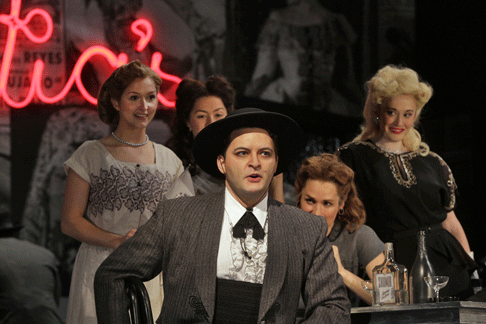 Aleksey Bogdanov as Escamillo
Aleksey Bogdanov as Escamillo
Maestro Carlos Izcaray kept everything moving along pleasantly in the pit, proving to be a collegial partner to his talented cast. Here, as in the other three works, Robert Ainsley’s well-tutored choral forces performed tightly, responsively, and intelligibly.
OTSL is to be roundly cheered for being such a consistent champion of new works. This summer brought the American premiere of Unsuk Chin’s Alice in Wonderland to a libretto by David Henry Hwang (in collaboration with the composer). As admirable as is this dedication to fostering new creations, it also brings with it considerable risk. And I am sorry to report, that in this case, the risk did not quite pay off.
First, the good news. Make that “great” news. The physical production could not be bettered. This was OTSL at the top of its game. Set Designer Allen Moyer has crafted a marvelous collection of rolling, oversized furniture that twists, turns, opens and closes to create all manner of magical transformations. James Schuette’s fanciful costumes include some of his finest creations, and as already mentioned, Mr. Akerlind’s superb lighting was at its most complex and most effective here. He was ably abetted by Greg Emetaz’s strikingly imaginative video projections that advanced the story and engaged our eye. Ms. Ryan went into overdrive and produced outlandish wigs and a make-up design that were beyond ‘sensational.’ And James Robinson tied it all up with a bow, directing a fantasy of incomparable invention with meticulous management of the assembled forces.
In the title role, petite Ashley Emerson was everything you imagined Alice should be, unleashing her slender, reliable soprano with aplomb. Tracy Dahl was a lovable Cheshire Cat, and her coloratura flights of fancy were awesomely accurate. In the dual roles of the White Rabbit and the March Hare, David Trudgen displayed an impressive counter-tenor of true distinction. Jenni Bank’s sturdy, characterful mezzo was well suited to the cheeky Duchess, and Julie Makerov’s stentorian, steely soprano was a good match for the domineering Queen of Hearts, while Bradley Smoak gave the night’s most varied performance as the King. Matthew diBattista was lovably effective as the dozing Dormouse. Perhaps the very finest vocal performance was given by Aubrey Allicock as the Mad Hatter, his spirited bass-baritone ringing out with gusto. There are far too many characters and fine accomplishments to mention but they were all first rate. So what is the “Bad News,” you may wonder?
Unfortunately, Ms. Chin has composed a score that just does not “sing.” To give her some due, there are many admirable orchestral colors, layers of sound, and attempted pastiches or recollections of different styles (Baroque, Bel Canto, Rap, etc.) but the writing sprawls and individual scenes wear out their welcome by churning on long after we have gotten the point. Characters are not adequately differentiated vocally, and there is not a ‘tune’ to be found. Conductor Michael Christie works tirelessly, and the assembled forces give it their all but. . .the closest thing to a successful moment is Alice’s brief lullaby to the baby pig. That is because all at once the arioso seems to want to please our ear rather than engage our intellect, and the brevity of the scene focuses our attention. Sadly, that was one oasis in an overlong evening of rambling aural inaccessibility.
I have seen too many Euro-trash productions to count, and at most of them I wish I could (and sometimes do) just close my eyes and listen to the music. In a turnabout, with Alice in Wonderland I wish I could have just watched the lavish spectacle and turned off the sound. For all Alice’s aspiration, hard work and promise, in the end we came out humming the scenery.
James Sohre
Sweeney Todd
Sweeney Todd: Rod Gilfry; Anthony: Nathaniel Hackmann; Beggar Woman: Susanne Mentzer; Mrs. Lovett: Karen Ziemba; Beadle Bamford: Scott Ramsay; Joanna: Deanna Breiwick; Judge Turpin: Timothy Nolen; Tobias: Kyle Erdos-Knapp; Signor Pirelli: Anthony Webb; Fogg: Marco Stefani; Conductor: Stephen Lord; Director: Ron Daniels; Set Design: Riccardo Hernandez; Costume Design: Emily Rebholz; Sound Design: Michael Hooker; Lighting Design: Christopher Akerlind; Wig and Makeup Design: Ashley Ryan; Choreographer: Seán Curran; Chorus Master: Robert Ainsley
Cosi fan Tutte
Ferrando: David Portillo; Guglielmo: Liam Bonner; Don Alfonso: James Maddalena; Fiordiligi: Rachel Willis-Sørensen; Dorabella: Kathryn Leemhuis; Despina: Jennifer Aylmer; Conductor: Jean-Marie Zeitouni; Director: Michael Shell; Set and Costume Design: James Schuette; Lighting Design: Christopher Akerlind; Wig and Makeup Design: Ashley Ryan; Choreographer: Seán Curran; Chorus Master: Robert Ainsley; Continuo: Fortepiano, Damien Francoeur-Krzyzek and Violincello, Melisse Brooks
Carmen
Morales: Hernan Berisso; Micaëla: Corinne Winters; Zuniga: Bradley Smoak; Don José: Adam Diegel; Carmen: Kendall Gladen; Mercédès: Shirin Eskandani; Frasquita: Jennifer Caraluzzi; Lillas Pastia: Nikolas Wenzel; Escamillo: Aleksey Bogdanov; Dancaȉro: Thomas Gunther; Remendado: Michael Kuhn; Conductor: Carlos Iscaray; Director: Stephen Barlow; Set and Costume Design: Paul Edwards; Lighting Design: Christopher Akerlind; Wig and Makeup Design: Ashley Ryan; Chorus Master: Robert Ainsley
Alice in Wonderland
Alice: Ashley Emerson; Young Boy: Trevor Scott; White Rabbit/March Hare: David Trudgen; Duck/Mad Hatter: Aubrey Allicock; Mouse/Dormouse/Invisible Man: Matthew diBattista; Caterpillar: James Meyer, clarinetist and Seán Curran, dancer; Duchess: Jenni Bank; Cook: Ashley Logan; Cheshire Cat: Tracy Dahl; Queen of Hearts: Julie Makerov; King of Hearts: Bradley Smoak; Conductor: Michael Christie; Director: James Robinson; Set Design: Allen Moyer; Costume Design: James Schuette; Video Design: Greg Emetaz; Lighting Design: Christopher Akerlind; Wig and Makeup Design: Ashley Ryan; Choreographer: Seán Curran; Chorus Master: Robert Ainsley
image=http://www.operatoday.com/ALICE_9.gif image_description=Ashley Emerson as Alice [Photo by Ken Howard courtesy of Opera Theatre of Saint Louis] product=yes product_title=Opera Theatre of Saint Louis 2012 product_by= product_id=Above: Ashley Emerson as AlicePhotos by Ken Howard courtesy of Opera Theatre of Saint Louis
Les Troyens, Royal Opera House London
The population of Troy delights in the spectacle, but then all hell breaks loose and the city is destroyed. David McVicar’s new production is similarly audacious. The orchestra roars full tilt. Even the instrumentation is extravagant — the ophicleide wails like a strange monster. Then the Horse looms into view, moving in a surprisingly realistic way. its eyes shining as if the creature were alive, which adds a poignant twist.
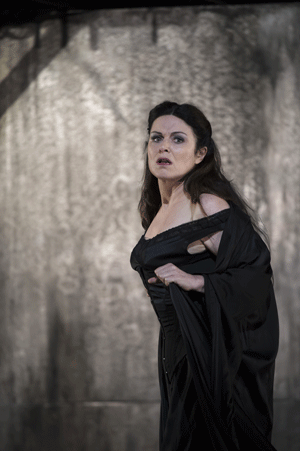 Anna Caterina Antonacci as Cassandra
Anna Caterina Antonacci as Cassandra
The Greeks and Trojans had much in common with the age of Napoleon III. David McVicar and his team (Es Devlin, Moritz Junge, Wolgang Göbbel) brilliantly capture the expansive, extravagant spirit of Berlioz’s time. France at its imperial peak, colonizing Africa and Asia. Paris was being rebuilt on a grand scale. Berlioz wasn’t doing history re-enactment but writing to stun Paris with its audacity. His orchestration isn’t the music of antiquity, but the most advanced and adventurous of its time. Berlioz isn’t doing history re-enactment, and his audiences interpreted Virgil through the filters of Claude and Poussin.
Grecian pottery depicts figures with minimal background: in Berlioz, the background is extreme and densely textured. The principals and secondary parts have to be strongly cast to stand out. Berlioz writes psychological depth in the music rather than in the text, so a strong casting and good direction are of the essence. At The Royal Opera House, the singing and acting was superb, thus expanding the spirit of the roles for maximum dramatic impact.
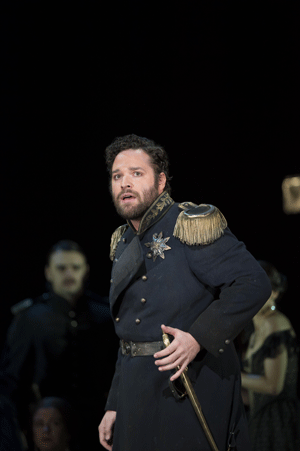 Bryan Hymel as Aeneas
Bryan Hymel as Aeneas
Anna Caterina Antonacci created the part of Cassandre with John Eliot Gardiner in Paris in 2003. She’s pitted, alone, against the hysteria in the chorus, and the militaristic violence in the orchestra, but her voice holds its own and soars through with dark intensity. Cassandre and Chorèbe (Fabio Capitanucci) are counterparts to Didon and Énée, but Eva-Maria Westbroek’s Didon and Bryan Hymel’s Enée were more than a match for the sheer passion of their characterization.
Eva-Marie Westbroek sang Cassandre in the Amsterdam Les Troyens in 2011 (Pierre Audi). She’s also a natural for the warm, happy Didon we see in Carthage (the desert city brilliantly depicted in multi dimensions so we get a sense of its teeming activity). This throws her portrayal of Didon’s extreme grief into sharp relief. When Westbroek sings of her anguish, the set is bare but for blue-grey curtain, the staging speaking for her as much as the orchestration. Westbroek’s such a sympathetic Didon, we feel her agony.
Bryan Hymel sang Énée in the Amsterdam production last year, and brings experience to the role. Anyone who bought tickets expecting Jonas Kaufmann would not have been disappointed. If anything, Hymel’s bright lyric tenor suits the part better. In the duet “Nuit d’ivresse et d’extase infinie!” he conveyed such beauty and sensitivity that he fleshed out the action man hero side of Énée, and the role became a real personality. Hymel’s Farewell aria was stunning, and ended with an exuberant flourish that was both heroic and tragic. The audience burst into spontaneous applause for the first time. Some audiences clap at anything, but this audience was far more sophisticated. You don’t do a demanding five-hour opera unless you really care. Hymel is still only 32, and has years of potential ahead.
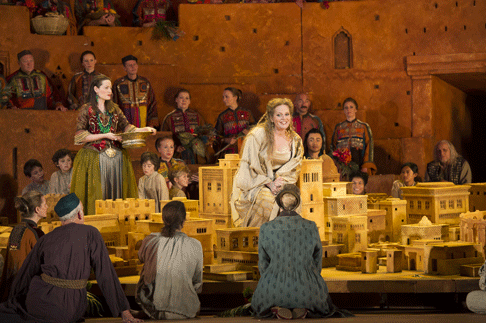 Eva-Maria Westbroek as Dido and Hanna Hipp as Anna
Eva-Maria Westbroek as Dido and Hanna Hipp as Anna
Brindley Sherratt’s Nabal was powerful, setting the opera in context. Duty, fate and tragedy, love cannot compete except in death. Also outstanding was Ji-min Park as Iopas, singing the plangently lovely “O Blonde Cérès”. Park is only two years out of the Jette Parker Young Artists Programme but a singer who should go far. Indeed, all the singing and acting was top notch, the entire cast on message, the chorus well blocked and expressive.
Coming from a background in Berlioz songs, I can’t bear the bombast some like in Les Troyens, but Antonio Pappano’s approach is more perceptive. He understand that what makes this opera work is its variety. Berlioz is flashing his virtuosity. The carnage music must be strident, but Berlioz writes music of surprising delicacy, and even humour. Pappano characterized the ballet scenes sensitively. These are important, not mere filler, for they set the context of the opera. Berlioz’s Paris audiences would have liked this exotic orientalism had they heard it, for it fitted their image of themselves as rulers of North Africa and beyond. Wisely, McVicar and his team used the exotic theme in the set, where the “world” (ie the model of Carthage) floats in a magical cosmos of blue, green and red light, illuminated by stars. Perfect union of music, staging and meaning.
This Berlioz Les Troyens is an experience no-one should miss. Alas, performances are sold out solid and you might have to pay way over the odds to get in. Luckily, it’s being filmed and will be in cinemas in November and hopefully out on DVD. it’s a milestone for the Royal Opera House and they’d be mad not to revive it soon. View it live on Mezzo TV on 5th July here and listen to the Proms semi-staging on 22nd July.
Anne Ozorio
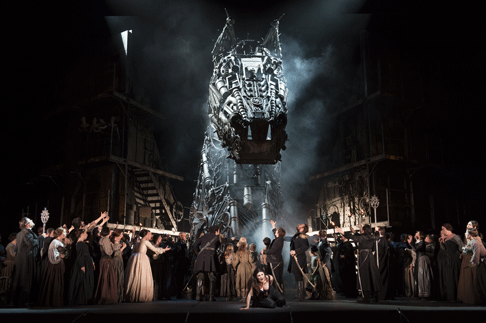 Scene from Les Troyens
Scene from Les Troyens
Photos by Bill Cooper courtesy of Royal Opera House
June 26, 2012
Dr Dee, ENO
A polymath whose knowledge and skill brought him political and financial reward and renown, but whose over-reaching ambition and fascination with alchemy and the occult brought about his downfall, Dr Dee is a good choice of operatic subject — and, as a celebration of man’s creative powers and a warning of the dangers of hubris, a fitting subject also for the Cultural Olympiad.
The libretto is episodic, as we witness Dee’s early studies and book collecting, his commission to identify the most auspicious coronation date for Gloriana, his love affair with Jane, a lady-in-waiting at the court, and his first steps into occult practices as he attempts to translate the Enochian language — literally the language of the angels. While the basic scenarios are made clear, often by visual aspects and the staging of the scene, the specifics of action, character and relationship are not sufficiently defined, reducing the potential dramatic tension as Dee’s pride and ambition lead him ever closer to conflicts with his faith and love, and ultimately to a fatal fall from grace.
There is much stylisation of image and choreography, often engaging but sometimes repetitive. Birdsong provides a frame, an aural evocation of the pastoral. A wordless pageant of embodiments of England and Englishness, accompanied by Albarn’s lyrical if rather shapeless pop vocals, traverses the raised gantry which houses Albarn’s musicians: a Doc-Martined, crimson-Mohicaned 70s punk is followed by a bowler-hatter 50s gent; Emily Pankhurst, Florence Nightingale, Wellington give way to Morris Dancers, as we move deeper into the past, culminating with the appearance Dr Dee himself. Such strategies can serve as economical and effective focusing devices. But why does each character in turn fling him/herself backwards from the gantry, pantomime style? A nudge towards English self-deprecation and irony, perhaps? Several flags of St. George flutter at the far end of the gantry: they later transform into the billowing sails which carry Dr Dee on his overseas missions, but initially they look like optimistic relics from Euro 2012.
There is no doubting Albarn’s genuine engagement with the eclectic idioms and musical sources which are juxtaposed in the score. Easy pop blends into pastiche Renaissance dance and song; African rhythms interrupt folk-derived modality. 16th and 21st centuries are juxtaposed and integrated; and, it’s true to say that the movement between them is pretty seamless. But, unfortunately, this is not generally because of formal dexterity but rather because the only thing that really distinguishes the idioms is instrumental colour and the odd harmonic ‘tint’ -a brief false relation or a tierce de Picardie. The melodic and harmonic language is unvarying and limited: progressions are repetitive and fairly stable, melodic phrases narrow in compass and confined in contour. Rhythmic repetitions cast a minimalist hue over the various musical shades. The result is that there is little dynamic drive within the music itself, and the work relies on vibrant choreography and technical effects for its forward momentum.
The voices are amplified (probably necessarily so, given the size and nature of the accompanying forces), with the result that they lose some of their individual character, and seem rather disembodied. Although there is some confident, focused singing from Anna Dennis, Katherine (Dee’s daughter) and Steven Pagel as Walsingham, only Christopher Robson — as Dee’s dark nemesis, Bishop John Kelley — demonstrated the ability to use the voice with real dramatic impact, faintly recalling Benjamin’s Britten vengeful, other-worldly Oberon. Paul Hilton works hard and with some success to impose himself musically and dramatically upon the action.
Despite this rather negative account, I would not deny that there are some impressive visual motifs and virtuosic dramatic climaxes. The technical team have created some pyrotechnic wizardry of which Dr Dee would himself be proud: strikingly animated geometrical, algebraic and cosmographical light-shows which conjure up the mythical expanse and thrilling enchantment of the Doctor’s knowledge and creativity. Set-pieces are similarly imposing: Elizabeth I is raised aloft, her gleaming golden dress, an icon of the Golden Age, draped like a gilded curtain, embracing and inspiring her kingdom.
But, effective motifs are sometimes over-laboured. Thus the concertina-like books which superbly suggest Dee’s thirst and capacity for limitless knowledge, are born in flight by the ensemble and literally seem to dance around the stage in the opening scene; but the passage is overly long, the routines endlessly repeated, underpinned by similarly repetitive harmonic patterns, as the books become larger — screens, carpets, walls. The simple motif gains nothing from such elongation and magnification.
Albarn has explained that while he was happy with the Manchester performance, “It’s never a problem to reassess because we have never said, ‘This is it’. And if it doesn’t work we can return or go down another path…But it will never be finished. I would sincerely like to have it translated into French, that’s my next ambition.” There’s certainly nothing wrong with revisiting and revising, but it feels to me that this work, which was still evolving 10 days before the ENO first night, wanders down rather too many paths without having a clear sense of the final destination.
Claire Seymour
image=http://www.operatoday.com/John_Dee_Ashmolean.png image_description=John Dee [Source: Wikipedia] product=yes product_title=Damon Albarn and Rufus Norris: Dr Dee product_by=John Dee: Paul Hilton; Katherine, Dee’s daughter: Anna Dennis; Kelley/Bishop: Christopher Robson; Walsingham: Steven Page; Elizabeth / Spirit: Melanie Pappenheim; Young Dee: Rebecca Sutherland; Young Katherine: Victoria Couper; Jane: Clemmie Sveaas. Musicians: Damon Albarn (vocals, guitar, harmonium); Ann Allen (reeds, recorders); Tony Allen (drums); Liam Byrne (viol); Mamadou diabate (kora); David Hatcher (reeds, recorders, viol); Arngeir Hauksson (lute, hurdy-gurdy); William Lyons (reeds, recorders); Mike Smith (keyboards). Co-creator/Composer: Damon Albarn. Co-creator/Director: Rufus Norris. Conductor: Stephen Higgins. Orchestra of English National Opera. Set Designer: Paul Atkinson. Costume Designer: Katrina Lindsay. Lighting Designer: Paule Constable. Video Designer: Lysander Ashton. Sound Designer: Paul Arditti. English National Opera, London Coliseum, Monday 25th June 2012. product_id=Above: John Dee [Source: Wikipedia]Miah Persson, Wigmore Hall
One of their earliest London concerts was built around their 2003 recording Soul and Landscape (Hyperion). Since then, Miah Persson has become one of the most significant lyric sopranos in this country. The pair have been back many times at the Wigmore Hall, but it was still a pleasure to hear them, particularly in repertoire that is “new” to English audiences.
Persson and Vignoles began their programme with Emil Sjögren’s Sechs Lieder aus Julius Wollf’s Tannhäuser, (1884). Not Wagner’s Tannhäuser but a setting of an epic poem written in 1880. As Geoffrey Norris writes in his knowledgeable programme notes, Wollf (1834-1910) liked subjects “of a mythical past…described somewhat derogatorily as Butzenzenscheibenpoesie, a Butzenscheibe being an old form of archery target”, like those round fake-archaic window panes we see in mock-historic pubs. Although I hadn’t read Norris’s notes until I started writing this piece, that’s exactly how I felt about the songs. Sjögren, (1853-1918) chooses sections that deal with love, and are sweet rather than dramatic. Don’t even dream of Wagner. These are songs that evoke late 19th century middle class values. “Ich möchte schweben über Tal und Hügel “ let Perssons sing very quietly. This Tannhäuser (or Elizabeth) is a gentle soul.
Tchaikovsky songs of the same period brought out Persson’s abilities as dramatist. In “Sred’ shumnovo bala” (At the Ball, op 38/3 1878), Tchaikovsky pains dance rhytms into the piano part, and pathos into the voice. The ball is cheerful, but the beloved eyes are sad. It’s a secretive song, but Perssons makes you notice the subtle ciontrasts of mood. “Solovey” (op 60/4 1886) stressed Persson’s voice slightly, but in “Cradle Song” (op 16/1 1872) she managed to convey the strange darkness behind this lullaby with images of eagles.
Five songs by Lars-Erik Larsson (1908-1986) to words by Hjalmar Gullberg followed. Larsson and Gullberg worked together frequently and their cantata “Förklädd gud” (God in disguise) is a staple in Swedish choral singing circles. (It’s even on YouTube). Larsson worked in broadcasting, so he appreciated music that would have broad popular appeal, even though he studied with Alban Berg and was the first Swedish composer to experiment with serialism. These songs, here transcribed for voice and piano, have charm, rollicking piano, and contrasting cleanly arching vocal lines. “Skyn, blomman och en lärka” (The cloud, the flower and the lark) was lit up by Persson’s ability to smile into her singing, adding warm tone. In “Kyssande vind” (the kiss of the wind), the piano rolls up a storm. Someone is stealing a kiss, disguised as the wind. The song ends with a flourish, and Persson sings with such happiness that you know the kiss is welcome.
More familiar songs by Edvard Grieg, in which Persson excels. “En svane” (op 252 1876) had the right hint of melancholy. Elizabeth Schwarzkopf’s recording, in German, is hauntingly beautiful, but the song is even lovelier in Norwegian. “Mens jeg venter” (On the water, op 60/3 1893-4) was particularly beautiful. Vignoles playing sparkled : you could visualize light shining off the ocean waves. “Bro, bro, brille” goes the refrain, and Perssons makes it joyous.
The highlight of this recital, for me, anyway, were the songs from Gösta Nystroem (1890-1966). Nystreom is one of the finest Swedish composers, whose “Sånger vid havet” (Songs by the sea), “På reveln” (At the reef) and “Själ och landskap” (Soul and landscape) are a part of the repertoire of any female Swedish singer. Miah Persson of course does those for soprano : Nystroem inspired her first major recording nearly 10 years ago. Here she chose two songs from Nystroem’s incidental music to “The Tempest” (1946). Give Nystroem’s fascination with oceans, it’s hardly surprising that the orchestral parts of this music are wildly turbulent, complete with wordless chorus. The two sings Persson and Vignoles pick refect the magical side of the story, “Where the Bee sucks” and “Come unto these yellow sands” (in Swedish) are exquisitely lyrical, capturing the strange magic that Shakespeare conures. The refrain “Hark! Hark! Bow-wow” becomes “Hallå, Hallå, Å”, whuch gives Nystroem a chance to write exotic ulullation, which Persson sings with clear, bright tones. Later, the refrain “Ding dong bell” becomes “Bing, bång, farväl”, and Persson’s voice rings like a silvery bell.
Perhaps one of the most famous of Gösta Nystroem’s works is his “Sinfonia del Mare” (1946-8) a magnificent symphonic poem with a song in its midst, to a poem by Ebba Linqvist. Arising from the wild ocean intensity of the music, the song seems almost supernatural. “Just as one flees the beloved, not bearing to be consumed”, goes the poem, “So I have fled the sea”. But just as life without love is in vain, the poet must leave sunny days in the forst, drawn back to “a sigh of the wind from the sea”. Persson and Vignoles do an arrangement for piano and voice, so the emphasis is on the second strophe. “I must return, and sit by the sea and know. That is all there is on earth”. This is the title of the poem, and its meaning.
Anne Ozorio
image=http://www.operatoday.com/m_persson_025.png
image_description=Miah Persson [Photo by Monika Rittershaus]
product=yes
product_title=Songs by Emil Sjögren, Peter Illych Tchaikovsky, Gösta Nystroem, Lars-Erik Larsson, Edvard Grieg
product_by=Miah Persson, soprano; Roger Vignoles, piano.Wigmore Hall London, 19th June 2012.
product_id=Above: Miah Persson [Photo by Monika Rittershaus]
Nicolas Bachler’s Contract Extended
By Frank Cadenhead [Opera Today, 26 June 2012]
Nicolas Bachler, intendant of the Bavarian State Opera, has had his contract extended through August 2018.
Bavarian State Opera Renews Nicolas Bachler’s Contract
The Bavarian State Culture Minister, Wolfgang Heubisch, recommended this at the Bavarian State Minister’s meeting on June 19 and it was approved that same day.
Heubisch praised him as “one of the most able managers in the opera world today.” He became general director in August 2008 and his tenure originally ran until 2013. Considered to be one of the top five opera houses in the world, this year it counted more than 513,000 attendees and the percentage of seats sold remained steady at 92%.
Despite shocking many in the audience with sometimes audacious stagings by avant-garde directors, Bachler is credited with expanding the artistic vision of the company and enhancing the Staatsoper’s already high international recognition. Culture Minister Heubisch’s engagement of Kent Nagano as music director was considered by many as a major coup. However, with Nagano’s upcoming departure, Bachler secured the services of young Kirill Petrenko to succeed Nagano in September of 2013.
Frank Cadenhead
image=http://www.operatoday.com/Bachler.png
image_description=Nikolaus Bachler [Photo © Markus Jans]
product=yes
product_title=Bavarian State Opera Renews Nicolas Bachler’s Contract
product_by=By Frank Cadenhead
product_id=Above: Nikolaus Bachler [Photo © Markus Jans]
Billy Budd, ENO
Indeed, we might start with what Alden’s reading of the opera is not. It is not a naturalist depiction of sea-faring life at a particular historical moment of naval conflict; nor is it an exploration of the psychological and emotional effects of the constraints and isolation on board a naval vessel in time of war. Crozier’s and Forster’s painstaking research into naval history — echoed in the surfeit of realistic detail exhibited in many productions of the work — is here eschewed in favour of a more universal time and setting (with nods towards modernism and beyond).
In fact, there is little even to suggest that we are at sea: the black leather trenchcoats sported by the officers and the sailors’ shapeless boiler suits are suggestive of an early-twentieth century fascist military and an industrial dystopia respectively, and the men cower beside a stark, steel edifice — more dystopian skyscraper than belly of a ship. Vere is worshipped by his crew, with naïve patriotic fervour, for his ability to blast the ‘Frenchies’ from the waters; but, clad in a debonair white suit and hunched over his philosophy books in his white tubular-shaped cabin, which resembles a futuristic office, he hardly convinces as a skilful naval strategist and veteran man-of-action.
Neither is Alden’s production really a classic Miltonic conflict, pitching the forces of good and evil. For this Billy, while exuberant and innocent, is not really a shining beacon of innocence and naivety: boisterous and prone to brawl, he does not quite rise to the heroic stature which would inspire his crewmates to insurgency in the moments following his death.
Moreover, while Claggart’s viciousness is clearly fed by his sexual desire for Billy — signalled, in case we had missed it, by his caressing of Billy’s scarlet neckerchief, which he clutches to his groin as he contemplates how he will annihilate this embodiment of beauty, handsomeness and goodness) — even the homosexual subtext of the opera (which draws upon the undefined homoerotic sub-currents latent in Melville’s text) is played down. For surely Vere is also disturbed and damaged by his love for Billy, a love which leads him to condemn Billy to death and himself to eternal remorse. And, while Forster rescued Vere, and his passion, in an Epilogue which transmutes Billy’s benediction, ‘God bless Starry Vere’, into an epiphanic Christian redemption, Alden avoids any crucifixion imagery during Billy’s hanging and brings the drama to a bleak close, the frail, elderly Vere juxtaposed with a blunt image of the brutal events he oversaw in a tableau which fuses the desolate present with the heartless past.
So, shunning both realism and the narrative equivocation which pervades both Melville’s novella and Britten’s score, what does Alden present us with? Not a ‘concept’ perhaps, but rather the depiction of a single mood - claustrophobic oppression — and the physical and emotional fear it engenders in both victim and persecutor.
This repressive ambience is forcefully generated by Paul Steinberg’s fore-shortened stage which forces the men into suffocating physical proximity where lashing violence is permanently on the point of erupting. And it is enhanced by lighting designer Adam Silverman’s dramatic oppositions of prevailing black obscurity and dazzling flashes of illumination.
Most forcefully, though, it is conveyed through the painfully slow movements of the massed seamen as they carry out their duties under the shadow of police baton and yard-arm gallows. Movement Director Maxine Braham ignores the huge rhythmic surges in Britten’s score which intimate both the powerful motions of the sea and the aching repressed emotions within the ship, in favour of severely constrained, stylised choreography: inch-by-inch the men haul a rope or scour the deck, the movements microscopic and quasi-ritualistic. At times this is effective: the injustice and horror of the final assault upon the mutinous crew by a truncheon-wielding militia is heightened by the cinematic slow-motion. Elsewhere, stage action and score seem incongruously at odds, as in the opening scene when the sailor’s propelling cry, ‘O heave’ — so suggestive of the muscular strength which shipboard life physically demands and of the emotional energy which must simultaneously be repressed — is answered visually by near stagnation.
As Vere, Kim Begley took a little while to warm up, and the slight tension in his voice during the Prologue did not help win sympathy for the Captain, who in this production often seems weak, even abhorrent, in his leadership of ‘The Indomitable’. But Begley got into his stride in Act 2: his physical portrayal of Vere’s mental agony during the trial scene was deeply affecting and the anguish of the closing Epilogue was finely portrayed, the slight dryness in the voice suggesting the waning of life and spirit. Benedict Nelson’s Billy was physically buoyant and nimble, freely waving his limbs in boyish exuberance, and shaking his flowing curls, in striking contrast to the rigid restraint of all those around him. But he lacked a similar sturdiness in the voice, and struggled at times to cut through the texture in his numbers with the chorus. However, ‘Billy in the Darbies’ was sweet and mellow, one of the opera’s few moments of intimacy.
Matthew Rose’s Claggart was fittingly satanic; called upon to oversee the arrival of three newly press-ganged recruits, he climbed ponderously and ominously from the belly of the ship like Hades rising from Tartarus. Poised, with rigid self-control, Rose’s dark bass chilled; the force of Claggart’s malignity was disturbingly expressed, as he communicated what Forster (in ‘What I Believe’) called the ‘something incalculable in each of us, which may at any moment rise to the surface and destroy our normal balance’.
All of the smaller roles were well executed. Jonathan Summers was an authoritarian Mr Redburn, immediately establishing his authority through voice and manner; Darren Jeffery as Mr Flint and Henry Waddington as Lieutenant Ratcliffe were similarly secure, projecting well. As the old sea dog, Dansker, Gwynne Howell excelled: he tenderly conveyed a weary wisdom and a true compassion — the latter a welcome touch of humanity in this community characterised by mercilessness. Nicky Spence’s Novice dramatically brought the fear and suffering shared but unvoiced by others into the open; he expressively shaped his vocal lines to expose the shame and self-pity of the flogged sailor. But, a minor point perhaps, visually he seemed much too advanced in years for a raw recruit whose lack of stoicism and self-control seem to suggest youthful immaturity and vulnerability.
Edward Gardner brought these competent parts together into an even more impressive whole; he truly understands Britten’s orchestrations and knows how to sharpen the dramatic characterisation through clarity of instrumental colour. Thus, the lyrical swoons of the saxophone deepened the sorrow of the Novice’s dirge and, when recalled at the close of Claggart’s aria of confession and avowal, indicated the master-at-arm’s unshakable hold over the young boy. Gleaming trumpet fanfares added a resonance of warfare and suggested Billy’s bright optimism; piercing piccolo squeals enhanced the emotional tension.
The large choral scenes were superb. Gardner whipped up a musical and military maelstrom during the pursuit of the French frigate which melodramatically opens Act 2, while subduing his forces in the singing of the sea shanties to achieve textual clarity and rhythmic buoyancy.
Overall, Alden’s reading is an interesting one, but lacking in something which lies at the heart of both Melville and Britten: ambiguity. Melville deliberately cultivated an air of inconclusiveness in both content and form, declaring, ‘Truth uncompromisingly told will always have its ragged edges’. Thus, the mists which literally spare the French ship from destruction and metaphorically cloud Vere’s vision, are never lifted. This production is just a bit too unequivocal and clear-cut.
Claire Seymour
image=http://www.operatoday.com/Melville.png image_description=Herman Melville product=yes product_title=Benjamin Britten: Billy Budd product_by=Billy Budd: Benedict Nelson; Captain Vere: Kim Begley; Claggart: Matthew Rose; Mr Redburn: Jonathan Summers; Mr Flint: Darren Jeffery; Lieutenant Ratcliffe: Henry Waddington; Red Whiskers: Michael Colvin; Donald Duncan: Rock; Dansker: Gwynne Howell; Novice: Nicky Spence; Squeak: Daniel Norman; Bosun: Andrew Rupp; The Novice’s Friend: Marcus Farnsworth; First Mate: Oliver Dunn; Second Mate: Gerard Collett; Maintop: Jonathan Stoughton. Conductor: Edward Gardner. Director: David Alden. Designer: Paul Steinberg. Costume Designer: Constance Hoffman. Lighting Designer: Adam Silverman. Movement Director: Maxine Braham. English National Opera, London Coliseum, Monday 18th June 2012. product_id=Above: Herman MelvilleClick here for a photo gallery of this production.
June 15, 2012
Salzburg face-off
By Frank Cadenhead [Opera Today, 15 June 2012]
It is an angry face-off between Alexander Pereira, the director of the Salzburg Festival and the festival’s board of trustees. The city’s mayor, Heinz Schaden. a member of the board, called Pereira’s threat to resign “absolutely unacceptable” according to the newspaper “Salzburger Nachtrichten.”
Opera Europa States Concerns
By Opera Europa [13 June 2012]
Opera Europa, the professional association representing 120 theatres throughout Europe, is greatly concerned by the developments which endanger the continuing existence of the Deutsche Oper am Rhein Düsseldorf Duisburg.
The Magic Flute in San Francisco
Maybe it’s those three boy sopranos who impeccably deliver the words and tones of Mozart’s three spirits and in their innocence make the hopes of mankind so real.
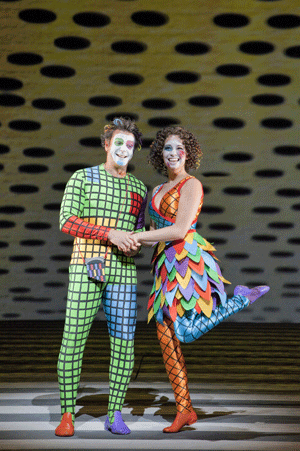 Nathan Gunn as Papageno and Nadine Sierra as Papagena
Nathan Gunn as Papageno and Nadine Sierra as Papagena
Maybe it’s the rhyming couplets of David Gockley’s new translation of the lyrics, and the rhythm and flow, and the internal and period rhymes of his dialogues that harmonize like square dance calls. It’s somewhere between cradle, pub and couch and makes you feel really good.
Certainly it’s the kaleidoscope of lines and dots and a thousand colors, maybe more that percolate across the proscenium canvas in always changing, never ending orders that make you feel that the good life will never end, and that, well, even if life may not always be that simple it keeps moving. Finally all those lines and all those dots will become a perfect circle!
This new Magic Flute is indeed a perfect circle, a masterpiece of conception and execution. There is even an illustrated book that engagingly documents the massive scope of a production process that traces the circle from idea to fact and makes artistic creation seem like a piece of cake.
Some of us like to think of San Francisco Opera as synonymous with Covent Garden and Vienna, like sharing productions with, uhm, La Scala (Attila for example) so it comes as a bit of a shock to realize that SFO is sharing productions with Omaha and Kansas City. In fact Japanese born artist Jun Kaneko, the creative force behind the sets and costumes of this production, makes his home in Omaha where he makes ceramics, conceives massive public art projects and designed Madama Butterfly for Opera Omaha.
San Francisco Opera has distinguished precedent for productions based on visual rather than theatrical art, like David Hockney’s Turandot, and even like Marc Chagall’s Magic Flute. And speaking of the Flute, South African artist William Kentridge created one for Brussels' Monnaie about a decade ago that set the benchmark pretty high.
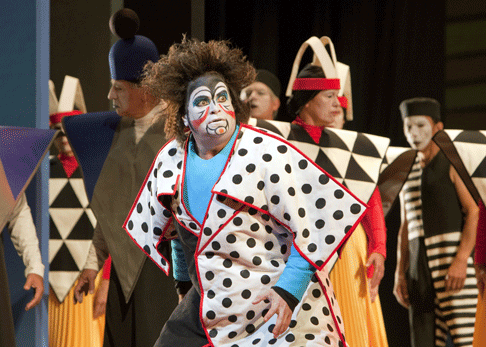 Greg Fedderly as Monostatos
Greg Fedderly as Monostatos
But middle America has its own things to say these days, like Picasso’s French Riviera had its things to say a hundred years ago at the Opéra de Monte Carlo. Maybe it says most about the America that looks westward to Asia for so much of its persona that remains so hidden. Artist Kaneko who emigrated to the U.S. in 1961 creates an endless landscape, like the American Midwest, but in Asian lines and colors. He constructs a Chinese puppet dragon and draws costumes that seem made of glazed clay or painted porcelain. In fact we felt quite at home as all of this is so much a part of our national heritage. Come to think of it.
Within this visual realm stage director Harry Silverstein finds constant movements and antics to enliven Gockley’s earthy contemporary banter. Things are left pretty basic, the cosmic conflict between Sarastro and the Queen of the Night has the weight of a domestic spat. It is taken for granted that women need to be put in their place, not to mention that people of color exhibit libidos that are not philosophic and that love conquers all obstacles, like fire and water.
Casting was young and fun. Rather than attempt the more usual and appropriate jugendliche dramatic voices for Tamino and Pamina, San Francisco Opera cast light lyric tenor Alex Shrader and soubrette Heidi Stober. The fine singers brought youth and lightness and consummate charm to Mozart’s young lovers, plus they seemed the very embodiment of corporate promise. Baritone Nathan Gunn was Tamino’s cool sidekick Papageno, everyone’s good friend who isn’t going to make it out of the warehouse.
Russian dramatic coloratura Albina Shagimuratova with her threatening accent (even if slight — she is an alumna of the Houston Opera Studio) was the appropriately toned Queen of the Night. Like nearly always this role gets the biggest ovation because she has the highest notes, and of course the niftiest arias as well. Mlle. Shagimuratova well earned her ovation with extraordinarily clean delivery of her stratospheric notes. Iceland born bass Kristinn Sigmundsson used his Germanic accented English to add more imperative to righteousness though vocally he no longer has the equipment to embody such depth and authority.
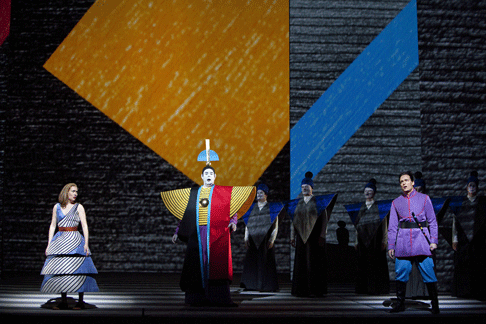 Heidi Stober as Pamina, Kristinn Sigmundsson as Sarastro and Alek Shrader as Tamino
Heidi Stober as Pamina, Kristinn Sigmundsson as Sarastro and Alek Shrader as Tamino
Baritone Greg Fedderly made Monostatos absolutely delightfully unthreatening, because as we all now know libido is fun after all. Mr. Fedderly is in good voice. Melody Moore Lauren McNeese and Renée Tatum were First, Second and Third Ladies, lighter voiced than the usual specimens, appropriate to convey the Valley Girl syndrome they knowingly managed.
Not least were the Three Spirits, Etienne Julius Valdez, Joshua Reinier and John Walsh who have to have been the best Three Spirits that ever hit the earth.
Where was the music in all of this, you ask. Well, we were having so much fun that we almost didn’t notice it. But when we did it seemed to support the words with grace and ease and the San Francisco Opera Orchestra did play with lovely sterling tone. British Conductor Rory Macdonald felt tempos that seemed quite slow, but they were tempos that allowed the words to sail across the pit and amuse us. Mozart’s ultimate symphonic thrust, the sublime musical process that propels Tamino and Pamina to an advanced humanity sadly did not happen.
Michael Milenski
image=http://www.operatoday.com/Flute-05.gif image_description=Albina Shagimuratova as The Queen of the Night [Photo by Cory Weaver courtesy of San Francisco Opera] product=yes product_title=W. A. Mozart: The Magic Flute product_by=Pamina: Heidi Stober; Tamino: Alek Shrader; Papageno: Nathan Gunn; The Queen of the Night: Albina Shagimuratova; Sarastro: Kristinn Sigmundsson; First Lady: Melody Moore; Second Lady: Lauren McNeese; Third Lady: Renée Tatum; Papagena: Nadine Sierra; Monostatos: Greg Fedderly; The Speaker: David Pittsinger; First Spirit: Etienne Valdez; Second Spirit: Joshua Reinier; Third Spirit: John Walsh; First Armored Man: Beau Gibson; Second Armored Man: Jordan Bisch. San Francisco Opera Orchestra and Chorus. Conductor: Rory Macdonald, Stage Director: Harry Silverstein; Production Designer: Jun Kaneko; Lighting Designer: Paul Pyant. War Memorial Opera House, San Francisco, June 13, 2012. product_id=Above: Albina Shagimuratova as The Queen of the NightPhotos by Cory Weaver courtesy of San Francisco Opera
Oliver Knussen’s Sendak operas launch the Aldeburgh Music festival
Where the Wild Things Are and Higgelty Piggelty Pop! are based on the books by Maurice Sendak, which presumably Knussen read with his daughter, Sonya. But Sendak’s books themselves spring from primeval sources. Nursery stories aren’t lullabies. They’re sinister. But children are fascinated. Perhaps when they go to sleep they need to be reassured that the dreams they encounter are just “stories” that they’ll wake from. Fantasy stimulates creativity. Knussen’s operas are for anyone of any age, who values imagination. Operas like these are good for our artistic (and mental) health. Britten wanted Aldeburgh to stimulate creative growth. Whether Knussen completes new work or not, he makes it possible for others to catch the spark.
In Sendak’s Where the Wild Things Are, a boy called Max is punished for dressing up as a wolf and escapes to a world of monsters. Sendak’s illustrations tell the story even more than the words do, so Netia Jones’s staging uses projections straight from the book. The staging’s not literal though, and incorporates the reality of theatre. Figures appear in silhouette and in ordinary clothes, but act and sing in character, so the video projections aren’t obscured. The orchestra can be seen clearly, so you can close your eyes and absorb the music, which is strikingly inventive. Four double basses and contrabassoon make the Wild Things roar, but Max (the vivacious Claire Booth) stands up to them. They look fierce but are rather cuddly. A bit like Knussen himself.
There were many children at the matinee I attended (ironically on what would have been Sendak’s 84th birthday), all of them attentive and well behaved. I asked two lads (8 and 11) how they felt. “I loved it when they appeared behind the screen” said one, while the other was fascinated by the instrumentation. They seem to have got a lot out of the experience. These are the kind of audiences we need, people who enjoy without prejudgement and respond imaginatively. Even when some children shouted, it added to the atmosphere.
Higgelty Piggelty Pop! was more subtle and communicated on many levels. It starts with a Pig-in-Sandwich Boards (Graeme Danby) offering ham sandwiches to those in the audience too young to appreciate the irony. The sandwiches also serve to keep the kids occupied when Jenny the Sealyham Terrier (Lucy Schaufer) sings a long, sophisticated aria, wondering if there’s “More to Life”. The projection behind shows the cartoon Jenny with a film of Schaufer’s mouth singing. Gradually voice and image begin singing different lines: fascinating, and musically astute. Jenny can’t get a job in the Mother Goose World Theatre until she gets “experience” whatever that might be. Whatever the Mother Goose World Theatre may be, for that matter. Logic is the enemy of imagination! Knussen fills the music with loony cross-references, like bits from Tchaikovsky and Mozart, barbershop quartets, brass bands evoking circuses. all woven into his distinctively intricate multi-layers. Like Birtwistle, Knussen loves mind games and multi levels. The effect is manic, the images anarchic, but the music is elegantly crafted, and played with complete conviction by the Britten Sinfonia, conducted by Ryan Wigglesworth.
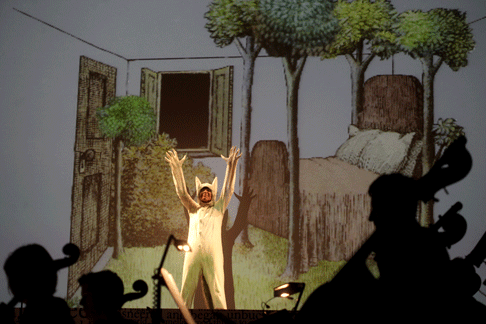 Claire Booth as Max in Where the Wild Things Are
Claire Booth as Max in Where the Wild Things Are
Jenny’s transported by a cat (Christopher Lemmings) in a milk float to nurse a baby with a savage, demented glare. At least on the Sendak illustration. The Baby (Susana Andersson) is an adult with a piercing scream. How can Jenny placate this beast? Sendak’s images may be pretend Victorian, but these aren’t Victorian values. The Baby’s Mother (Claire Booth) tells Jenny to let a Lion (Graeme Broadbent) bring the Baby back to her, and so the story ends happily ever after. Or does it? Three surprise “endings” to whip up excitement. It’s perfectly in order to laugh and clap as we emerge from the fantasy of the story to the fantasy of the mock toy theatre proscenium. Has Jenny, and have we, found the Mother Goose World Theatre?
This Knussen double bill will be repeated at the Barbican Hall, London in November, with Netia Jones’s multimedia presentation. Don’t be put off if you can’t go with a child. Go with the Child in Yourself, and benefit even more. Netia Jones’s Before Life and After comes to Aldeburgh from 20 to 22nd June and moves to the Cheltenham Music Festival thereafter. This is a show built round Britten’s Winter Words, Finzi’s A Young Man’s Exhortation and Tippett’s Boyhood’s End. James Gilchrist sings. It’s a tour de force.
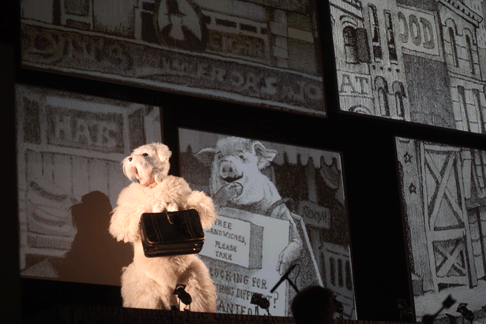 Lucy Schaufer as Jennie in Higgelty Piggelty Pop!
Lucy Schaufer as Jennie in Higgelty Piggelty Pop!
Oliver Knussen conducted the Scottish Chamber Orchestra the previous evening in a typically intricate puzzle of a programme. Charles Ives’s Washington’s Birthday, rather appropriate as Aldeburgh’s celebrating Knussen’s birthday this year. Diaphanous textures, exquisitely defined by this excellent orchestra. Very similar orchestration (harp and piano on concerto) to Alexander Goehr’s Marching to Carcassonne (2002 rev 2005) with Peter Serkin, with whom Knussen has been closely connected for many years. Serkin understands the Don Quixote spirit of the piece, where Knights march into battle but go round in circles, never reaching their goal. The harpist is Serkin’s Sancho Panza, the harp’s pedal held down so the strings play tautly, like a medieval stringed instrument. Goehr’s sense of humour, which Knussen has inherited. Surprise non-endings, as in Higgelty Piggelty Pop! Goehr was roundly applauded, and beamed.
Stravinsky’s Movements for piano and orchestra followed, and three movements from Alban Berg’s Lyric Suite, superbly played. We don’t hear the SCO nearly often enough in London (though there’s a lot about them on this site, as they are favourites). Then Geoffrey Norris appeared and presented Knussen with a Critics’ Circle award for Outstanding Musician. “But I didn’t finish the piece I was planning” said Knussen. It hardly matters. Quality is better than quantity, and there are many ways of being a true musician.
Anne Ozorio
image=http://www.operatoday.com/Sendak.gif image_description=Maurice Sendak product=yes product_title=Oliver Knussen: Where the Wild Things Are & Higgelty Piggelty Pop! product_by=Where the Wild Things Are — Max: Claire Booth; Mama: Susan Bickley; Moishe: Christopher Lemmings; Emil: Graeme Broadbent; Aaron: Jonathan Gunthorpe; Bernard: Graeme Danby; Tzippy: Charlotte McDougall.Higgelty Piggelty Pop! — Jennie: Lucy Schaufer; Baby/Mother Goose: Susana Andersson; Rhoda/Baby’s Mother: Claire Booth; Cat-Milkman: Christopher Lemmings; Pig in the Sandwich Boards: Graeme Darby; Lion: Graeme Broadbent. Snape Maltings, Aldeburgh, England, 10th June 2012. product_id=Above: Maurice Sendak
June 13, 2012
Attila in San Francisco
He did have some debts just then and patriotic operas were good box office in Venice so why not an opera about the barbaric general who scared the population off of dry land out into the lagoon that finally became La Serenissima.
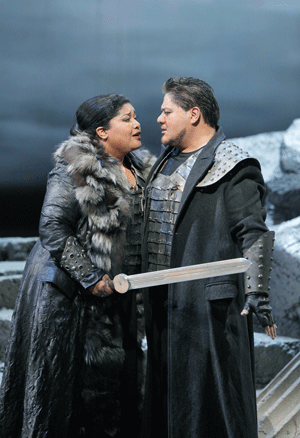 Lucrecia Garcia as Odabella and Diego Torre as Foresto
Lucrecia Garcia as Odabella and Diego Torre as Foresto
Attila is not big at the box office these days as there are too many better operas that attract and please the public and that better illuminate the Verdi genius as well. But it is Verdi, the early Verdi, and it is fiery music with hints of the late, great Verdi who ultimately created the Venetian general Otello. It is the Verdi who pushed singers to and beyond technical limits but not yet the Verdi who had transformed virtuoso voices into the complex dramatic personas that transcend mere technique.
So Attila is about voices, let’s start there. The real Attila the Hun was probably fairly young when he descended from Hungary as far as Rome (there is no recorded birthdate). It was the young American bass Samuel Ramey who took on Attila back in 1981 and made him his own of which there is much discography. The elder Mr. Ramey was just now on the stage of the War Memorial no longer as the Hun but as the bishop Leo who implores Attila to turn back. Mr. Ramey’s voice proves his long career, a still strong tone of now monumental wobble. But Mr. Ramey’s presence was obviously not to sing or be Leo but to be Mr. Ramey.
This formidable Italian bass Ferruccio Furlanetto is however in his prime, traversing Attila’s emotional poles and vocal treacheries with ease, reaching the high notes of its extreme range with force and security, descending to the suave tones that evoke the sexual allure of a powerful man. In better circumstances the tall, fit and heroic Mr. Furlanetto would have motivated dramatic tensions that lie just beneath the surface, and exploited the hints of Otello and Desdemona that lurk there.
International opera becomes ever more international, witness the fortunate discovery of young Venezuelan soprano Lucrezia Garcia. Mlle. Garcia was Odobella whose father had been slain by Attila and who married Attila. Mozart had already played with this situation in more obvious circumstances. However these hidden complexities were ignored in this San Francisco production leaving Mlle. Garcia as nothing more than a singer. The role is vocally formidable as was this singer who adds extraordinary agility to a powerful voice of real sweetness.
Mexican tenors have long since been discovered, so the discovery of tenor Diego Torre from Domingo’s L.A. Opera young artist program comes as no surprise. Mr. Torre brought security and strength to his vocal delivery of Odobella’s suitor Foresto, and his youthfulness added a bit of wanted charm to the opera’s most strident music (not in short supply). Verdi was never too kind to his tenors, usually finding them of questionable integrity, like Foresto, but Mr Torre was offered no opportunity to be more than a good singer.
Add to these two fine young singers Hawaiian baritone, Quinn Kelsey, a wonderful young singer who essayed Ezio, a Roman general who is the foil of Attila, i.e. he is the patriotic spirit of Italy. These days casting at San Francisco Opera seems to surround one big star with up and coming (at best) stars and with house singers, like Mr. Kelsey. This kind of casting often results in miss matching musical and/or histrionic styles, miss matching body types and over parting (a singer not yet or maybe ever able to take on a certain role). Pitted against Mr. Furlanetto My. Kelsey had no chance to deliver this proto-Verdi-baritone role with requisite force of voice or personality. His once famous second act aria of heroic resolution É gettata la mia sorte fell quite short of generating the excitement needed to unify Italy.
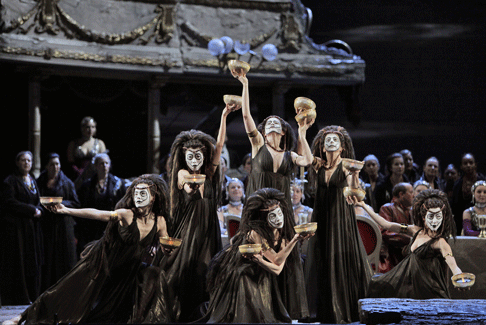 Act II of Attila
Act II of Attila
Not much can be known about the death of Attila in 453, though most certainly it was not at the hands of Odabella who in the opera saves his life so that she can kill him. Since this murder is pure fantasy anyway Italian film star and opera director Gabriele Lavia set the murder scene in a movie theater, complete with a screen on which Jack Palance was sacking Rome (the size and movement of the film images compelled our attention more forcefully than the miniscule by comparison singers — “what idiocy” was an overheard comment). But never mind as the second act was set in an opera house for some reason — maybe because Attila is an opera? The first act was the Roman amphitheater in Aquila and it looked just like the Arena di Verona where singers more or less line up across the front of the stage and sing.
Which is where maestro Nicola Luisotti likes his singers and Mr. Lavia seems happy to oblige. The maestro needs total control to impose his egomaniacal musicianship. It is effervescent, and seductive for a while, and this Verdi score obliges this maestro with the opportunity to be legitimately bombastic. The few moments of descriptive music offered by Verdi were overwhelmed by Luisotti’s penchant for effect. Effect for its own sake is a pitfall of this early Verdi opera that in its first years elicited the critical comments that began this review.
Michael Milenski
image=http://www.operatoday.com/Attila-03.gif
image_description=Ferruccio Furlanetto as Attila [Photo by Cory Weaver courtesy of San Francisco Opera]
product=yes
product_title=Giuseppe Verdi: Attila
product_by=Attila: Ferruccio Furlanetto; Odabella: Lucrecia Garcia; Foresto: Diego Torre; Ezio: Quinn Kelsey; Uldino: Nathaniel Peake; Pope Leo I: Samuel Ramey. Chorus and Orchestra of San Francisco Opera. Conductor: Nicola Luisotti; Stage Director: Gabriele Lavia; Set Designer: Alessandro Camera; Costume Designer: Andrea Viotti; Lighting Designer: Christopher Maravich. War Memorial Opera House, San Francisco, June 12, 2012.
product_id=Above: Ferruccio Furlanetto as Attila
Photos by Cory Weaver courtesy of San Francisco Opera
June 11, 2012
Così fan tutte, Holland Park
For the problem remains, as I have doubtless said far too many times before, Mozart’s music, and not just his operas, requires but one thing: perfection. It is the most unsparing music of all, with nowhere, but nowhere, to hide. Every note must be considered and sounded both in itself and in connection to every other. Place a wrong or even slightly excessive accent upon a single note and the fault will be glaringly magnified; misjudge a tempo, which is not to say that there is only one ‘correct’ tempo, and the entire apple-cart will be upset. However, conduct Così fan tutte like Sir Colin Davis — or rather, as Sir Colin Davis — and it is an experience that will remain with an audience for the rest of its life, opening doors one had never expected to be there in the first place.
Yes, the comparison is odious, but Thomas Kemp — a name new to me though his biography suggests considerable experience in houses across Europe and beyond — is no Colin Davis. I have heard worse, most obviously from the aggressively ‘authenticke’ brigade; Kemp did not seem actively to be trying to make Mozart’s music sound unpleasant. Nevertheless, on this evidence, he is not a conductor who could claim any particular or even general sympathy with Mozart. The opening bars of the Overture were taken far too fast; thereafter, far too many numbers never hit upon the just tempo. (It is worth repeating at this point that I do not for a moment think there is one ‘correct’ tempo; the trick is to make whatever is chosen sound right, to perform with conviction, sympathy, understanding, and of course, a sense of connection to a greater whole.) ‘Smanie implacibilie’ was breathless in quite the wrong way. Other sections of the score dragged, not so much because they were slow — I doubt that anything was as ravishingly, heart-stoppingly lingering as Davis would so often nowadays present it — but because the tempo seemed arbitrary, applied from without, with little connection to anything else, above all with little or no sense of harmonic motion.
The City of London Sinfonia played decently, though the strings could tend somewhat towards the anonymous. (At least they lacked the acerbic nature of a ‘period’ orchestra.) For the most part, as so often in Mozart, it was the woodwind section that most delighted; there was some fine work indeed here from a number of principals. The kettledrums, however, were often bizarrely prominent, not helped by the employment of hard sticks. Karl Böhm would have rolled in his grave.
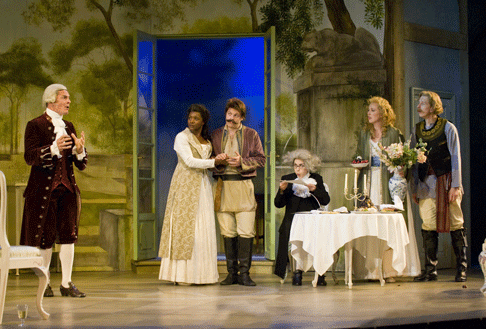 (Left-Right) Nicholas Garrett as Alfonso, Elizabeth Llewellyn as Fiordiligi, Andrew Staples as Ferrando, Joana Seara as Despina, Julia Riley as Dorabella and Dawid Kimberg as Guglielmo
(Left-Right) Nicholas Garrett as Alfonso, Elizabeth Llewellyn as Fiordiligi, Andrew Staples as Ferrando, Joana Seara as Despina, Julia Riley as Dorabella and Dawid Kimberg as Guglielmo
Had they been supported by a more sympathetic conductor, the cast of young singers would doubtless have appeared in a stronger light. As it was, there was nothing really to which one could object, but there remained a sense that things might have been better. (Perhaps that will dissipate during the run; first nights are rarely the best time to catch singers in particular.) Elizabeth Llewellyn, whom I admired greatly last year at Holland Park as the Countess, delivered what was probably the strongest performance overall, as Fiordiligi. The beauty of her tone-production could not be gainsaid, though her diction was sometimes, for instance in ‘Per pietà’, occluded. Julia Riley’s Dorabella sometimes lacked focus, though when that was achieved, showed considerable promise. Hers was a forthright portrayal, doubtless in part so as to achieve greater contrast with Fiordiligi, but was it sometimes excessively so? There second act duet between the two veered dangerously close to crudity on Dorabella’s part. Andrew Staples’s tone is very much of the ‘English tenor’ variety. I was not always convinced that this served Ferrando so well, but it is a very difficult role to get right; in other cases, often one ends up thinking the music sounds too close to Puccini. ‘Un’ aura amoroso’ was beautifully sung, though there were times elsewhere when greater presence might have been achieved. Dawid Kimberg’s Guglielmo was blustering, swaggering even, able to call upon considerable vocal reserves. Joana Seara offered a lively Despina, though her tuning sometimes went a little awry. Nicholas Garrett, 2010’s Don Giovanni, presented an intelligent portrayal of Don Alfonso.
What of the production? It was, for the most part, difficult to say anything much about it at all. I do not doubt that it would have pleased self-proclaimed ‘traditionalists’, since the costumes were all impeccably, almost aggressively, ‘period’ — if hardly Neapolitan. Of course, Così is in no sense whatsoever ‘about’ eighteenth-century Naples, but the logic of the literalist position is that it must be. It was difficult to detect in Harry Fehr’s production any idea of what Così might be about, any attempt to probe beneath its painfully beautiful surfaces, or even to celebrate the pain upon the surface. We had a ‘period’ set, ‘period’ costumes, and that was really just about it. There was a nod to directorial cliché in placing an audience on stage, supposedly ‘reacting’ to the events witnessed, but have we not seen that sort of thing far too many times before? Such framing can be interesting, even refreshing: I think, for instance, of Nicholas Hytner’s production of Handel’s Serse for ENO. However, if the intention were to highlight the artificiality of the drama — the artificiality is absolutely necessary to permit Mozart’s agonising psychological explorations — then it failed to come across; it appeared instead rather more as an attempt to generate stage ‘business’ in the absence of any other ideas. That is, until, part way through the second act, Fehr suddenly decided to add a few more, which jarred hopelessly given the uninvolving nature of what we had seen hitherto. Ferrando was laughed at by members of the ‘audience’: it might have been movingly cruel, yet here simply came across as an intrusion upon the music. Fiordiligi took off her dress, put on a soldier’s uniform — a very odd, quasi-literalist interpretation of her attempt to persuade herself to find her (erstwhile) lover — and then had that taken off by Ferrando. (No need to worry: there was plenty beneath the dress and the uniform.) Such ‘action’ merely came across as a realisation, too late in the day, that nothing much had happened. This is, of course, an extremely difficult opera to direct, yet Lloyd-Evans barely seemed to have tried.
Mark Berry
image=http://www.operatoday.com/Cosi2012-159a.gif image_description=Julia Riley as Dorabella and Elizabeth Llewellyn as Fiordiligi [Photo by Fritz Curzon courtesy of Opera Holland Park] product=yes product_title=W. A. Mozart: Così fan tutte product_by=Fiordiligi: Elizabeth Llewellyn; Dorabella: Julia Riley; Ferrando: Andrew Staples; Guglielmo: Dawid Kimberg; Despina: Joana Seara; Alfonso: Nicholas Garrett. Director: Harry Fehr; Designs: Alex Eales; Lighting: Colin Grenfell. City of London Sinfonia/Thomas Kemp (conductor). Holland Park, London, Friday 8 June 2012. product_id=Above: Julia Riley as Dorabella and Elizabeth Llewellyn as FiordiligiPhotos by Fritz Curzon courtesy of Opera Holland Park
June 9, 2012
Nixon in China, San Francisco
It was an uncanny fit in the War Memorial opera house, our residual banking and energy tycoons superimposed onto our tech billionaires, the old guard and the young Turks all sitting there in our stodgy old opera house mesmerized by a brash young opera (well, young relative to our 400 year old repertory).
Not to mention Nixon and Mao, Pat and Chiang Ch’ing, Henry and Chou. How many ways could composer Adams find to make two against three, four against three, everything over anything go together and not go together during the three fleet hours it took a virtuoso orchestra to navigate this treacherous score?
Over this but more so within this score lies Alice Goodman’s libretto that juxtaposes mind-boggling and mind-numbing banalities with metaphors of grace and intelligence and flights of lyricism that float in and out of comprehension and are the motor of the mind-bogglingly richness of energy and color, ebb and swell, the sure sonic embodiment of one of the more bizarre moments of human history. And finally what it means. This seems to be found in a few tiny moments of personal reminiscences that are nothing and everything.
Nixon in China is a masterpiece, and if you did not know what theory of binary opposition is at least now you know what it feels like.
Of course there is the back story of the West once again discovering the East, though it dims as time goes on. It is history that will be vaguely known by few of the new generation of opera goers. What really was is no longer of concern to this opera that seems to have joined Simon Boccanegra in the core repertory (36 productions worldwide in its 25 years of existence). Nixon in China is now an operatically consecrated human document, not an historical document.
Like Verdi, Adams knows that politics are loud, and Nixon in China was plenty loud, belying its relatively modest resources — only double or triple winds and a reduced string contingent. But Adams adds a chorus of saxophones to traverse musical prerogatives, plus some rare sharp percussive sounds to throw listener sensibilities off-balance. It was already the digital age back in 1987 so there is a synthesizer, and there is electronic manipulation of all natural instrumental and vocal sound. Get it? — Adams’ amplifies his voices and orchestra!
He is thereby able to insert Wagner’s apocalyptic resolution into Madame Mao’s ballet with a richness maybe known only by 110 players in Bayreuth. Luckily next up this spring is Verdi’s Attila with Maestro Luisotti so there should not be too much of a sonic letdown.
Masterminding this cold war götterdämmerung was Dutch conductor Lawrence Renes who imposed a sense of rhythmic precision that immediately gripped and never flagged over the duration, evoking sounds that made the excitement of space exploration in the late twentieth century as alive and provocative as its accompanying politics. It was masterful conducting.
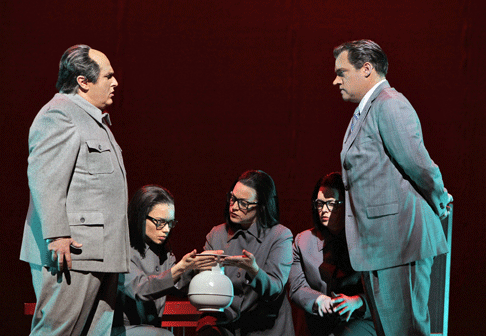 Simon O’Neill as Mao Tse-tung; Ginger Costa-Jackson, Buffy Baggott and Nicole Birkland as Mao’s secretaries; and Brian Mulligan as Richard Nixon
Simon O’Neill as Mao Tse-tung; Ginger Costa-Jackson, Buffy Baggott and Nicole Birkland as Mao’s secretaries; and Brian Mulligan as Richard Nixon
It was a cast of singers rather than singing actors. Some voices were larger than others, but with the help of sensitive sound design (amplification) all of these fine and beautiful voices melded magically with the sonorities created in the pit to create opera that was pleasing rather than provocative.
San Francisco Opera regular Brian Mulligan effected a fairly reasonable profile as Richard Nixon but captured nothing of the charisma of such a political personality. Tenor Simon O’Neill achieved a Mao of effective proportion though without messianic sense. Both soprano Maria Kanyova and baritone Chen-Ye Yuan are making a sizable careers as Pat Nixon and Chou En-lai having already performed the roles in many productions around the country. Mr. Yuan brings particular sensitivity and solidity to Chou En-lai. Patrick Carfizzi did not find a persona as Henry Kissinger though he provided good fun. Watch soprano Hye Jung Lee sing Madame Mao’s aria on YouTube, www.youtube.com/watch?v=IwHxvRJ_vPMto, to understand why she got the role even though she is way too young.
As in the recent production of The Death of Klinghoffer at the English National Opera the biggest and finest moments of lyric transport occurred not vocally but in dance. The relentless obscurity of the Alice Goodman libretto suspended, Adams unfettered by need to support vocal line, music and movement united to become one in the plight of the poor peasant girl, splendidly danced en point by ballerina Chirharu Shibata to the choreography of Wen Wei Wang, supported by her savior, dancer Bryan Ketron.
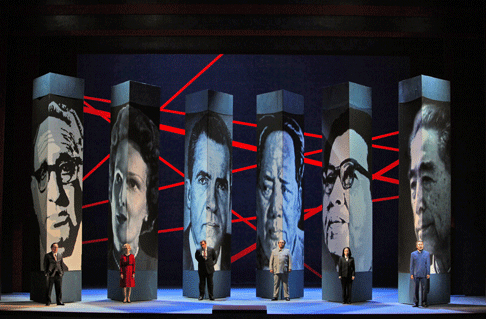 Patrick Carfizzi as Henry Kissinger, Maria Kanyova as Pat Nixon, Brian Mulligan as Richard Nixon, Simon O’Neill as Mao Tse-tung, Hye Jung Lee as Madame Mao and Chen-Ye Yuan as Chou En-lai
Patrick Carfizzi as Henry Kissinger, Maria Kanyova as Pat Nixon, Brian Mulligan as Richard Nixon, Simon O’Neill as Mao Tse-tung, Hye Jung Lee as Madame Mao and Chen-Ye Yuan as Chou En-lai
The performance was an un-nerving experience, exacerbated by the absence of its primary creator, Peter Sellers. It was after all his idea. It is inexplicable why San Francisco Opera eschewed the genius of this major American director for its premiere of one of the most important operas of the twentieth century.
As it was San Francisco Opera opted for a production from Vancouver Opera that most recently visited Kansas City. It is a fine, good looking production of theatrical savvy by Canadian director Michael Cavanagh. It is straightforward and workmanlike. It did not approach the opposites of the abstract, structuralist theatrical world of Sellers, Goodman and Adams.
Michael Milenski
image=http://www.operatoday.com/Nixon-2.gif
image_description=Brian Mulligan as Richard Nixon [Photo by Cory Weaver. courtesy of San Francisco Opera]
product=yes
product_title=John Adams: Nixon in China
product_by=Richard Nixon: Brian Mulligan; Pat Nixon: Maria Kanyova; Mao Tse-tung: Simon O’Neill; Madame Mao Tse-tung: Hye Jung Lee; Chou En-lai: Chen-Ye Yuan; Henry Kissinger: Patrick Carfizzi; Nancy T'ang: Ginger Costa-Jackson; Second Secretary: Buffy Baggott; Third Secretary: Nicole Birkland; Wu Ching-Hua (dancer): Chiharu Shibata; Hung Ch'ang-Ch'ing (dancer): Bryan Ketron. Chorus and Orchestra of San Francisco Opera. Conductor: Lawrence Renes; Stage Director: Michael Cavanagh; Set Designer: Erhard Rom; Costume Designer: Parvin Mirhady; Lighting Designer: Christopher Maravich; Choreographer: Wen Wei Wang. San Francisco Opera, War Memorial Opera House, June 8, 2012
product_id=Above: Brian Mulligan as Richard Nixon
Photos by Cory Weaver. courtesy of San Francisco Opera
L’olimpiade, Venice Baroque Orchestra
The Venice Baroque Orchestra brought to London their pasticcio, selecting 16 settings, organized around the original play.
Metastasio’s libretto, L’Olympiade was a popular choice for composers in the 18th century with settings by composers such as Caldara, Hasse, Vivaldi, Galuppi, Cimarosa, Paisiello and Cherubini. Donizetti even started a setting of it. The plot is the usual mix of co-incidences, mistaken identities and love thwarted. In fact the plot summary could be read as much as “Carry on up the Olympics” as an opera seria.
Whilst Vivaldi’s setting has received recent revivals, the Venice Baroque Orchestra under Andrea Marcon decided to explore the full gamut of settings of the libretto. At their concert at London’s Queen Elizabeth Hall on Monday 28 May they present a pasticcio made up of music from 16 composers. Pasticcios were common in the 18th century, with music taken from a variety of composers. The Venice Baroque Orchestra chose to present Metastasio’s libretto as he first produced it, ignoring the many changes that subsequent composers made. It was common to replace aria text and even to trim the recitative, so that for instance Vivaldi’s version of the opera makes significant changes to the aria texts.
The Venice Baroque Orchestra presented all of Metastasio’s arias but omitted all of the recitative. In the 18th century, a pasticcio would have recitative by a particular composer to bind the arias together. At the Queen Elizabeth Hall we had just the arias, linked by written plot summary.
We opened with Leonardo Leo’s sinfonia for his setting premiered in Naples in 1737, a short, no nonsense piece which displayed the orchestra’s wonderfully crisp, up-front playing. From then on we skittered through the next 50 years. Without the recitative it was difficult for the soloists to give a coherent sense of character given the variety of settings. For example Romina Basso as Megacle sang arias by Hasse (1756), Gassmann (1764), Cherubini (1783) and Jommelli (1761). It was difficult to grasp the feel of the complete operas, particularly as the styles of the settings varied from Caldara’s baroque setting, through galant and classical all the way to Cherubini.
This is where the logic behind the performance also fell down. In the 18th century a pasticcio would have had recitative and arias selected from a small group of contemporary composers, probably linked by style. Here we had no recitative and composers of a bewildering variety of styles. So it was as a concert, rather than an opera, that we have to think of this.
Basso as Megacle (one of the two male characters played by female singers), had a fine mezzo-soprano voice. Her opening aria, by Hasse, provided her with some suitably brilliant music which she executed quite superbly. However Basso had a rather odd performance style, rarely looking at the audience and waving her arms in the air in a strange manner. The result rather led to a strong lack of audience engagement, but her brilliant technical performance compensated to a certain extent.
The other male character, Licida, was played by mezzo soprano Delphine Galou. She opened with an aria by Galuppi from 1748, rather more early classical in style. Galou had a stylish delivery and an attractively dark, veiled voice. She went on to sing an aria by Vivaldi and a further one by Galuppi.
The two heroines were sopranos Ruth Rosique and Luanda Siqueira as Aristea and Argene. Rosique opened with an aria from 1786 by Paisiello in a lovely, expressive performance, following this with music by Gassman, Caldara (the libretto’s original setting), Leo and Piccini. Siqueira started with an aria by Sarti from 1778 in galant style, then covering music by Perez (written for Lisbon in 1753), Traetta and Pergolesi.
Tenor Jeremy Ovenden as Clistene had a series of high tenor arias, from Josef Myslivecek (a friend of Mozart’s), Jommelli and Cimarosa. Ovenden had a fine technique, a nice vibrant tenor with a free and easy top, he displayed little effort when it came to the tessitura of the arias.
Counter tenor Nicholas Spanos had a smaller role and displayed a rather careful technique in arias by Hasse.
One of the interesting things about the concert was the contrast between the various styles of the arias. We had galant music by Sarti, baroque music by Caldara and Vivaldi, late baroque style music by Traetta, music of an early classical feel by Jomelli, classical elegance from Piccini and of course a fully developed dramatic scene from Cherubini. Missing from the list, unfortunately, were Sacchini and Donizetti; it would certainly have been interesting to see what Donizetti made of it.
Hasse came out top with five items in the concert, showing how he was brilliant at writing elaborate arias which displayed voices at their best. The most intriguing was perhaps Traetta whose Act 2 arias for Siqueiria left me wondering what the remainder of his opera would be like. Another fascinating point was the way that composers from the classical period continued to write Da Capo arias.
In the programme book, Reinhard Strohm talked about the perfection of Metastasio’s work. A perfection that modern listeners often find it difficult to detect judging by the reviews of recent performances of Vivaldi’s L’Olympiade where reviewers have had difficulty taking the plot seriously. This is one of the problems with this genre, we have not yet learned to listen to settings of Metastasio’s texts. Contemporary ears have trouble finding balance and perfection and see only contrived co-incidences. Hasse in particular was strongly associated with Hasse, and most of the composers included in the evening would have regarded his libretto as a serious object worthy of setting.
The performances from the Venice Baroque Orchestra under Marcon were simply stunning. The orchestra had a fine technique, with a bravura feel to it which just asked to be listened to.
As drama, the performance was lacking. The programme probably works better as a CD than as a concert performance of an opera. But Marcon and his cast gave us a string of extremely fine performance which just made one sit up and listen.
Robert Hugill
Image=http://www.operatoday.com/Metastasio_vanMytes.gif
image_description=Pietro Metastasio by Martin Van Mytes
product=yes
product_title=L’Olympiade — Music by Caldara, Vivaldi, Pergolesi, Galuppi, Perez, Hasse, Traetta, Jommelli, Piccinni, Gassmann, Myslivecek, Sarti, Cherubini, Cimarosa and Paisiello
product_by=Megacle: Romina Basso (mezzo-soprano); Licida: Delphine Galou (mezzo-soprano); Aristea: Ruth Rosique (soprano); Argene: Luanda Siqueira (soprano); Clistene: Jeremy Ovenden (tenor); Aminta: Nicholas Spanos (counter tenor). Queen Elizabeth Hall, London, 28th May 2012.
product_id=Above: Pietro Metastasio by Martin Van Mytes
Don Giovanni, Garsington Opera at Wormsley
But regular patrons can do bland, corporate affairs any time. They come to Wormsley because they care about opera. This new production of Mozart’s Don Giovanni has a lot to offer to those who pay attention.
The Wormsley Pavilion is a wonder of translucent glass and gleaming metal. It inspires the set design by Leslie Travers. Simple, clean cut lines, stylish elegance. If Don Giovanni were alive today, he’d live in designer surroundings like this. He fits life into compartments, which the “boxes” in this set reflect. But as we know, things go awry. Under this surface glamour lurks something very nasty. Don Giovanni (Grant Doyle) and Donna Anna (Natasha Jouhl) act out bondage games. Naturally, she doesn’t want her father to know. She cuts Don Giovanni from his handcuffs, and he stabs the Commendatore (Christophoros Stamboglis). It’s not a conventional reading but valid. Don Giovanni gets his kicks from seduction, not rape in the modern sense, and those around him are complicit. Besides, Donna Anna’s feelings are conflicted. Her Don Ottavio (Jesús León) is rather alluring and comes over as real match for her. When they masquerade, she wears dominatrix, he dresses as muzzled dog, which expresses much about their relationship.
Because Garsington Opera uses relatively young singers, the production is energetic. Boyle’s Don Giovanni is quick on his feet (as is the character). Joshua Bloom’s Leporello radiates physical presence. Interesting voice, with good colour and range — definitely a future Don Giovanni. When Bloom sings the catalogue aria, he snaps out statistics rapid fire. He prints off a spreadsheet, and reams of paper fill the stage. Donna Elvira (Sophie Bevan) is dumbstruck.
While Natasha Jouhl’s Donna Anna is svelte and sung with richly controlled poise, Bevan’s Donna Elvira is more earthy, even endearing. This brings out the social commentary in the opera. Donna Anna’s is more posh, but she is trapped by her rank in society. She has too much to lose. Donna Elvira on the other hand, seems to be able to roam freely in pursuit of Don Giovanni and declare her feelings openly. Zerlina (Mary Bevan) is “a bit of rough”. Her wedding dress is more showgirl than country virgin, because she has aspirations. Think footballer’s wives weddings. She wants more than the underclass which Masetto (Callum Thorpe) represents, but she puts up with his violence because she has no option. Or perhaps, like a dirtier version of Donna Anna, because something in her draws her to the dark side Don Giovanni offers. Massetto and the villagers sing and move well. You can sense that this lot could riot and wreck Don Giovanni’s spotless cocoon of a penthouse, of they had a chance.
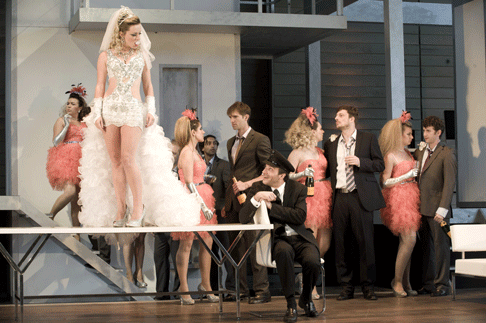 Mary Bevan as Zerlina and Callum Thorpe as Masetto
Mary Bevan as Zerlina and Callum Thorpe as Masetto
But retribution strikes when the Stone Guest comes to dinner. A corpse resembling the Commendatore is wheeled in on a hospital table. This looks much more like a marble statue than some depictions, and close to text. The inscription is written on a tag. While Don Giovanni and Leporello examine the corpse, a voice booms out from high above the stage, as Stamboglis sings. They can’t see him, but we can. Wonderfully surreal. We don’t need to see Don Giovanni literally dragged down to hell. He drops dead and falls into the same wheelchair with which the Commendatore’s body was removed at the start of the opera. Perfect symmetry. More controversially, Donna Anna caresses Don Giovanni’s corpse. Her emotions are complex. This implies more than a simple happy ending. The Edition used in this production is Barenreiter-Kassel, edited by Wolfgang Plath and Wolfgang Rehm.
Anne Ozorio
image=http://www.operatoday.com/DonGiovanni_Garsington2012_002.gif
image_description=Sophie Bevan as Donna Elvira, Grant Doyle as Don Giovanni and Joshua Bloom as Leporello [ Photo by Mike Hoban courtesy of Garsington Opera at Wormsley]
product=yes
product_title=W. A. Mozart: Don Giovanni
product_by=Don Giovanni: Grant Doyle; Leporello: Joshua Bloom; Donna Anna: Natasha Jouhl; The Commendatore: Christophoros Stamboglis; Don Ottavio: Jesus Leon; Donna Elvira: Sophie Bevan; Zerlina: Mary Bevan; Masetto: Callum Thorpe. Conductor: Douglas Boyd. Director: Daniel Slater. Designer: Leslie Travers. Lighting: Bruno Poet. Garsington Opera at Wormsley, 4th June 2012.
product_id=Above: Sophie Bevan as Donna Elvira, Grant Doyle as Don Giovanni and Joshua Bloom as Leporello
Photos by Mike Hoban courtesy of Garsington Opera at Wormsley
Duisburg Petition Drive Proves Strong Support for Local Opera
The primary issue of governmental monetary support reached a crisis point on May 2nd, when Duisburg’s administrative board recommended terminating a partnership that has been in place since 1956 with the Dusseldorf company. It was publicized that approximately one hundred Duisburg performances per year would be cancelled, starting in the summer of 2014.
Primary concerns voiced in regarding to the potential cuts ranged from the huge impact on Duisburg’s Philharmonic Orchestra to a loss of numerous student or youth based programs, and the general decline of the community’s cultural foundation.
A packed performance hall included a range of patrons from well heeled season ticket subscribers to cheap seat, student rush types. Cultural Experts on hand to present and discuss information included Professor Werner Lohmann, President of the NRW National Music Council, and Dr. Christian Esch, Director of NRW Cultural Affairs.
A petition drive to save and continue current production schedules has reportedly gathered over 28,000 signatures in four weeks. At that rate, the entire city may have signed by the next “commission for culture” meeting, set for June 25th. This is still, indeed, a developing story.
Ideally, the many supportive voices raised will prevail as clearly and true as those regularly heard on the dual stages of Deutsche Oper am Rhein. It is sometimes difficult to remain optimistic under current budgetary conditions and it seems like all bets are off these days in EU financial projections. Hopefully, this musical tale of two cities will conclude without dramatic losses for either performers or their audience.
By Phillip Woolever
For related stories, see:
Berlin's Struggling Artists Demand Share of the Pie
Uwe Eric Laufenberg Resigns
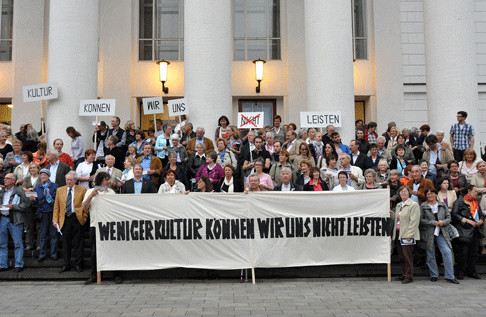 Photo by Frank Heller
Photo by Frank Heller
June 8, 2012
Almira, operamission
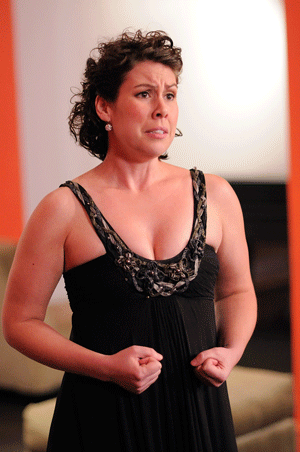 Christy Lombardozzi as Almira
Christy Lombardozzi as Almira
That latter stat defies all the rest just now: Small opera companies are thriving. My post-Met-season has included Holst, Telemann, Richard Strauss and De Falla; Rossini, Gay, Rachmaninoff, Chabrier and Saint-Saëns lurk in my near future; and now the American professional premiere of Handel’s tyro effort, Almira (1705), has been presented by a youthful group called operamission, providing four hours of pleasure for any Handelian who chanced through the Flatiron District.
Almira was composed by the 19-year-old Saxon who had not yet gone to Italy to have his rough edges planed, for Hamburg’s Theater am Gänsemarkt, the largest and grandest private opera house in Northern Europe, which for a quarter century had been importing works by the likes of Lully, Cavalli and Steffani and “improving” them to the taste of that rich and sophisticated imperial free city, no egotistical royal court being around to interfere. An entirely homegrown school of opera-making had arisen to exploit this setting. Among its charms was a rear wall that could be opened after the celebratory conclusion of a performance for a fireworks display on the River Elbe.
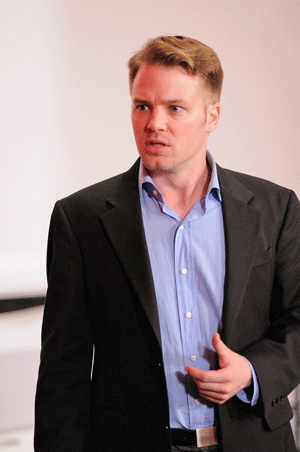 Michael Weyandt as Fernando
Michael Weyandt as Fernando
Some Gänsemarkt operas (such as Telemann’s Orpheus, recently given its New York premiere by the City Opera) mixed two or three languages, and the local style was also mongrel in the extreme. There was, if operamission’s Almira is exemplary, far less egotism, less of artists so confident of audience adulation that they stepped out of character to over-ornament the dramatic event. That is the direction opera took in Italy (and, under Handel’s auspices, would move in England), but it had not come to Hamburg. The stories enacted were long and foolish, but the pace was swift, and young Handel was already a tunesmith to rank with the best. The merchants of Hamburg got their money’s worth and so, three hundred years later, did we.
Another local peculiarity in Hamburg was the absence of the Italian custom of using castrati. Heroes and villains were generally sung by tenors and basses, which made the operas a little easier for later generations to perform and to accept—the program for this Almira calls it “the only Handel opera staged during the nineteenth century.” (In Hamburg and Leipzig, “severely truncated.”) Today, however, the lack of male altos or women in trousers may be a hard for the contemporary audience for baroque opera to swallow when attending Almira. Sorry: Tenors and basses is what we got here, though they are required to be considerably more flexible than the male singers of the nineteenth century would be.
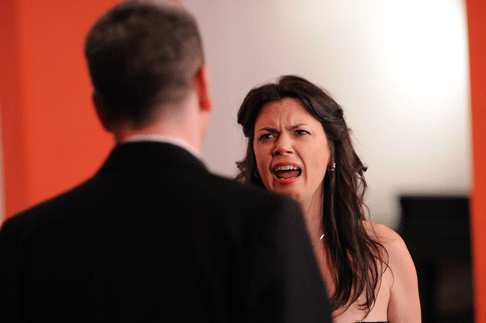 Keith Jameson as Osman and Nell Snaidas as Edilia
Keith Jameson as Osman and Nell Snaidas as Edilia
Almira, Königin von Kastilien (Almira, Queen of Castile) mixes languages (German and Italian—the libretto is a bit of a hodgepodge) and styles with bits of plot derived from many sources. Winton Dean, the grand authority on Handel’s operas, sounds impatient with it in his study of Handel’s operatic oeuvre, condemning him for not deepening the characters or straightening out the story with its coincidences and contingencies, letters gone awry, confessions overheard and misunderstood. To the lover of Handel’s mature output, however, the score is frankly astonishing for what it does achieve, the way the young genius contrasts his sets of rival lovers in their rival clichés, the way the grandeur demanded by audiences in wealthy Hamburg was worked into the story in procession and dance, the way the manners of the different source schools (French, Italian, German) were maneuvered to create a more or less seamless piece of theater and, most of all, the flood of melody already at his command. To expect the more personal maturity of his greatest works would be churlish. Almira is a delight on its own terms, and its own terms (minus gaudy costumes and sets) are how operamission takes it.
The lobby of the Gershwin Hotel on East 27th Street (right beside the Sex Museum, you can’t miss it) is a tall room. The 21-piece band of original instruments, recorders, valveless horns, baroque bassoon, cello, harpsichord—was that a viola da gamba joining in the recits?—is stuck at one end of the L-shaped playing space, which permits double doors to open for grand entrances, and there’s some room for court dances by a tiny corps de ballet.
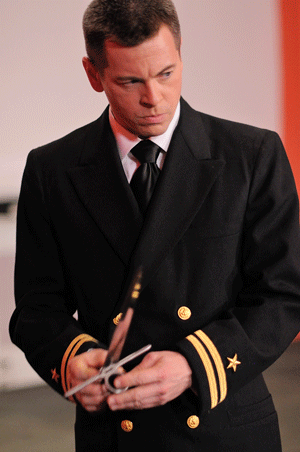 Keith Jameson as Osman
Keith Jameson as Osman
A single lobby pillar did duty as a tree, an arras, all sorts of concealing partition. The audience had the remainder of the room, so some head-swiveling to follow the action was required. Not the least of the pleasures of the occasion was the absence of titles of any kind. A detailed synopsis in the program included the texts of all the arias (both sung and translation) and the lights were up (as in Handel’s day) so that they could be read, but comprehension of the complicated and unfamiliar plot was left to the expressiveness and acting chops of the singers. None of them had any trouble getting the story across. Free of blinking and distracting translations, we could revel in music and its performance. I do hope operamission retains this tradition.
In brief, Almira (Christy Lombardozzi), newly-crowned Queen of Castile, is in search of a husband. She inclines towards the foundling Fernando (Michael Weyandt) who is, in fact, in love with her, but for typical libretto reasons she thinks he’s in love with her cousin Edilia (Nell Snaidas). This confusion is encouraged by underhanded Osman (Keith Jameson, whom you may recall as the Apprentice in the Met’s recent Billy Budd), who is Fernando’s foster brother and has been flirting with Edilia himself, all of which goes by the board when he hopes to attain the crown matrimonial. His father, the regent Consalvo (Mark Risinger), hopes to marry the queen off to a man of proper birth, that is, not Fernando. That would be more than enough plot for the mature Handel (when he was hiring imported Italian singers for his own company), but on the Gänsemarkt’s thaler, he added Bellante (Kristen Plumley), who is also in love with Osman and therefore spurns Consalvo’s antiquated flirtations, and a Mauretanian king, Raymondo (David Kravitz), who hopes to woo Almira but, happily, falls for Edilia instead. All we need for denouement is the discovery that Fernando is of noble birth, a long-lost son of Consalvo’s, and all three couples may marry—and do.
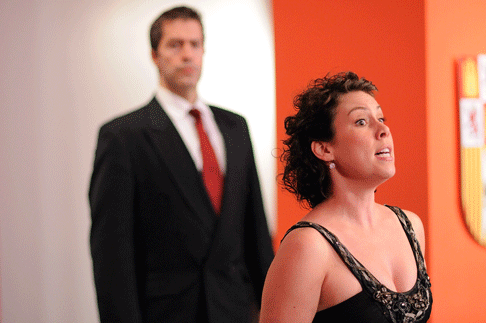 Mark Risinger as Consalvo and Christy Lombardozzi as Almira
Mark Risinger as Consalvo and Christy Lombardozzi as Almira
These regal types, honorable or otherwise, are served by Tabarco (Karim Sulayman). The sarcastic servant is another Gänsemarkt tradition (as those who attended Conradi’s Ariadne in Boston will recall); he extols gold and drink, doubts everyone’s high-flown sentiments, cracks wise about insincere young lovers and ridiculous old ones, attempts blackmail and information leakage, and generally cuts the exalted brew. His lineage is actually very exalted, for he traces his ancestry to Pseudolus, Mosca, Juliet’s Nurse, Hamlet’s gravediggers and Sancho Panza, and his operatic descent is grander still: Mozart’s Leporello and Papageno, the Sacristan in Tosca and the Noctambulist in Louise. We need him to remind us (and the other characters) what planet we live on. It isn’t just highfalutin planet opera, or not all the time.
To find a singer or two worthy of attention and able in practice in one of these small companies is nothing unusual; it is one of the joys of going to them. To find eight excellent singers in eight wide-ranging roles in such a company is astonishing, but that was the case with operamission's Almira.
There are three sopranos here, you will note, and (like all characters in opera seria), they are obliged to offer arias of a variety of states of mind: yearning, wrath, flirtation, outrage, tragic renunciation. Operamission’s music director, Jennifer Peterson, who conducted from the harpsichord, figured out how to vary the voices nicely, from Lombardozzi’s long, pure lines of queenly suffering to Snaidas’s high, spiky staccati of merriment or anger and Plumley’s gracious or dubious sentiments. Considering how interchangeable were their feelings (each lady feels amorously misused by someone or other), they individuated nicely.
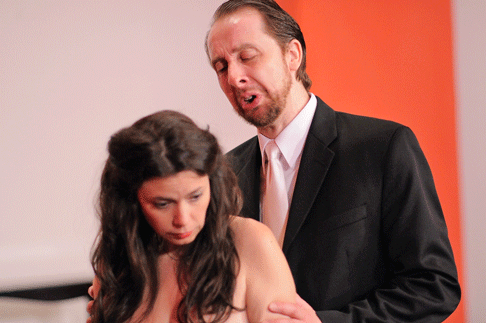 David Kravitz as Raymondo and Nell Snaidas as Edilia
David Kravitz as Raymondo and Nell Snaidas as Edilia
Square-shouldered and handsome, Michael Weyandt ably deployed his agile baritone to proper stone-faced Dudley Do-Right effect as Fernando, the all-but-uncomplaining (ten arias) object of everybody’s plots and betrayals. Keith Jameson, as his devious brother Osman, had much more fun, skulking and conniving. His tenor seems a bit grainy for leading lover roles in any case, and his stage personality thrives on shifty characters. Mark Risinger sang the grandee Consalvo with poise and dignity but did not quite convince as a despairing lover. David Kravitz’s Raymondo was all sly politician until Edilia stole his heart, when his lyric bass found a warmer element. Karim Sulayman, who specializes in wisecracking servants (I’ve seen him with Vertical Players and Opera Lafayette) had more fun than anybody; plot shenanigans never unsettle his enjoyable light bass. I’m not sure which I’d look forward to more: His Leporello or his Osmin (in Seraglio).
The staging by Jeff Caldwell made witty use of an awkwardly shaped stage and less than grandiose forces to keep us on the proper page of the plot and happy with its impressive length. This was a performance without a single mis-cast singer or actor in eight long roles, which makes one eager to hear whatever operamission comes up with.
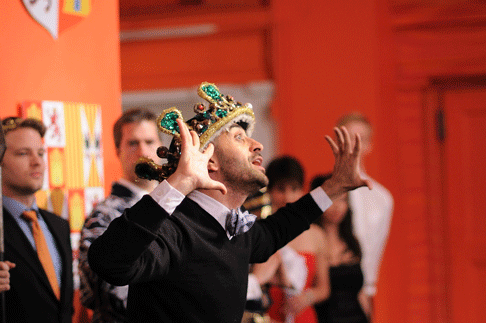 Karim Sulayman as Tabaco
Karim Sulayman as Tabaco
Due perhaps to an audience so intent that it withheld applause until the end of the evening — or perhaps to an absence of da capo repeats with their self-glorifying fireworks — the long score moved swiftly and delightfully through a lengthy score to a joyful conclusion.
John Yohalem
Click here for the program for this production.
image=http://www.operatoday.com/almira_operamission.gif image_description=Original illustration by Tomi Um for operamission product=yes product_title=G. F. Händel: Almira, Königin von Kastilien (Almira, Queen of Castile), HWV 1 product_by=Almira: Christy Lombardozzi; Edilia: Nell Snaidas; Bellante: Kristen Plumley; Consalvo: Mark Risinger; Osman: Keith Jameson; Fernando: Michael Weyandt; Raymondo: David Kravitz; Tabaco: Karim Sulayman. Presented by operamission at the Gershwin Hotel in New York with the Operamission Handel Band, conducted by Jennifer Peterson. Performance of May 29. product_id=Above: Original illustration by Tomi Um for operamissionPhotos by Mallury Patrick Pollard courtesy of operamission
June 5, 2012
Bluebeard’s Castle, New World Symphony
Judith’s soliloquy builds up to be both a précis of Bela Bartok’s opera and the anticipating tableaux announcing entrance to the seventh and final door to Bluebeard’s Castle. What awaits on the other side?
Librettist Bela Balazs described the words he wrote over Bartok’s music as “the ballad of inner life” and the castle as Bluebeard’s soul. Neither Bartok nor Balazs fail to intrigue — on the other side of that final door, a secret, a mystery. The opera leaves the audience wondering what just happened.
Such is life.
Balazs’ look at the Bluebeard legend is open to greater analysis than the essay of its origins, from a series of fairy tales written by Charles Perrault. Perrault’s creation has facial hair that literally comes out blue. The staying power of children’s stories seems to be bound to this very interpretive unobtrusiveness, for kids to dance in and for adults to play with cloaked meanings.
Today’s reader might be startled by the period-typical gore and terror of Perrault’s Bluebeard, the type whose pages could be torn from a Stephen King novel. Perrault’s story of an old curmudgeon Duke drips blood — corpses hang from hooks, decapitation is considered, murder lurks behind every castle door. This can read as quite monstrous, writing geared for little eyes and ears as it is. Balazs’ version leaves more to the imagination — definitely more Hitchcockian.
Bartok’s Bluebeard tills fertile creative ground for all involved in its production. At its “new laboratory” in Miami Beach, New World Symphony’s performance (on April 27th) took firm root in the theme of gender roles and how men and women come at love. The producers also played with the seedlings of mystery that permeate the work.
American bass Eric Halfvarson took Balazs’ “joyless” Bluebeard to a place male personified, instrumental in communication style, proud (Perrault describes him as with “a heart harder than any stone”) in temperament, with time on his side. Halfvarson reached all of these angles — in the way he turned away from Judith with up-turned nose (credit also to director Nick Hillel), in calling on the force of his voice to surge with the orchestra at the precipice to door five, and in the directness of the bass’ delivery, communicating in crumbs as Bluebeard does.
Halfvarson’s Bluebeard flexes his kingdom and might; he broods, avoiding memories that wound his spirit and using stonewalling artfully — the bass’ pleas for Judith to “stop asking questions” were teasingly unconvincing. Halfvarson turned lines like ”stop asking questions” and “stones of sorrow thrill with rapture” into gender-line crossing come-hither taunts. The bass made other moments with Judith intimate. Halfvarson highlighted Bluebeard’s own questioning and searching.
Michigander Mezzo Michelle DeYoung, of the potent middle register required for this music — a quality that has won DeYoung some of the heaviest assignments in classical vocal music — lent more than a hint of despair to a Judith that Balazs wrote to be hopeful and inquisitive, the “tend and befriend” careful nurturer. DeYoung capably expressed Judith’s determination to bring warmth and light to Bluebeard’s world, left out as she feels from it.
DeYoung projected an air of wonderment, a tense-filled moment, in telling of the vastness of Bluebeard’s kingdom. Judith wants Bluebeard’s castle rooms “unfastened” and flown open. Bluebeard’s castle trembles at the prospect. Judith reassures with “I’ll never leave you,” read tenderly by DeYoung.
At the threshold to that final door, Judith intuits that the light (from which she must shield her eyes at one point), the color, the signs of richness in Bluebeard’s castle point to a woman, or women: “tell me whom you loved before me.” DeYoung worked a fine characterization as Judith, a soul also searching.
Both Halfvarson and DeYoung communicated their respective characters’ search for meaning. Bluebeard does this through acquisitions, fortifying his castle. Judith does this by looking into Bluebeard, the rooms in his castle. “Give me another key,” Judith begs. Balazs seems to take the audience to the possible conclusion that meaning in life is found by living it. Expect no answers. Balazs takes the audience through the natural course of a human problem: searching in mystery.
This production, in its U.S. premiere, played very close to that heart, utilizing the New World Symphony’s new space and its multiple-angled walls to project (slides from Rite Digital in association with Yeast Culture) a mix of images calling on elements of the castle: water droplets, gears, spikes and sprockets, pin-needles poking through cloth, assembly-line munitions, shadows of Bluebeard’s wives dancing and posing, and lathery crimson in droves — drips and splashes.
Video dragomen Hillel, Nick Corrigan (co-director and VJ) and Richard Slaney (producer) kept things mysterious down to other details — DeYoung and Halfvarson, on the upper deck over the orchestra stage and just under the main wall slides, wore concert black — her in gown, him in evil-genius outfit and cape. The role of narrator, a mysterious sort in its own right that opens the opera and then vanishes, was read — in sight but from the wings — with leathery and seasoned voice by actor/photographer George Schiavone. Schiavone was also in informal black.
These types of subtleties worked into Balazs’ text and with Bartok’s music. Micheal Tilson Thomas’ movements were more measured at the stick, even for the huge and spacious sound — making it feel like the room was getting smaller — created by the orchestra at full throttle at castle door five. MTT trembled along with the castle.
The playing of NWS was of its usual fire and some flair; if not as successful with the mystery of Bartok’s writing (through the second door, in music reminiscent of Turandot’s riddle scene, the overall musical space tended towards stiff) instrumentalists kept the musical line tight enough to carry interest through musical transitions and to assert the Hungarian composer’s genius. The playing also failed to capture the folksiness, the Hungarian gypsy colors of this work. Instrumentalists did better with the bi-tonal and technical aspects in Bluebeard, as well as in supporting the distinctiveness of the “blood motive.”
A lot of 20th century music gets flack for excesses blamed on composers jumping on the bandwagon of atonality. Bartok’s only opera does less to connect him to this movement than do many of his other works. His Quartet No. 6 for Strings firmly places Bartok in this period while also putting him in a class apart altogether. The dissonance is there; the irregular beats, entrances, and changes are there; in this music, there is at center a strong sense of the elegiac, the pastoral, as well.
In a nice marrying of works, the quartet preceded the opera in concert. The work of the young players was on the mark if missing elegance at times. Violinist Jeanette Jang summoned power when necessary and held a disciplined and steady finishing note to the first movement. The stridency of movement two, requiring sharp cuts at bows but easier in terms of unison playing, was a good showing. The third movement, with its faint and curious echoing of the Psycho theme and Rhapsody in Blue, held up well. For the final movement, the NWS quartet (Vivek Jayaraman at violin, Anthony Parce at viola, and David Meyer at cello) assembled here handled the volume shifts — in a section that holds no little mystery to it.
What of the mystery of Duke Bluebeard and the “whispered rumors” that ruminate throughout his castle? What is behind that door? Who are the narrator, the Duke, Judith, and orchestra and MTT? What is the music? What just happened? What is the meaning of all this?
Such is life.
Robert Carreras
image=http://www.operatoday.com/BBartokBeck.gif image_description=Bela Bartok in bronze sculpture by Hungarian Andras Beck product=yes product_title=Béla Bartók: Bluebeard’s Castle; Quartet No. 6 for Strings, BB 119 (1939) product_by=Judith: Michelle DeYoung; Duke Bluebeard: Eric Halfvarson. New World Symphony. Nick Hillel, director. Jeannette Jang and Vivek Jayaraman, violin; Anthony Parce, viola; David Meyer, cello. Michael Tilson Thomas, conductor. product_id=Above: Bela Bartok in bronze sculpture by Hungarian Andras BeckLa Bohème, LA Opera
The Los Angeles production was created by the late movie director Herbert Ross in 1993. But Los Angeles is not alone in succumbing to old love. The Metropolitan Opera’s 2011-12 season included Franco Zeffirelli’s La Bohème, created in 1981, famous for its heavily populated (think about 240 bodies) Café Momus scene,which catapulted the opera into the most produced at the Met. And just last month, in May 2012 , Britain’s Royal Opera Company staged an even more ancient La Bohème created by John Copley in 1974.
Copley, the only one of the above producers still alive, was recently interviewed on the subject, and suggested that the basic reason for his production’s survival was that “It’s traditional, and people like it.” Perhaps it’s as simple as all that. All three of these long running productions are essentially technologically free, closely modeled on the clothes, furnishings and cultural aspects of an era that remains highly romanticized after almost two centuries. (The Los Angeles production features views of the unfinished Eiffel Tower.) Likely these romantic visions of Paris are easy to take and easy to understand, in that they present no challenge to new opera goers, and feel as comfortable as old slippers to many who have experienced them before.
Puccini’s libretto was created by Luigi Illica and Giuseppe Giacosa. It is derived from Scènes de la vie de bohème by Henri Murger. Murger began publishing a series of loosely knit scenes of Bohemian life by that title in 1845. They were not particularly successful until he combined some of them into a play in 1849. Subsequently they were revised and turned into a novel called La vie bohème. A Parisian “Bohemian”, himself, Murger seems not to have been a very organized fellow. In his novel Mimì dies alone at a hospital. In his play she dies on stage. Puccini’s La Bohème followed the stage play, while at the same time, he and his librettists denied it because the play was copyrighted. Puccini’s opera premiered in 1896. The following year another La Bohème premiered - this by Ruggero Leoncavallo, composer of Pagliacci. The latter work, which first gave Puccini’s opera some competition, is (although Leoncavallo’s Mimì also dies in Rodolfo’s attic) a far less romantic tale, and soon after fell from grace.
The Los Angeles opera assembled a young and handsome cast featuring married couple Ailyn Pérez and Stephen Costello as Mimì and the poet Rodolfo. This was Costello’s Los Angeles debut, though both are well known to San Diego opera lovers. Both too, are Richard Tucker award winners, and both now have burgeoning European careers. Costello has appeared at the Met and at Glyndebourne.
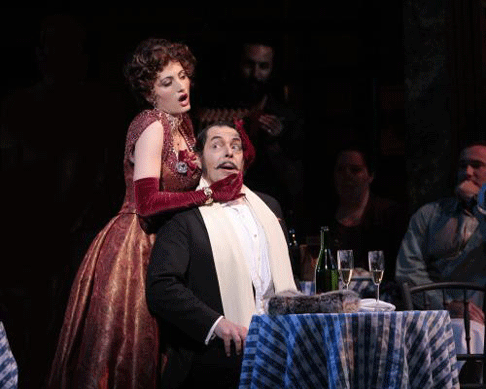 Valentina Fleer as Musetta and Philip Cokorinos as Alcindoro
Valentina Fleer as Musetta and Philip Cokorinos as Alcindoro
Pérez recently debuted at Convent Garden and at La Scala. Pérez is a particularly engaging and intelligent soprano, who is able to reflect emotions in her voice. Her sweet, coy Mimì suited the romantic setting. I’ve seen and heard Costello clear tenor many times, but at the May 26th performance I attended, his voice seemed somewhat strained and his Rodolfo did not catch fire. There was fire enough to go around, however, in baritone Artur Ruciński’s well sung Marcello, and in Valentina Fleer’s high strung and amusing Musetta. Both artists were debuting with the company. Museop Kim’s bright baritone made for an entertaining Schaunard. But a major flaw in direction had bass Robert Pomakov, the philosopher, Colline, pick up his overcoat, leave the attic in which Mimì was dying and stand on a street corner to sing “addio vecchio zimarra” his touching farewell to the garment he is sacrificing to buy medicine for Mimi. The meaning was totally lost. Though conductor Patrick Summers, also debuting with the company, set some tempos a bit slowly, Musetta’s waltz, for example, he allowed the orchestra to sing Puccini’s score as romantically as did his vocal artists. And that’s good. It’s what makes Puccini’s operas so emotionally involving and intense.
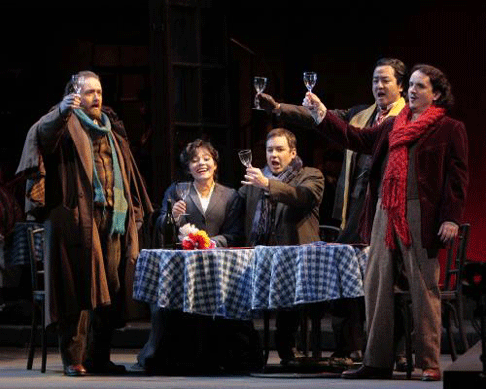 Left to right: Robert Pomakov as Colline, Ailyn Perez as Mimi, Stephen Costello as Rodolfo, Museop Kim as Schaunard and Artur Rucinski as Marcello
Left to right: Robert Pomakov as Colline, Ailyn Perez as Mimi, Stephen Costello as Rodolfo, Museop Kim as Schaunard and Artur Rucinski as Marcello
For all the romanticism and verisimilitude of the costumes and set, the bohemian’s attic, though elevated, was small and upstage. It diminished the size of the singers and of their voices. Ross was a movie director. Perhaps filming into the attic would have created a more striking effect.
Nevertheless, at its conclusion, this La Bohème like thousands before it, had the gala sold out audience, standing and cheering.
And as usual, I had cried.
Estelle Gilson
Click here for a media slideshow.
image=http://www.operatoday.com/3602-lbhm5069.gif image_description=Stephen Costello as Rodolfo and Ailyn Perez as Mimi [Photo by Robert Millard for LA Opera] product=yes product_title=Giacomo Puccini: La Bohème product_by=Marcello:Artur Ruciński; Rodolfo:Stephen Costello; Colline:Robert Pomakov; Schaunard:Museop Kim; Benoit:Philip Cokorinos; Mimì:Ailyn Pérez; Musetta: Valentina Fleer; Alcindoro:Philip Cokorinos. Conductor: Patrick Summers. Production: Herbert Ross. Dierector: Gregory A.Fortner. Set Designer: Gerard Howland. Costume designer: Peter J. Hall. Lighting Designer: Daniel Ordower. Choreographer: Peggy Hickey . Associate Conductor/Chorus Master: Grant Gershon. product_id=Above: Stephen Costello as Rodolfo and Ailyn Perez as MimiPhotos by Robert Millard for LA Opera
June 4, 2012
Detlev Glanert’s Caligula, ENO
Based on the play by Albert Camus, it’s a study of human emotion in extreme situations, expressed in vividly dramatic music.
The opera starts and ends with a scream”, says director Benedict Andrews. It’s primal. This phase in Caligula’s madness is set off by the death of his sister Drusilla, allegedy murdered because she became pregnant by him. It ends with Caligula being killed. Suddenly he shouts “I’m still alive!”. The cycle doesn’t end. Caligula’s madness is universal psychosis.
Camus was writing when Hitler and Stalin were in power. Glanert, despite his jovial personality, doesn’t shirk from the political implications. Indeed, while he was working on this opera, he had Dimitri Shostakovich in mind. Shotsakovich was a dissident who had to compromise toi survive a totalitarian regime. Caligula is mad, and everyone knows it but he has absolute power. His inner circle feed his delusion, but he’s sane enough on some level to despise them for their hypocrisy. Ralph Myers’s set is uncompromising. The audience is confronted by a wall of seats, not unlike a theatre. Perhaps it’s an arena where gladiators kill each other to entertain onlookers. Are the populace any less bloodthirsty than their Emperors? There but for fortune. Caligula looks at himself in the mirror of the moon, which refracts blinding light back at the audience. We can’t not get involved. We’re in the Coliseum, after all! Madmen become tyrants when ordinary people don’t take responsibilty. Incidentally, modern tyrants have used football stadiums to imprison people and do massacres, so the image is even more poignant.
In the middle of this arena there’s a tunnel, a discreet reminder of Caligula’s psycho-sexual confusion. Despite his madness, he’s trying to make sense of his situation. “Loneliness! Loneliness!” he wails, though he knows he can’t escape the ghosts of those he’s killed. What motivates his excesses? He’s compelled to outrage every sensibility. Yet that traps him in a vicious cycle, too. Are his provocations a kind of death wish, to goad his public until they crack?
Glanert’s music builds Caligula’s complex personality. An electronic organ rips through the more refined instruments in the orchestra. Maniacal crescendi, more meticulously orchestrated than their impact might suggest. Ryan Wigglewswoth conducts with the precison this music needs. Like Caligula, all is not in the roar. Caligula’s mind works logically, though his ratiionale is flawed. Some of this music is very beautiful. Caligula knows thw world around him is ugly, which is perhaps why he idolizes the moon. Tender woodwinds make his fantasy as alluring as he thinks it is. But Caligula can’t sustain a line of thought for long. His extreme, unpredictable mood swings are mirrored in the music. The parody burlesque and the silly songs the poets sing add wry humour. If we aren’t humane, even to madmen, we lose the very humanity that stops us becoming tyrants. Gaiety throws grotesque into high relief. When we’re at the heart of the beast, Glanert’s textures are clear. Yet scratching, thudding beats in the percussion build up pressure, and the quiet heart will again explode.
Caligula is a difficult role to sing and Peter Coleman-Weight succeeds well though he doesn’t quite get the craziness that’s in the part. The falsetto screech, for example, could be chillingly dangerous, for it touches a raw nerve in Caligula’s soul. Coleman-Wright is admirable, but he’s too much of the Elder Statesman to express Caligula’s deranged toddler tantrum disintegration. In history, Caesonia was old enough to be Caligula’s mother, and iwho indulged him in his madness. The exchange between Coleman-Wright and Yvonne Howard’s Caesonia could have been much more sinister, though perhaps that might be too unsettling for British audiences. For this same reason, it was probably best that performances all round were good, rather than especially sharp and distinctive. Chritsopher Ainslie sang well, but the part of Helicon wasn’t developed fully. Helicon (a counter tenor to Caligula’s baritone) is a mirror image of his master, and the exchange betweeen them can be more focussed. Pavlo Hunka impressed as Cherea the procurator, as did Carolyn Dobbin’s Scipio and Brian Galliford’s Mucius, and the irrrepressible Eddie Wade filled his two parts well.
But the very fact that Glanert’s Caligula is in London at all is a cause for celebratiuon. British audiences are sadly cut off from continental European music and opera in particular. Caligula is a much more sophisticated opera than Wolfgang Rihm’s Jakob Lenz heard earlier this season, though Rihm wrote that aged only 24. Caligula doesn’t have to be prettied up for British audiences. And much oif the sharpness in the opera is dimmed as a result. This ENO Caligula is much better visually than the production in Frankfurt that keeps getting revived. Benedict Andrews’s clear, unfussy style concentrates on the inherent drama. In Germany, this would be a hit. Glanert’s music is certainly not intimidating. After all, he’s guided by what Hans Werner Henze told him when they first met, that opera should communicate.
Glanert’s music has featured at the Proms eight times, but I can’t remember seeing any of his many operas in this country. Even the operas of Hans Werner Henze are rarities here, though they’re often performed on the Continent. Henze is such an important composer that it’s shocking how little Henze we get here. How can we assess the genre if we don’t hear enough to judge? So Glanert’s Caligula at the ENO is an excellent starting point.
Anne Ozorio
image=http://www.operatoday.com/Gaius_Caesar_Caligula.png
image_description=Gaius Caesar Caligula [Source: Wikipedia]
product=yes
product_title=Detlev Glanert: Caligula
product_by=Caligula: Peter Coleman-Wright; Caesonia: Yvonne Hioward; Helicon: Christopher Ainslie; Cherea: Pavlo Hunka; Scipio: Carolyn Dobin; Mucius: Brian Galliford; Mereia/Lepidus: Eddie Wade; Livia: Julia Sposen; Poets: Greg Winter; Philip Daggett; Gary Coward; Geraint Hylton; Drusilla: Zoe Hunn. Conductor: Ryan Wigglesworth. Director: Benedict Andrews. Set Designer: Ralph Myers. Costumes: Alice Babidge. Lighting: Jon Clark. English National Opera.The Coliseum; London, 25th May 2012.
product_id=Above: Gaius Caesar Caligula [Source: Wikipedia]
Don Giovanni, LA Philharmonic
I attended the May 24th presentation of Don Giovanni — an opera with the subtitle ossia il dissoluto punito, (or the libertine punished) to which, for this production, I assign a second: Don Giovanni, ossia la cornucopia traboccata. How else to describe the genius and talent associated with this production - beginning with Mozart and Da Ponte, and including Maestro Gustavo Dudamel, architect turned scenic designer, Frank Gehry, costume designers Kate and Laura Mulleavy of Rodarte, and director Christoper Alden, but as an overflowing cornucopia of creativity? Unfortunately, however, this cornucopia was unable to pour forth its riches, but was compelled to reverse its stream; that is to use its considerable gifts to fit a great operatic work onto a small stage not at all suited to opera. That the evening offered pleasure despite major failings, is a tribute to the courage of the Los Angeles Philharmonic Association and the creativity of the artists who conceived and produced the work.
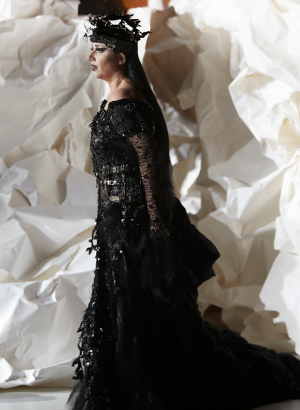 Aga Mikolaj as Donna Elvira in LA Phil’s production of Mozart’s Don Giovanni at Walt Disney Concert Hall led by Gustavo Dudamel, in collaboration with Frank Gehry, Rodarte and Christoper Alden.
Aga Mikolaj as Donna Elvira in LA Phil’s production of Mozart’s Don Giovanni at Walt Disney Concert Hall led by Gustavo Dudamel, in collaboration with Frank Gehry, Rodarte and Christoper Alden.
The restrictions that the theater imposed on the undertaking: lack of a proscenium, lack of a curtain, and only one entrance/exit at each side of the stage, were formidable. But restrictions in form, content, in fact, restrictions of any kind, are known to inspire artists to remarkably creative solutions. Such was the case here- some more successful than others. Entering the theater, the audience saw a white stage set with mounds of crinkled white paper and a large white cube. The orchestra was in the process of taking its seats behind the white set in a completely black environment. The black clothed musicians were surrounded by what seemed unscalable heights of black crinkled paper. With the only illumination the lights on their stands, to members of the audience like myself who could look into the “pit”, it seemed as if the orchestra was already in a variant of hell.
The singers performed in an ice-bound galactic universe. It turned out that the walls of crinkled white paper on stage were wheeled, as were various size white cubes which were rolled about as required by the slimmest white clad stevedores you ever saw (or were they ballet dancers?) who moved extremely slowly with precision and grace. Don Giovanni, Leporello, Don Ottavio and Masetto, were also clad in white, and were clearly chosen not merely for their vocal talents, but for their appearance in white tights. They wore a variant of space suits and distinctive sleek and shiny wigs. Don Giovanni’s wig was the blackest and his shoulder pads the widest. Leporello’s wig resembled that of Star Trek’s Data. Only the Commendatore wore black — in life and in death. In his death outfit he could have passed for Darth Vader.
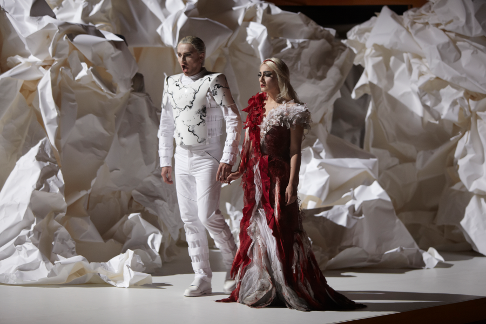 Pavol Breslik as Don Ottavio) and Carmela Remigio as Donna Anna in LA Phil’s production of Mozart’s Don Giovanni at Walt Disney Concert Hall led by Gustavo Dudamel, in collaboration with Frank Gehry, Rodarte and Christoper Alden.
Pavol Breslik as Don Ottavio) and Carmela Remigio as Donna Anna in LA Phil’s production of Mozart’s Don Giovanni at Walt Disney Concert Hall led by Gustavo Dudamel, in collaboration with Frank Gehry, Rodarte and Christoper Alden.
Golden haired Donna Anna was dressed in white in Act 1, and in a similar white dress stained with panels of red in Act 2. Donna Elvira was assigned long black hair and sparkling black dresses and head pieces for both acts, which made her eligible to do the Queen of the Night. Zerlina’s hair was violet, and her head piece and dress which spoke of youth and spring in Act 1, appeared despoiled in the second act. No PR article about the costumes omitted the fact that over 130,000 Swarovski crystals were used for those six garments.
Christopher Alden’s direction seemed designed to overcome the restrictions required by the exposed and too small stage, and to enhance the fantastic, dream-like costumes and sets. Don Giovanni approached Donna Anna’s room as though walking behind a funeral procession. Action was often vertical — that is all the characters were at one time or another were required to climb up and down the cubes. Many exits took place in openings in the crumpled paper walls, or did not take place at all. Characters required to appear in a succeeding scene often remained “inconspicuously” still in full view of the audience. Thus Don Giovanni sat atop a cube in lotus position, while other action was going on. And Don Ottavio, lay as though dead, center stage, until it was time for him to re-enter a scene. How did this all serve Mozart and Da Ponte? Surprisingly well in some ways — not at all in others. But first, the music.
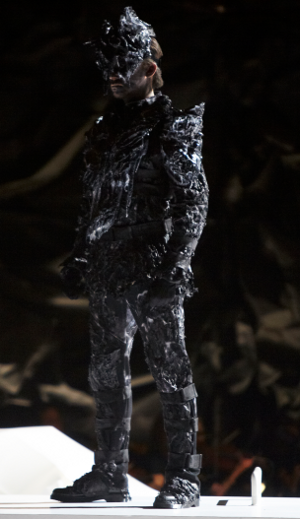 Stefan Kocan as the Commendatore in LA Phil’s production of Mozart’s Don Giovanni at Walt Disney Concert Hall led by Gustavo Dudamel, in collaboration with Frank Gehry, Rodarte and Christoper Alden. [Photo by Autumn de Wilde]
Stefan Kocan as the Commendatore in LA Phil’s production of Mozart’s Don Giovanni at Walt Disney Concert Hall led by Gustavo Dudamel, in collaboration with Frank Gehry, Rodarte and Christoper Alden. [Photo by Autumn de Wilde]
Maestro Dudamel, conducting without a score and without being able to see his singers (though they could see him on monitors) produced a bouncy overture and a dramatic, though a more strictly rhythmic reading of the score than is customary. It troubled me throughout the work that he could not see his performers, so perhaps I was projecting my own anxiety about this. But I thought he might be worried about those down beats! If precision between conductor and singers was not the hallmark of this performance, I was still amazed at how well they did come together - and at the passion the singers brought to their roles. Baritone Mariusz Kwiecien, who is said to consider the role of Don Giovanni as his “calling card,” made an attractive and sonorous Don. Bass Kevin Burdette’s Leporello was both physically and vocally lithe. Perhaps because he was costumed as were the other males, in a “space suit”, tenor Pavol Breslik’s lyrical Ottavio was not the least bit wimpy as so many Ottavios seem to be. Ryan Kuster was a fine Masetto, and Stefan Kocan’s appearance and voice as a basalt Commendatore, struck fear in all the appropriate places. Carmela Remigio, a gifted Mozart soprano, sang the emotionally complex and musically difficult role of Donna Anna with remarkable intensity. She also had the most climbing to do. Her bedroom was the top surface of the tallest cube. Aga Mikolaj, another Mozart specialist who studied with Elizabeth Schartzkopf, was a heated Donna Elvira. The sweetest soprano sounds of the evening were those of Anna Prohaska as Zerlina.
Don Giovanni is a social/sexual drama with comic elements. Da Ponte, who likely modeled the Don on his good friend, Casanova, famously described his own trysts with a sixteen year old chambermaid, while writing the libretto. In the “old days” swashbuckling Dons were the rule. The current operatic scene has incorporated carnal scenes and nudity. Setting this heated, comic and yes, moralistic work into a small, white universe, created a fascinating tension between what was being said and sung, and what we were seeing in the slow-moving icy world before our eyes. Mozart’s warmth and genius made him, appropriately, the star of the evening.
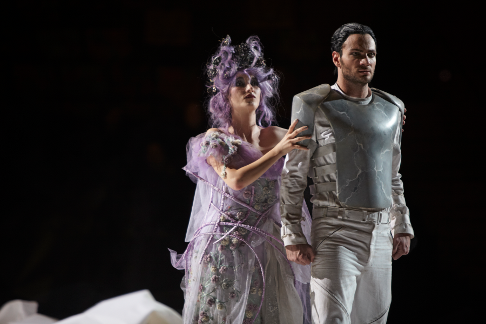 Anna Prohaska as Zerlina and Ryan Kuster as Masetto in LA Phil’s production of Mozart’s Don Giovanni at Walt Disney Concert Hall led by Gustavo Dudamel, in collaboration with Frank Gehry, Rodarte and Christoper Alden.
Anna Prohaska as Zerlina and Ryan Kuster as Masetto in LA Phil’s production of Mozart’s Don Giovanni at Walt Disney Concert Hall led by Gustavo Dudamel, in collaboration with Frank Gehry, Rodarte and Christoper Alden.
So what didn’t work? The story telling. There were no props; no sword skewered the Commendatore, Don Giovanni and Leporello didn’t change clothes, there were no goblets for the champagne aria, no peasants dancing even as the Los Angeles Master Chorale posted on both sides of the orchestra sang as if there were. The English titles told the audience of things they didn’t see. The comic scenes were weak. Audience members unfamiliar with the opera could not possibly follow the narrative. Indeed, as difficult as it was to obtain tickets to these sold out performances, many seats were vacant for the second act.
Still, it is always thrilling to see newly created and newly conceived productions of familiar works. I’m looking forward to what the Los Angeles Philharmonic’s next creative team will do with The Marriage of Figaro, ossia la folle giornata (or the crazy day). It’s a comic opera in which people jump out of windows and get locked in closets — a charming story — magical music. I trust that as Los Angeles learns to cope with its concert hall, ossia teatro dell’ opera, we will see a great show.
Estelle Gilson
image=http://www.operatoday.com/DG_LA_01.png image_description=Mariusz Kwiecien as Don Giovanni in LA Phil’s production of Mozart’s Don Giovanni at Walt Disney Concert Hall led by Gustavo Dudamel, in collaboration with Frank Gehry, Rodarte and Christoper Alden. [Photo by Autumn de Wilde] product=yes product_title=W. A. Mozart: Don Giovanni product_by=Don Giovanni: Mariusz Kwiecien; Leporello: Kevin Burdette; Donna Anna: Carmela Remigio; Donna Elvira: Aga Mikolaj; Don Ottavio: Pavol Breslik; Zerlina: Anna Prohaska; Masetto: Ryan Kuster; Commendatore: Stefan Kocan.Los Angeles Philharmonic. Gustavo Dudamel: conductor. Christopher Alden, director. Frank Gehry: installations. Kate and Laura Mulleavy of Rodarte: costume design. Adam Silverman: lighting design. product_id=Above: Mariusz Kwiecien as Don Giovanni in LA Phil’s production of Mozart’s Don Giovanni at Walt Disney Concert Hall led by Gustavo Dudamel, in collaboration with Frank Gehry, Rodarte and Christoper Alden.All photos by Autumn de Wilde
Salome, Royal Opera
This is a Salome who is less interested in the bodily pleasures offered by the pure masculinity of Jokanaan than in the narcissistic celebration of her own vicious carnality. And, Angela Denoke is just the singer-actress to convey the princess’s escalating self-awareness and indulgence in emotional extremities. Denoke, returning as Salome after her performance in the production’s 2010 revival, may not have had the requisite consistent sheen at the top, and indeed may have struggled at times to hit the uppermost notes truly and securely — who wouldn’t given the unalleviated high tessitura? — but she possesses an emotional sincerity, communicated through an infinite variety of colours, shades and shadows, which wins the hearts and minds of the audience. Slightly tense at the start, she went from strength to strength: the final statement of her insistent demand, “Give me the head of Jokanaan”, was truly chilling in its honest exposure of human egoism; and in the final scene, as she cradled the bloodied head of the prophet, at times tender, then terrifyingly solipsistic, she communicated powerfully the destructive yet vulnerable self-regard of the eponymous anti-heroine before her thankfully inevitable death.
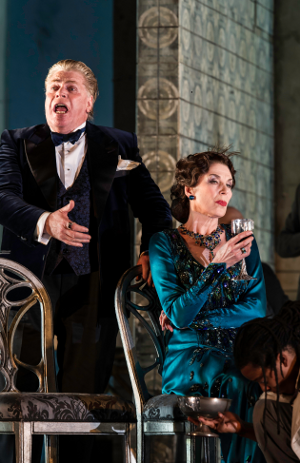 Stig Andersen as Herod and Rosalind Plowright as Herodias
Stig Andersen as Herod and Rosalind Plowright as Herodias
As the ill-fated prophet, subjected to incarceration in the unfathomable depths of Herod’s subterranean prison, Egils Silins’ bass has the necessary biblical profundity to lend sonorous weight and resonance to his visionary pronouncements, which rise through the black grid of internment like clarion calls to humanity in the face of the wickedness to which it has submitted. Unfortunately, his perhaps understandably self-absorbed characterisation resulted in absolutely no erotic tension between Silins and Denoke; nor a real sense of the prophetic power which might strike such fear in the heart of Herod. And, as Jokanaan strode back and forth across the stage, fleeing Salome’s flirtatious advances, one wondered why the guards melodramatically traced his movements with their rifles given Herod’s command that the prophet must not be harmed. Surely none would risk such suicidal recklessness?
Stig Anderson, as Herod, used his resonance and power intelligently. There was no doubting his stentorian dominance and brutality when he unleashed his full force, but elsewhere his weak hesitancy was effectively conveyed.
Rosalind Plowright was a persuasive, vocally secure Herodias, sufficiently sumptuous to make her a convincing object of Herod’s desire, but not afraid to add a touch of roughness or harsh extremity to convey the Queen’s desperation to maintain her husband’s admiring gaze and her delight in capitalising on his weakness. Her relationship with her daughter was appropriately ambiguous.
The minor roles were performed with uniform accomplishment. The beautiful warmth of tone of Will Hartman’s Narraboth poignantly conveyed the purity of his transfixion in the face of Salome’s beauty; indeed, the understated portrayal of his death seemed a dramatic injustice. As the First and Second Soldiers, Scott Wilde and Alan Ewing were resonant and clear; similarly, Peter Bronder, as the first Jew, and Andrew Greenan, as the first Nazarene, were vocally and dramatically compelling.
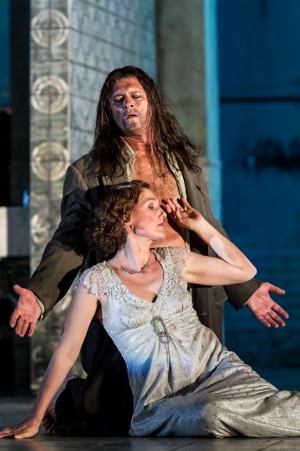 Egils Silins as Jokanaan and Angela Denoke as Salome
Egils Silins as Jokanaan and Angela Denoke as Salome
Andris Nelsons conducted the orchestra of the Royal Opera House in a thrilling, precise yet disquieting rendition of Strauss’s provocatively extrovert score. Solo lines emerged effortlessly from the luxuriant orchestral canvas. The seductive harmonies which foreshadow Rosenkavier — employed therein to depict exuberant sexual freedom, piquant desire and joyful satisfaction — were here bitterly destabilized by disconcerting instrumental colours textures and extremity of register, which Nelsons exploited to perfection. The conductor perfectly balanced measure and excess, liberation and control. His ability to restrain his naturally exuberant forces until precise moments of erotic release was nowhere more evident than in the Dance of the Seven Veils.
Oddly, here, McVicar eschews an erotic depiction of Salome’s growing appreciation of the power ordained by her beauty and nascent sexuality; rather we have a series of remarkably chaste, dream-like tableaux as Salome is relentlessly pursued through a series of chambers by Herod, her movements and gestures suggestive of an increasing interiority and introspection (à la Freud?). That is, until the final image portentous of imminent — or retrospective — rape.
There are many McVicarian clichés — gratuitous nudity, excessive blood-letting etc. etc. — but, while some have found some aspects of the production (the Nazi uniforms of the subterranean warders, for example) unduly specific and contradictory to Wilde’s somewhat stylised, even mythic, timelessness, to me they seemed true to the era in which Strauss composed his opera — when man’s appalling sadism was shortly to be revealed in its full horror. Es Devlin’s split-level designs — we are afforded glimpse of blasé banqueting diners loftily removed from the debasing debauchery below — effectively intimate the hypocrisy of the indifferent, and the shared culpability of all mankind. And, at the close, even the naked executioner Naaman (Duncan Meadows) is unable to overcome his disgust and turns his back upon the repellently orgasmic Salome, until required to fulfil Herod’s command to “Kill that woman!”; savagely breaking her neck, he conveniently relieves our own disgust and, thankfully, breaks our hypnotic absorption with Salome’s repulsive yet mesmerising self-glorification.
To some extent it is probably true that modern opera audiences, immune to the gore, nudity, depravity and gratuitous degeneracy regularly served up by directors, are largely unshockable. Yet, this listener for one experienced nauseating terror in the face of the dreadfulness of Wilde’s and Strauss’s disclosure of humanity’s inhumanity; a terror resulting less from the gruesome specificity of McVicar’s reading than from its suggestion of man’s ubiquitous amorality and cruelty — rendered supremely, and ironically, by Strauss’s painfully beautiful musical portrait.
Claire Seymour
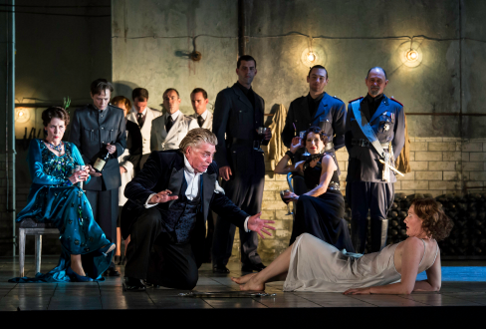 Angela Denoke as Salome, Stig Andersen as Herod and Rosalind Plowright as Herodias
Angela Denoke as Salome, Stig Andersen as Herod and Rosalind Plowright as Herodias
Photos © ROH 2012 / Clive Barda
Maria Padilla: Chelsea Opera Group
When Donizetti received the commission from Milan for a new opera he was the toast of Vienna and Paris. He had something of a history with both the Milanese audience and the critics. The prevailing operatic style in Milan was still for blood and thunder works with tyrannical fathers, villainous baritones and if possible a mad scene. Donizetti decided to give them everything they might expect, only not quite in the right order.
London-based Roumanian-born soprano Nelly Miricioiu had a great success in 2011 with the Polish premiere of Donizetti’s Maria Padilla. So it was very apt that the work be chosen for Chelsea Opera Group’s final concert of the season, one celebrating Nelly Miricioiu’s 60th birthday on Sunday 27 May at the Queen Elizabeth Hall. Conducted by Brad Cohen, Chelsea Opera Group fielded a strong cast with Nelly Miricioiu as Maria de Padilla, Marianne Cornetti as her sister Ines, Emma Carrington as Francisca, Paul Curievici as Don Luigi, Piotr Lemp, as Don Alfonso, Richard Morrison as Don Pedro, Marco Panuccio as Don Ruiz and Daniel Grice as Don Ramiro.
The plot concerns the usual soprano, tenor, baritone triangle. Maria is love with Don Pedro who hopes to seduce her. She refuses (with a dagger in her hand), he agrees to marry her, but insists they keep the marriage secret. Maria elopes with him and her father, Don Ruiz, casts her off. When Don Pedro becomes King Pedro (the historical Pedro the Cruel), Don Ruiz comes to court disguised, insults Pedro, is beaten by Pedro’s men and goes mad. All ends happily of course.
The eagle-eyed amongst you will have spotted, from this summary, that the soprano is in love with the wrong voice. She’s in love with the cruel and villainous baritone and the tenor is the tyrannical father, who gets a mad scene (rather than the soprano). Was Donizetti spicing things up a bit, or perhaps having some fun at the expense of Milanese audience.
None of the other principals has a part quite as substantial as that of the title role. The opera is in fact delineated by Maria’s relationships with Ines, Don Pedro and Don Ruiz, expressed in a series of powerful and substantial duets. Additionally, Don Pedro and Don Ruiz’s punishing encounter is set out in duet form as well.
But Donizetti has another trick for us. At the premiere, the ending had Maria expire from joy. But shortly after this he replaced this ending with the present happy one with an explosive cabaletta for Maria. No-one knows why, and Donizetti’s surviving letters are little help. As he tore the music out of the score, this tragic ending cannot now be reconstructed.
One final musico-historical conundrum, the opera is a sort of sequel to Donizetti’s La Favourite; Pedro being the son of Alfonso the hero of that earlier opera.
No-one would expect Nelly Miricioiu at 60 to have the same voice as she did 25 years ago, but what is remarkable is the way she still combines dramatic intensity with an ability to move her voice around complex coloratura. There are few singers around to match Miricioiu for giving dramatic weight and colour to each note of a complex run, or for her daring (this latter was something which conductor Brad Cohen commented upon in his tribute to the singer which prefaced the concert).
Maria de Padilla seems a part tailor made for Miricioiu’s style of dramatic virtuoso singing. Donizetti’s vocal line is complex, but the character undergoes dramatic extremes. Donizetti hints at the sort of simpler dramatic utterance which would become common later in the century. Not everything Miricioiu did was lovely, but it all had an element of dramatic truth and there are still few singers around today to match her vividness.
The opera ends with an extended cabaletta for Maria, and the opera does have its fair share of cavatinas and cabalettas to satisfy the Milanese musical taste. But the meat of the role is in the duets, these are extended musical sequences where Donizetti allowed himself freedom. Here he was looking forward, reflecting the changes to his style wrought by Vienna and Paris. In the duets and ensembles he allowed himself a greater structural flexibility and longer breadth.
The duet between Maria and Don Pedro (Richard Morrison), when he comes to seduce her, is anything but a love duet. She is infatuated with Don Pedro but has a dagger and insists on marriage. The result is a scene which swings between moods in startling fashion.
With Maria and her sister Ines (Marianne Cornetti), we are on more familiar ground in their duet, as the two express their love for each other using the familiar device of cascades of thirds, something that Miricioiu and Cornetti did brilliantly and for the reprise they even moved to sharing the same copy.
The final duet is the startling and touching scene between Maria and her father, Don Ruiz (Marco Panuccio), driven mad by the beating he has received. This is another scene where Donizetti allows himself flexibility of structure and is not constrained by form. Miricioiu and Panuccio created a striking and touching duet, which rather prefigured some of Verdi’s great father daughter duets.
As Maria’s lover, Don Pedro, Richard Morrison displayed a beautifully moulded line, the high tessitura of the baritone part seemingly not a problem for him. His platform demeanour was rather understated and something of this crept in to his voice which, for all its beauty had a slight cool distance. Don Pedro needs to convey an element of glamorous danger, and Morrison didn’t. His first scene with Miricioiu was technically well judged but lacked a passionate edge, after all he was supposed to be seducing the woman by force. And his scene with Pannucio lacked a feeling of danger, after all Don Pedro was known as Pedro the Cruel. But this scene has some curiously interesting moments, with the two male voices venturing some cascades of thirds which echoed those of Miricioiu and Cornetti in their duet. Was Donizetti trying to tell us to tell us that these two violent men were akin to brothers, or was something more ironic going on.
As a romantic lead, Don Pedro isn’t a huge part. He is absent for much of the third act and when he does appear in the final scene, Donizetti and his librettist seem to have realised that they have never given Don Pedro the chance to express his love for Maria. So he sings a lovely cavatina, beautifully realised by Richard Morrison.
Don Ruiz is an equally odd role, being absent in the first act, very much the tyrannical father bogey man. Only at the end of the second act does he appear and challenge Don Pedro, receiving a beating for his pains. The character’s main interest is in the long mad scene in the third act, when Maria tries to win her father back to sanity. Here Marco Panuccio seemed to relish the chance to do something different from the general run of Rodolfos and Pinkertons (he is Pinkerton in Madama Butterfly at Grange Park Opera). He has a beautiful voice and showed himself apt at colouring it during the mad scene. He created a touching relationship with Miricioiu’s Maria.
Marianne Cornetti has made something of a name for herself singing dramatic Verdi roles such as Eboli, Azucena and Amneris. But she seems to have an enviable ability to move her substantial voice around Donizetti’s vocal lines and to scale it aptly. Donizetti opens the opera with a duet for Ines (Cornetti) and her fiance, Don Luigi (Paul Curievici). Here Cornetti took time to warm up and her passage-work was inclined to be uneven. But she compensated by creating a vivid and appealing partnership with Curievici. In her duet with Miricioiu, Cornetti was fully on form and blended finely with Miricioiu. Ines is quite a substantial part and has a strong participation in the drama. Though the subsidiary soprano role, Donizetti made the part a real character and not just someone to make up the lines in ensembles. Cornetti clearly relished the opportunities given to her.
As Maria’s lovely, Don Luigi, Paul Curievici seize his moment of glory in the opening duet with Cornetti. Curievici was effective in creating a delightful relationship with Cornetti, even when he was not singing, this took the duet well past the conventions of concert opera. Curievici is a young singer whose career I have watched with interest over the last few years and it is pleasing to report that he has developed into a stylish Donizetti singer.
Piotr Lempa displayed a fine bass voice as Don Alfonso, who is killed between the first and second acts. Daniel Grice similarly impressed as Don Ramiro who appears in the second and third acts.
The performance wasn’t without incident. At one point Miricioiu lost her page in the score. And Panuccio bravely essayed a note in alt using head voices (a technique tenors of Donizetti’s time would have been familiar with), which didn’t quite come off, but I admired him for making the effort.
Donizetti made considerable use of the chorus in this opera, using them quite extensively to frame scenes. The opera opens with a short prelude which leads straight into a chorus of villagers. A structure which Donizetti uses again in the opera. The second act opens with a substantial chorus which sets the uneasy background to King Pedro’s reign.
Now, it has to be admitted that like many other choirs in London, the choir of Chelsea Opera Group has an ageing but enthusiastic personnel. Under chorus master Deborah Miles-Johnson, the choir has developed more presence over the last few years and they grasped enthusiastically the opportunities Donizetti gave them. Though in their big chorus at the opening of the second act I could have wished for rather more words.
Donizetti’s use of the orchestra in Maria Padilla reflects both the fact that Milan possessed a fine orchestra and that his style had developed since starting to write operas for Vienna and for Paris. Not only was the accompaniment richly expressive but Donizetti prefixed each act by an evocative prelude. The orchestra were on good form for Brad Cohen, who encouraged some seriously expressive playing from his players.
This was definitely a vintage Chelsea Opera Group evening. A strong cast, led by Nelly Miriociou under Brad Cohen’s clearly inspirational baton, meant that due dramatic weight was given to one of Donizetti’s unjustly neglected scores. And we celebrated Nelly Miriociou’s birthday in fine style.
Robert Hugill
image=http://www.operatoday.com/gaetano-donizetti.gif
image_description=Gaetano Donizetti
product=yes
product_title=Gaetano Donizetti: Maria Padilla
product_by=Donna Ines Padila: Marianne Cornetti (soprano); Don Luigi: Paul Curievici (tenor); Donna Maria Padilla: Nelly Miricioiu (soprano); Francisca: Emma Carrington (mezzo-soprano); Don Alfonso di Pardo: Piotr Lempa (bass); Don Pedro: Richard Morrison (baritone); Don Ruiz di Padilla: Marco Panuccio (tenor); Don Ramiro: Daniel Grice (bass. Chorus and Orchestra of Chelsea Opera Group. Brad Cohen (conductor). Chelsea Opera Group. Queen E;lizabeth Hall, London, 27th May 2012.
product_id=Above: Gaetano Donizetti
Handel and the Rival Queens: Lufthansa Baroque Festival
Creatively the early 1720’s were a triumph for Handel, he produced a string of masterpieces culminating in Giulio Cesare in 1724. The Royal Academy had a strong cast of singers, the cast headed by the castrato Senesino and the soprano Francesca Cuzzoni. But the directors clearly thought something was missing and engaged a second prima donna, Faustina Bordoni. For a few seasons, the Royal Academy had two reigning divas. Bordoni arrived in time for the premiere of Handel’s Alessandro in 1726, thus issuing in the era of ‘The Rival Queens’.
For the final concert of this year’s Lufthansa Festival of Baroque Music at St John’s Smith Square on Saturday 26 May, Christian Curnyn and the Early Opera Company told the story of the amazing and sometimes scandalous seasons when Cuzzoni and Faustina (as they were habitually referred to in the press) reigned supreme. Soprano Mhairi Lawson incarnated Faustina and Lisa Milne (replacing Rosemary Joshua) incarnated Cuzzoni, with Christopher Benjamin reading from contemporary sources. The concert followed events historically, starting with Ottone (1723), Handel’s first opera for Cuzzoni and ending with works written for the sopranos when they left the Royal Academy.
By an unfortunate co-incidence, Alessandro (1726), the opera in which the two sopranos first sang together in London had the same subject, Alexander the Great, as the popular tragedy The Rival Queens (1677) by Nathaniel Lee and the satirical play, The Rival Queans by Colley Cibber. Thus the press and the public soon dubbed Cuzzoni and Faustina as well, a media phenomenon was born. Cuzzoni and Faustina, whilst both touchy prima donnas, had worked together before. But in London, public and press interest created the Rival Queen phenomenon, akin to a modern media storm. London society formed itself into Cuzzoni and Faustina factions.
Whether the two sopranos actually came to blows on stage is debatable, but the events ended in disaster. The Royal Academy ran out of money. The Rival Queens departed. Faustina married the composer Hasse and had a long and happy marriage as the toast of continental Europe. Cuzzoni’s marriage was less happy, with many debts. She returned to sing with the Opera of the Nobility, the company set up in rival to Handel, under Nicola Porpora. But eventually departed to Italy, dying in penury.
Benjamin’s readings included a contemporary description of the Cuzzoni’s voice from Mancini and a positively salivating description of Faustina’s face and voice which was printed in the Universal Journal. There was a funny and hugely satirical view of what it was to be a prima donna from Marcello.
There was cause for no little humour when one of present day sopranos took to the stage immediately after a big build up about her historical counterpart’s voice, or a satirical description of her historical counterpart’s behaviour. A situation which was treated with much good humour and general hilarity which, combined with the high level of performance, contributed to the distinctive quality of the evening.
Contemporary letter writers described the furore surrounding the singers, with Mrs Delaney, intolerant of those who found Handel’s work lacking, saying the English have no taste in music!
Cuzzoni’s last mentions were the pathetic letter published in the General Advertiser announcing her intention of trying to clear her debts before leaving for Rome, and a description by Charles Burney of her third visit to London, when her powers had diminished considerably. By contrast, Burney’s diary from the 1770’s gave a touching description of his visit to the elderly Hasse and Faustina in Vienna.
And what was Handel’s reaction to all this? There are sufficient anecdotes to suggest his relationship with the sopranos was stormy, though that applied to his relationship with Senesino as well. Handel’s operas for the Rival Queens show a concern to give the two ladies equal weight and balance. And this is the problem, musically Handel seems to have been a little inhibited, the operas written for Cuzzoni and Faustina do not match those written for Cuzzoni alone. But, if not quite vintage Handel, there were some very striking moments.
Curnyn opened with the overture to Ottone (1723) in a crisp and lively performance with a fast section whose oboe burbling had an apt touch of The Arrival of the Queen of Sheba about it.. This was followed by Lisa Milne singing “Amanta Stravagente” from Flavio (1723), a delightfully teasing piece in which Milne’s rich voice easily threw off the runs. Her next aria was the best known piece in the evening, a stunning performance of “Se pieta?” from Giulio Cesare (1724). Here, as in some of best slower arias, Handel lets the bassoon off the leash in the ritornelli, to provide lovely counterpoints clearly relished by the orchestra’s bassoonist.
The overture and three arias from Alessandro (1726) brought us to ‘The Rival Queens’. Mhairi Lawson sang a captivating account of “Lusinghe piu care” (Sweetest allurements, true darts of love). A relaxed piece, but still with plenty of passage-work which Lawson encompassed easily, her voice with a warm, soft edge to it.
Milne’s “Che tirannia d’amor” (What a tyrannous thing is love) was a siciliana with a strongly pathetic vein which seemed to be one of Cuzzoni’s specialities. The first half ended with Lawson’s brilliant account of “Brilla nell’alma” (There sparks within my soul an unexpected yet sweet contentment).
We opened part two with Lord Hervey’s description of the Faustina and Cuzzoni factions developing in Society, followed by a stylish account of the overture to Admeto (1727) from Curnyn and the orchestra.A satirical description of the factions from a broadsheet hilariously attributed the popularity of Faustina and Cuzzoni to a papist plot. Though we can laugh today, there were probably people in London who really did take this seriously.
Milne followed this with a lively performance of “Torrente cresciuto” (Consider the torrents), a simile aria from Siroe (1728) which was obviously intended to display Cuzzoni’s talent at divisions, and Milne showed herself quite the equal. Faustina’s aria from Riccardo Primo (1727) “Quell’innocente” (An innocently suffering heart) was another apparently simple, pathetic piece which was certainly not simple and Lawson showed deceptive ease with the passage-work.Next came the overture of Porpora’s Polifemo written for the the Opera of the Nobility in 1735. Porpora used rather busier textures than Handel and Curnyn’s attractively lively performance made me wonder what Porpora’s operas would be like.
Milne’s final aria was “Miseri, sventurati” (Oh, how wretched, how hopeless) from Porpora’s Arianna in Nasso (1733). Porpora used a richly textured accompaniment with delightfully bubbling oboe. The aria is pathetically charming, and received a very affective performance from Milne. In the Da Capo she elaborated the vocal part extremely but without showy brilliance. Lawson’s final aria was from her husband Hasse’s opera Cleofide (1731), based on the same libretto as Handel’s Alessandro. Lawson sang “Son qual misera colomba” (I am like a wretched dove), preceded by a dramatic accompagnato. The aria was very much in the galant style, with the sort of difficult but gratefully written coloratura which made Hasse a great favourite with contemporary singers.
But this wasn’t the end. Christopher Benjamin gave a final reading from ‘The Art of Florid Song’ in which the charms of Faustina Bordone and Francesca Cuzzoni were described, with the author wishing to unite them in one person. Then Mhairi Lawson and Lisa Milne joined together to sing the duet, Placa l’alma, quieta il petto (Sooth your restless spirit) from Alessandro.
A delightful conclusion to an evening which mixed erudition, humour and superb performances into one profoundly satisfying whole.
Robert Hugill
image=http://www.operatoday.com/George_Frideric_Handel_by_Balthasar_Denner.png
image_description=Portrait of Georg Friedrich Händel (1685-1759) attributed to Balthasar Denner c. 1726-1728 [Source: Wikipedia]
product=yes
product_title=Handel and the Rival Queens: Lufthansa Festival of Baroque Music
product_by=Mhairi Lawson (soprano); Lisa Milne (soprano); Christopher Benjamin (speaker). Early Opera Company. Christian Curnyn (harpsichord and conductor). St. Johns Smith Square, LondonSaturday 26 May 2012.
product_id=Above: Portrait of Georg Friedrich Händel (1685-1759) attributed to Balthasar Denner c. 1726-1728 [Source: Wikipedia]
A Toronto Trilogy
Dazzling vocalism ensured constant musical delight in the company’s Semele, an oratorio-turned-opera that has been getting wider play on world stages as more and more singers appear who can actually meet the score’s interpretive demands.
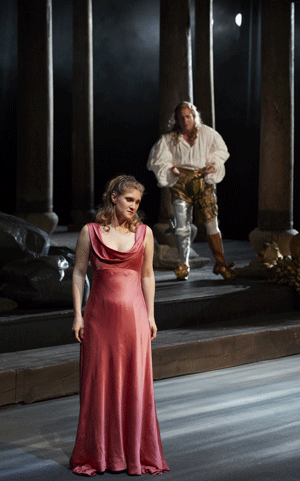 Jane Archibald as Semele (foreground) and William Burden as Jupiter (background) in Semele
Jane Archibald as Semele (foreground) and William Burden as Jupiter (background) in Semele
Jane Archibald surely has few (any?) equals in the title role, her plush silvery soprano filling the house with a vibrant presence. Hers is one of the most assured techniques in the business, and she tossed of the coloratura of “Myself I shall adore” with utter confidence and great tonal beauty. The jaw-dropping accuracy and breath-taking rapidity of the (almost non-stop) melismas did not seem intended to be heard merely by mortal ears. But Ms. Archibald was much more that flash and dazzle. Her sonorous, limpid treatment of Handel’s legato phrases was no less impressive.
Moreover, as an actress, Jane is a total natural, her movement fluid and spontaneous, her gestures motivated and meaningful, her interaction with fellow characters committed and collegial. The fact that she flawlessly intoned her first famous aria while being flown like an angel figure, descending from the flies and hovering twenty feet above the stage, is nothing short of miraculously concentrated artistry. A lovely physical presence married to first-tier artistry, Jane Archibald can likely write her operatic future as she pleases.
Allyson McHardy was also a potent force with which Semele has to reckon, in her dual roles of Ino and Juno. Her pliable, plummy mezzo was not only cleanly and evenly produced, but Ms. McHardy was able to damn’ near match the heroine’s vocal pyrotechnics, as evidenced by a riveting, hair-raising account of “Hence, hence, Iris, hence away.” If Allyson had brought any more blazingly accurate intensity to this aria, I am not sure my heart could have stood it!
The reliable, chameleon-like William Burden turned in yet another memorable, finely tuned, beautifully judged performance as Jupiter. This fine tenor is so effortlessly terrific in such a wide variety of roles and genres, that it could be easy to take him for granted. As usual, he does not disappoint, treating us to superbly controlled, meaningfully phrased Handel that is invested with emotional import, freely produced tone, and meticulous diction. His hushed, languid Where’er you walk was alone worth the priced of admission. And William-the-Handsome certainly has the physique du rôle to impersonate any super hero he wants.
The role of Athamas is assumed by highly skilled counter-tenor Anthony Roth Costanzo, who impresses me even more every time I hear him. His easy projection and skillful florid singing were knitted to a forward-placed tone of considerable power and color. Mr. Costanzo has a special gift for blending descents to lower notes into a potent, almost baritonal timbre that pays good interpretive dividends. Steven Humes was quite winning in the dual assigment as Cadmus and Somnus. His orotund bass had a decent bite to the sound, and he showed off some powerful excursions into a sustained deep register that suggested penetrating pedal tones on a pipe organ. Impressive.
Rinaldo Alessandrini showed a sure hand leading the period instrument group in the pit and the players responded with secure, supportive playing which ably partnered the singers. I have heard more color, personality, and dramatic fire from other well-established early music groups, but nonetheless, this band was clean, and responsive. The choral singing under Sandra Horst was a marvel of style and tonal beauty.
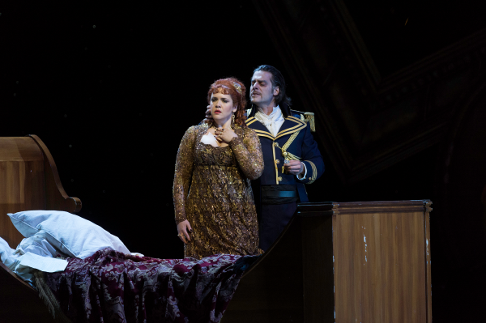 Keri Alkema as Giulietta and John Relyea as Dapertutto in The Tales of Hoffmann
Keri Alkema as Giulietta and John Relyea as Dapertutto in The Tales of Hoffmann
In press releases, director Zhang Huan remarked to the effect that he had never directed an opera. The quick and dirty reaction would be: “He still hasn’t.” But that would be to deny many beautiful visual elements of the production, the scenery of which he also designed. Or rather, re-assembled. For the basic environment was an actual Chinese temple, that the artist purchased, shipped, and put back together on the stage at the Fours Seasons Center. A mini-documentary (grainy black and white with subtitles) of the acquisition process is projected during the overture, unfortunately thereby relegating the score to Muzak. But it must be reported that when the curtain rose to reveal the actual temple filling the stage, the audience burst into applause (as much for effort as for artistry). But it did not really wear well as the show went on.
For Mr. Huan, there was evidently some spiritual impetus, some mystic force that this structure was meant to conjure. For me, the set could have been built out of Canadian lumber and styrofoam, and the whole lovingly painted with fine detail and texture, and COC would have been spared a whole lot of bother. Lest that seem irreverent of me, Zhang himself had little trouble disrespecting Handel’s creation as he pursued extra-musical distractions that were shoe-horned into this Buddhism-inspired interpretation. A colorful, randy donkey (two dancers) wears out its visual welcome in the first scene. Did Athanas really have to stroke the ass’s ass at the end of his impeccably sung aria? And then the damn’ animal re-appears later during choral revelry sporting a huge, latex erection, intent on impaling some-one/thing with it.
And hey, did you ever think Handel and Sumo wrestlers were a ‘match’? I can report the sound of naked chubby flesh slapping together was not an enhancement to the score. (In this version, “it ain’t over ‘til the fat man wrestles.”) The insertion of an Asian unaccompanied song, a nasal tenor solo regaling us with meanderings and wailings (perhaps well-sung by Asian folk song standards?) again completely took us out of the musical style. And this after cutting Semele’s “The Morning Lark!” Oh, and the last joyous chorus was also MIA. Yes, that’s right. The show ended as it began, with a peasant woman sweeping the floor with a twig broom as the persistent sound of rainfall slowly faded and the curtain slowly fell. Sorry, but I have to ask: where was the Music Director during all this? As compensation, a recording of the final chorus was piped into the lobby as we left the theatre. All of this had as much to do with Semele as well, the price of tea in China. Contrary to the advertisements, this piece is not Zhang Huan’s Semele. To have allowed it to be so did Handel an enormous disservice.
To be fair, some effects landed. Having Somnus atop the roof as a giant doll that inflates as he awakes, with a mini-Somnus singing for, and in front of the blow-up was good fun. I guess the sinuous parading dragon suited the chaotic moment in which it was interpolated. Best of all, having Jupiter lovingly bathe Semele’s feet while he intoned “Where e’er…” was a stunning visual depiction, a brief oasis of truth in the theatrical muddle. At least the stellar cast was placed, often down stage to be heard to maximum advantage. Han Feng designed gorgeous costumes, eye-catching and character specific, a quirky-but-worky blend of traditional Asian, Baroque, and modern accents that were endlessly appealing (Juno’s wig seemed a paean to Marge Simpson). Wolfgang Goebbel’s lighting design (recreated by Willem Laarman) was by turns haunting and vibrant. There may be a case to be made for the parallels between ancient Chinese deities and those that people Semele, but this production has not yet found a cogent realization.
On the other hand, the next night’s The Tales of Hoffmann was arguably my favorite staging to date of this enigmatic masterpiece, which seems to have as many different performing editions as there are different productions. The total success of this mounting started with the remarkably assured performance from young American tenor Russell Thomas in the title role. Mr. Thomas has an uncommonly attractive, unforced instrument that is evenly produced from top to bottom. The tone is meaty enough to be (just) on the brink of verismo success, but never pushed past its limit. Its thrilling clarion punch in the upper reaches is complemented by his total skill at seamlessly scaling back a held high note from forte to piano, with no loss in presence or quality.
Too, Russell displays considerable skill at investing words and phrases with appropriate emotional content and nuance to not only propel the story, but also to limn Hoffmann’s mercurial nature. This is already a major talent. If he continues to grow at a measured pace, exercises good judgment in repertoire, and keeps the voice flowing as beautifully free as in its current estate, Russell Brown could become that elusive new superstar tenor (read: Verdi and Puccini) the world has been waiting for.
Hard to believe that home boy John Relyea was making his Canadian Opera Company debut with the four villains. Already a long established, acclaimed singer at all of the world’s major houses, Mr. Relyea confirmed the reason for his stature with an assured performance of power and polish. There is virtually nothing in these four diabolical characters that eludes him. His rolling bass is handsome, dark, and pointed, with such a well-focussed projection that it could probably be heard in Niagara Falls. For a sound this big and imposing, Mr. Relyea displayed considerable flexibility, and he certainly knows how to make each phrase count. When a phrase or two ventured into the extreme upper register, he got through it with moxie and a bit of covering, but this is a pro who knows how to engage an audience with exuberant vocalism. (I did wonder how he might fare with the suave demands of “Scintille, diamant,” cut from this edition.)
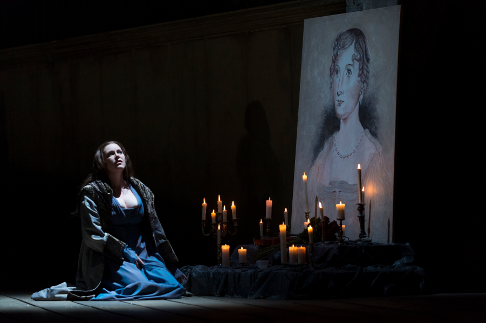 Erin Wall as Antonia
Erin Wall as Antonia
The women were also ideally cast, starting with audience favorite Andriana Chuchman as Olympia. The petite soprano, lithe of figure and lovely to behold, spun out a glittering filigree of ornamentation, staccati and arpeggiated figures. Her physical embodiment of the emotionally vacant automaton communicated volumes and was admirably consistent. Her lean, fluty timbre was well projected and securely produced, but a little attention to tuning might be suggested in the extended outline of several of the broken chords. Nonetheless the audience was giddy with delight at Ms. Chuchman’s solid work.
Erin Wall proved to be a near ideal Antonia, sporting a ripe middle range and gleaming top notes. The warm shading in Ms. Wall’s well-schooled soprano was a match made in heaven for the doomed girl’s characterization, and her masterful way with shaping extended phrases of arching beauty was revelatory. A sincere and involved actress, Erin elicited our complete sympathy as she took Antonia’s melancholy journey. Keri Alkema lavished Giulettia with a dusky, sonorous mezzo that made a persuasive case for this (to me) least complex heroine of the piece. Her mellow, surging rendition of the famous Barcarolle was one the evening’s highlights.
Lauren Segal was exceedingly fine doing double duty as the Muse and Nicklausse. Ms. Segal always put her gleaming, sturdy instrument to good artistic purpose, delineating well between the two personages, and investing both with secure musicality. Steven Cole contributed four incredibly inventive, appealingly sung comprimario turns as Andres, Cochenille, Frantz, and Pitichinaccio. In fact, I have never seen anyone do these better, making Mr. Cole a wonderful ‘discovery.’ The incredible depth of this cast went on to include a ringing Luther from Valerian Ruminski; a sturdy performance from Gregory Dahl, effectively doubled as Crespel and Schlémil; a well-realized Spalanzani from Michael Barrett; and high spirited portrayals by two promising, fresh-voiced young singers Christopher Enns (Nathanael) and Philippe Sly (Hermann). The Voice of Antonia’s Mother featured young Ileana Montalbetti whose luxuriant singing brought a radiant sheen to the proceedings.
Johannes Debus elicited luminous results from his orchestra, which gifted us with playing that was stylistically thrilling and dramatically involved. Maestro Debus crafted a well integrated musical effect, knitting Offenbach’s diverse components into an immensely satisfying experience. Director Lee Blakeley and Set Designer Roni Toren successfully conspired to showcase all this musical brilliance in a production that was aptly fantastical, starting us off in Stella’s tilted, cramped and skewed dressing room.
We see the diva (excellently portrayed by Ambur Braid) preparing to go onstage, as the brooding, imbibing Hoffmann alternatively writes, lurches, and confronts her in the confined quarters. Soon after her departure, other characters invade the space entering from hither and yon like a bad dream. By the time Lindorf crawls out from inside the bed the chimerical nature of the piece was wonderfully well established.
Subsequent acts take place in a sort of generic, musty, great hall, with Stella’s portrait omnipresent. The hall gets re-dressed with a demented mix of ‘normal’ and over-sized set pieces. Within this environment, the imagination of the interpreters never wanes. For example, a covering is removed to reveal Olympia in a glass coffin, like Snow White. Once she is assisted out of it and united with her harp for the aria, a madcap ‘generator’ is rolled on and the doll is hooked up to electrodes. Every time she ‘winds down’ or goes amuck, she is shocked back to life with a burst of sparks. For the opening tavern scene the choristers came exploding through the dressing room and spilled onto the stage in a high energy visual and musical assault. I quite liked the large bed-as-boat that informed the Giulietta act. And returning to the cramped dressing room for the epilogue book-ended the piece marvelously, with the Muse now appearing on the roof, gazing down through the hole in the ceiling as Stella, having toyed with idea of pairing with Lindorf, rejects him and comes back to the dressing room as a final ‘surprise.’
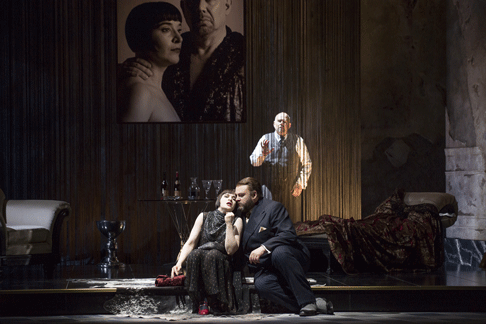 (l - r) Gun-Brit Barkmin as Bianca, Michael König as Guido Bardi and Alan Held as Simone (background) in A Florentine Tragedy
(l - r) Gun-Brit Barkmin as Bianca, Michael König as Guido Bardi and Alan Held as Simone (background) in A Florentine Tragedy
Only the enormous easy chair, in which Antonia is made to sit, did not ring true. The sight recalled to me Lily Tomlin’s Edith Ann, Laugh In’s bratty little girl in the oversize chair. Perhaps I have lived too long, but that imagery lingered in the back of my mind every time the doomed Antonia scrambled back onto her perch. Still, considering the immensely satisfying overall achievements, not least of which was terrific character development and interaction, I will concede that this was a brilliantly realized vision.
Sharing in this success, Costume Designer Brigitte Reiffenstuel has embraced the concept and devised enormously appealing attire, at times authentically period, at others mere flights of fancy. Jenny Cane’s lighting design was appropriately moody and mysterious, but straight forward when required. Sandra Horst’s choral direction was again a significant contribution. The Tales of Hoffmann was one of those cherishable experiences that not only immediately entertained and touched me, but also has given me reason for reflection days after.
Noted soprano Catherine Malfitano has turned her attention to directing in recent years, and a career’s worth of performing insights `has stood her in good stead as she tackled the double bill of A Florentine Tragedy and Gianni Schicchi. I find the former to be a complex work, musically stimulating, but dramatically flawed. The wife’s flirting and seduction of her lover which becomes more and more blatant in front of the cuckolded husband, is hard to bring off convincingly. For her part, Ms. Malfitano seems to have borrowed a bit of unhinged obsession from Paul Shrader’s The Comfort of Strangers. In that art film, an older couple conceal a whole lotta ‘kink’ as the seem to befriend a younger couple, but are actually stalking them. In the denouement the older man kills the younger man, which induces a bizarre sexual gratification to the older pair.
In the opera at hand, there were suggestions of that kind of menace from the start. Is this a recurring game the married couple plays out? Is it a three way, waiting to happen? Or is it on face value, a simple affair that goes wrong with no pre-meditation? Our director has raised these intriguing questions, but contents herself to stay on the fringes of any committed point of view. The three singers seemed game enough, but half-hearted gestures seemed stunted and faux-salacious. A pair that has done the illicit deed certainly should behave with more physical abandon and seething passion than Gun-Brit Barkmin (Bianca) andMichael König (Guido Bardi) were able to communicate.
Ms. Barkmin has a substantial soprano, and occasionally it soared incisively over the orchestra. Mr. König worked diligently and sang intelligently. But the two were not able to suggest any sexual chemistry, and their vocal presence seemed curiously muted. I just had the feeling that Zemlinksy’s writing for these roles was not an optimum match for their particular vocal gifts. Both have impressive credits, so I would look forward to hearing them again in roles that might offer more grateful pairings.
Alan Held, on the other hand, was up to every interpretive demand of the wronged husband Simone. This seasoned performer commands a plush bass-baritone of enormous fire power. Mr. Held is not only able to summon up fierce indignation for the confrontational outbursts, but he is also exceptionally capable of conveying controlled, simmering menace that is positively chills-inducing. The evening seems to have been intended to showcase his substantial gifts. After putting us through the Tragedy wringer, Alan effortlessly turned on a dime and won our hearts (and funny bones) with as roguishly enchanting a Schicchi as we could be desire.
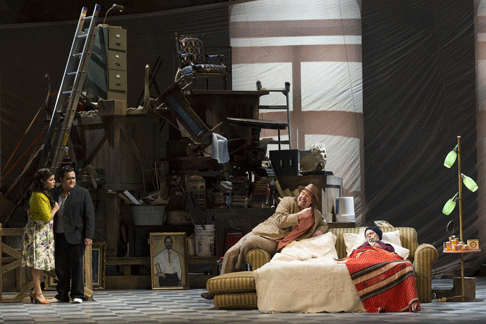 (l - r) Simone Osborne as Lauretta, René Barbera as Rinuccio and Alan Held as Gianni Schicchi in Gianni Schicchi
(l - r) Simone Osborne as Lauretta, René Barbera as Rinuccio and Alan Held as Gianni Schicchi in Gianni Schicchi
Sharing equal above-the-title(s) star billing, Sir Andrew Davis had a brilliant night conducting as well, first discovering the wealth of ripe orchestral detail with a rhapsodic reading of the Zemlinksy. Maestro Davis proved a sensitive and diligent collaborator with his soloists, surging the music with abandon whenever possible, but pulling back to provide a comfortable cushion of an accompaniment on others. And he did something with the Puccini I did not think possible. He made it seem new again, and together with COC’s outstanding orchestra, they invested the well-known chestnut with spontaneity, inevitability, and a real sense of delicious discovery.
Both productions shared some common design elements. Wilson Chin devised a suitably threatening environment for the tragedy. An upstage wall features a stage left opening fronted by a silvery bead curtain, and a stage right opening that serves as a cavernous black hole from which the suspicious husband make his portentous entrance. A huge photo of the man and wife looms over the indiscreet trysting. A scattering of art nouveau furniture defines the living room. A curious (and under used) rusting spiral staircase sits far right, ascending up into the flies. All of this murky vaguery was an effective complement to the plot twists and turns. Terese Wadden designed the efficient, formal costumes, and David Martin Jacques manages the tricky feat of balancing atmospheric shadowy effects with ample illumination of the performers’ faces.
Then for the comedy, the team makes a wholly successful about face and gives us a look that is all Italian sunlight, vivaciously colorful costumes, and a set that includes, among other things, a huge pile of furniture, appliances, and collectibles that are ready to be parceled out to Buoso’s survivors. Ms. Malfitano was in full command of the stagecraft here, and created lively business, logical blocking, and well-defined individual characters. She showed especial skill at creating unison reactions (such as everyone taking in and then holding their breath together) that were entertaining without ever wearing out their welcome. Another favorite bit: at curtain rise all the men are crowded around the television watching a soccer match, but blocking it from Buoso’s view. He is very much alive and interested in the game, until the men react with loud disappointment to the final score, which apparently displeases Buoso so much that. . .he drops dead. The poor corpse is on a sofa bed, in which he unceremoniously gets folded up to hide the body!
With the marvelous Alan Held to anchor the show, the rest of the cast rose to his level. Simone Osborne was a delectable Lauretta, imbuing her thrice-famous aria with individualized personality, superior legato, and melting tone. The ovation for “O mio babbino caro” was prolonged and well-deserved. René Barbera as Rinuccio was a perfect match for her, and he exuded cherubic charm and sang joyously with a radiantly youthful lyric tenor.
The scheming relatives were well-cast, led by Barbara Dever, whose commanding presence and imposing voice made for a very well drawn Zita. Gun-Brit Barkmin was the other hold-over from the first show, and she treated us to a spunky Nella. Donato di Stefano made the most of his every moment as the ‘eldest’ Simone; Adam Luther was a marvel of comic invention as the blithering Gherardo; Craig Irvine was a dynamically scheming Betto di Signa; Peter McGillivray, a befuddled Marco; Rihab Chaieb contributed a glam and sassy La Ciesca; and Gabriel Gough offered an energetic Gherardino.
By opera’s end when Rinuccio pulls down a cloth that had blocked the windows, revealing the skyline of Florence in all its glory, we were already basking in the glow of a perfectly calibrated Gianni Schicchi.
James Sohre
Semele
Cadmus/Somnus: Steven Humes; Athamas: Anthony Roth Costanzo; Semele: Jane Archibald; Ino/Juno: Allyson McHardy; Iris: Katherine Whyte; Jupiter: William Burden; Conductor: Rinaldo Alessandrini; Director and Set Design: Zhang Huan; Costume Design: Han Feng; Lighting Design: Wolfgang Goebbel; Lighting Design Recreation: Willem Laarman; Chorus Master: Sandra Horst
The Tales of Hoffmann
Muse/Nicklausse: Lauren Segal; Lindorf/Coppelius/Dr. Miracle/Dapertutto: John Relyea; Andres/Cochenille/Frantz/Pitichinaccio: Steven Cole; Luther: Valerian Ruminski; Nathanael: Christopher Enns; Hermann: Philippe Sly; Hoffmann: Russell Thomas; Spalanzani: Michael Barrett; Olympia: Andriana Chuchman; Antonia: Erin Wall; Crespel/Schlémil: Gregory Dahl; Voice of Antonia’s Mother: Ileana Montalbetti; Giulietta: Keri Alkema; Stella: Ambur Braid; Conductor: Johannes Debus; Director: Lee Blakeley; Set Design: Roni Toren; Costume Design: Brigitte Reiffenstuel; Lighting Design: Jenny Cane; Chorus Master: Sandra Horst
A Florentine Tragedy
Simone: Alan Held; Bianca: Gun-Brit Barkmin; Guido Bardi: Michael König; Conductor: Sir Andrew Davis; Director: Catherine Malfitano; Set Design: Wilson Chin; Costume Design: Terese Wadden; Lighting Design: David Martin Jacques
Gianni Schicchi
Gianni Schicchi: Alan Held; Lauretta: Simone Osborne; Zita: Barbara Dever; Rinuccio: René Barbera; Gherardo: Adam Luther; Nella: Gun-Brit Barkmin; Betto di Signa: Craig Irvine; Simone: Donato DiStefano; Marco: Peter McGillivray; La Ciesca: Rihab Chaieb; Gherardino: Gabriel Gough; Maestro Spinelloccio: Doug McNaughton; Ser Amantio di Nicolao: Philippe Sly; Pinellino: Neil Craighead; Guccio: Valerian Ruminski; Conductor: Sir Andrew Davis; Director: Catherine Malfitano; Set Design: Wilson Chin; Costume Design: Terese Wadden; Lighting Design: David Martin Jacques
image=http://www.operatoday.com/hoffmann417.png image_description=Russell Thomas as Hoffmann and Lauren Segal as The Muse/Nicklausse in The Tales of Hoffmann [Photo by Michael Cooper courtesy of the Canadian Opera Company] product=yes product_title=A Toronto Trilogy product_by= product_id=Above: Russell Thomas as Hoffmann and Lauren Segal as The Muse/Nicklausse in The Tales of HoffmannPhotos by Michael Cooper courtesy of the Canadian Opera Company